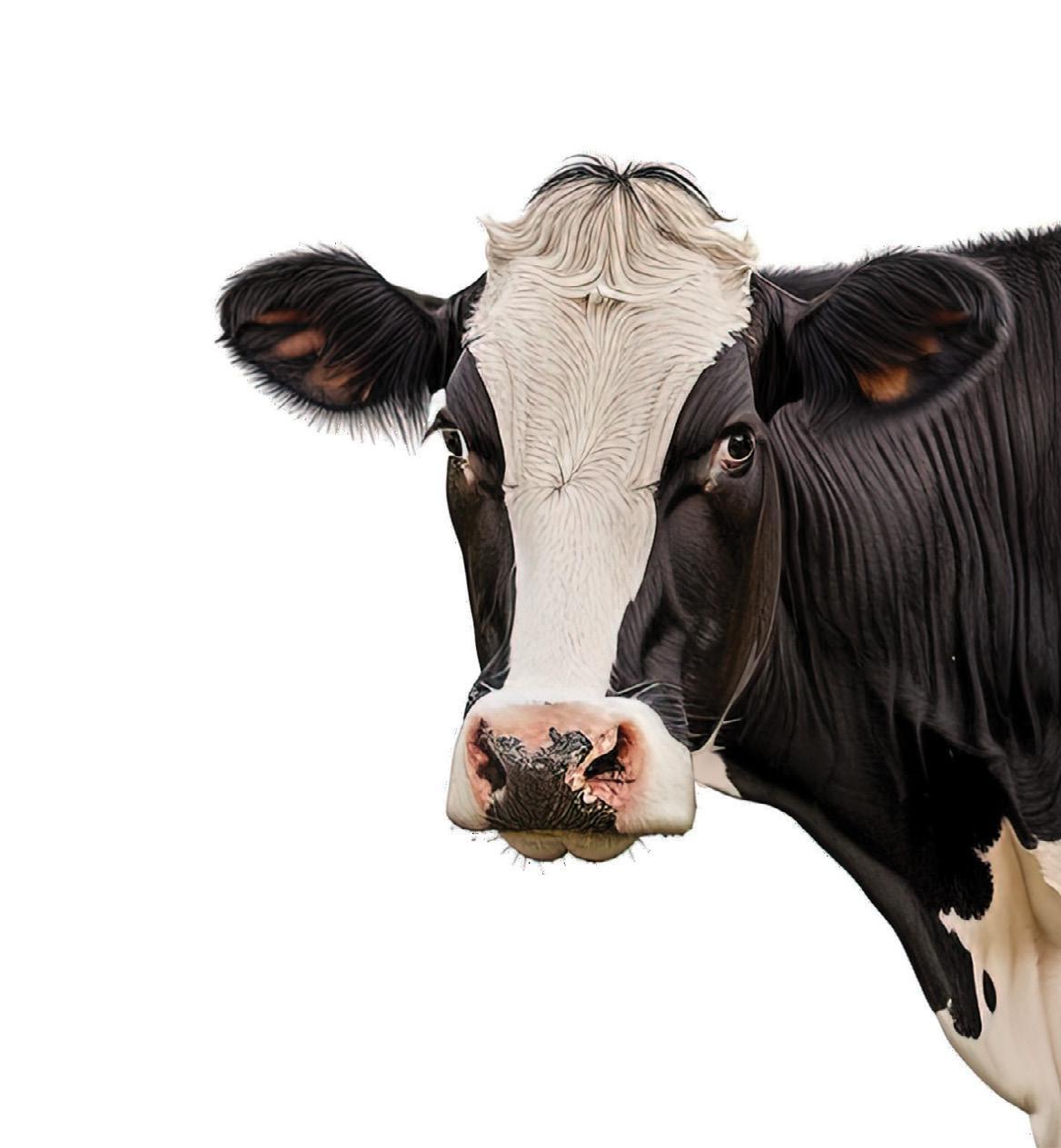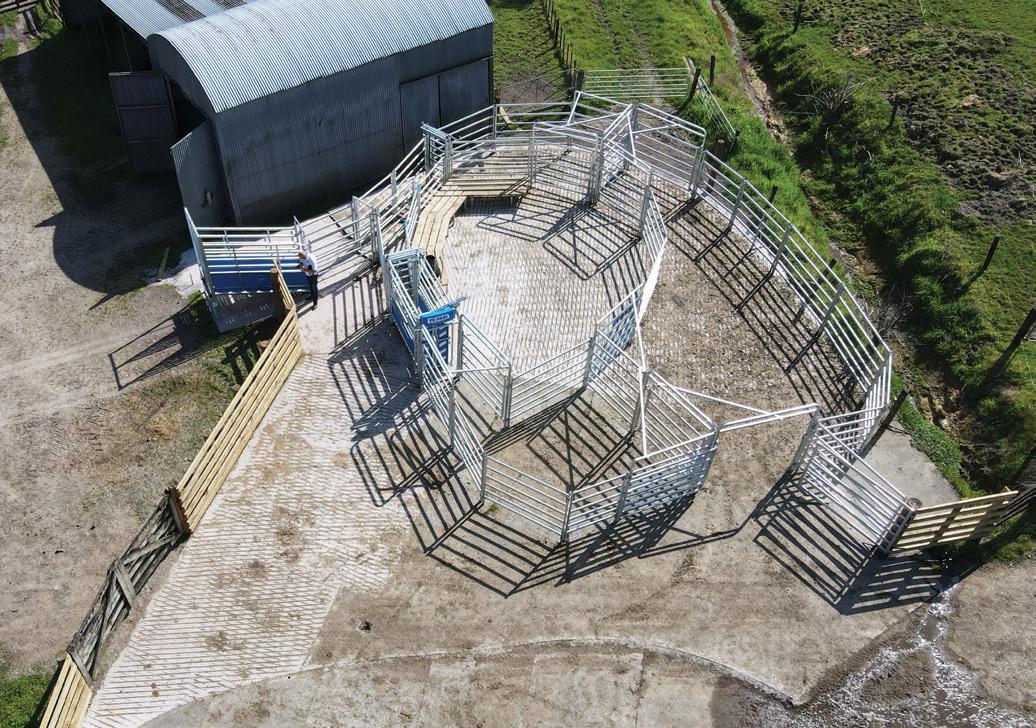




Usually striking without warning and spreading rapidly, the effects of Salmonella are devastating.


Protect your herd and family from Salmonella.
Salmonella can pass from your stock to the ones you care about most.
Vaccinate today to reduce the destructive impact of an outbreak*.
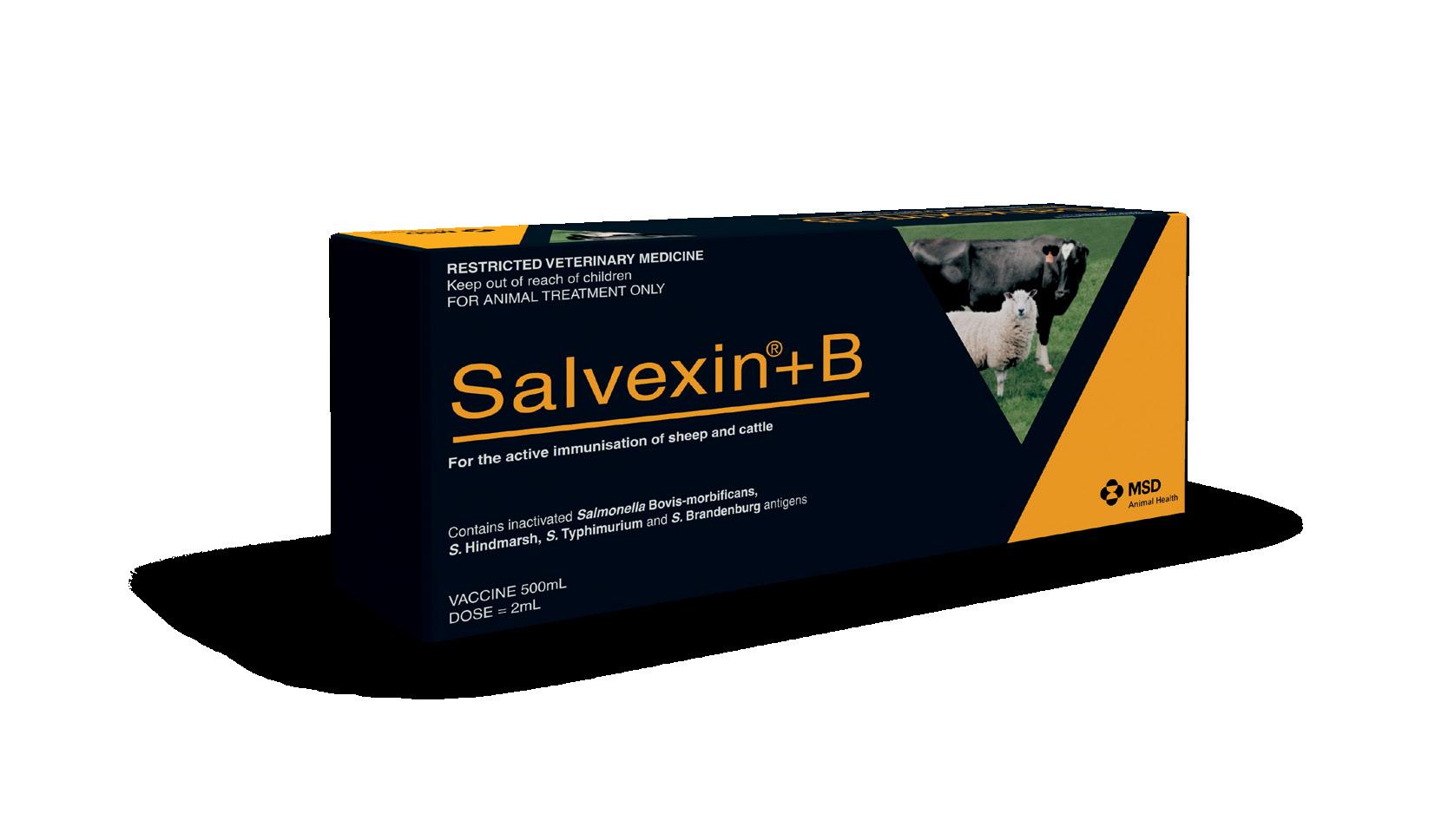
14 Strategy to Suit
As Kikuyu creeps more into the Bay of Plenty, farmers Andre and Natalie Meier have decided to embrace the summer grass. We go onfarm with them to find out how switching up their strategy is helping improve their performance.
24 Ginger’s Gene Edit Against BVD
An American calf bred with a gene-edited genome to be BVD resistant is due to have her first calf.
27 Blueprint for a Gene Technology Regulator
The Australian Office of the Gene Technology Regulator (OGTR) will be used as the blueprint for New Zealand’s gene regulator. How does it work?
30 Slick Gene Editing
LIC is dipping its toe in the water with gene editing, using their Slick gene offshore.
33 Glossary
34 Becoming Literate – The Language of Finance
37 No Taxing Surprises
38 What Good Financial Management Looks Like
40 In the Driving Seat
Anne Lee goes onfarm with the Andersons to dig into how they manage finances and track their progress.
47 Control




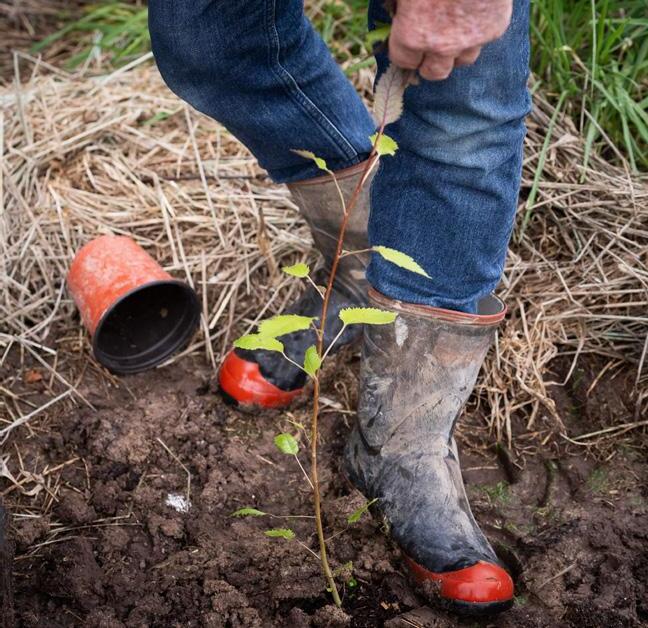

Financial literacy may not be the sexiest topic, but at the end of the day you read NZ Dairy Exporter because dairy is your business, and it’s our job to support you in this, so sexy or not, we have it covered (see page 32).
There is enormous wealth creation available in the dairy industry. From whatever walk of life you come from, a pathway is available for those who wish to do the mahi. But we still need to have the right doors open to us. Whether it’s an employer who encourages you to do more education to step up and be a manager, somebody to take the gamble and give you your first contract milking position, or a family that is ready to open the pathway to farm succession. Whatever your next step is on the dairy ladder, what underpins it all is sound financial literacy: knowing how to make a budget, stick to it, the discipline to spend wisely, knowing where to invest the surplus and how to make your money work for you.
Getting the timing right and a strong structural support around you is vital for that step up to the next rung so you don’t slip and crash to the ground.
In the same breath, we’ve tackled an update on insurance (page 52), what’s happening with premiums and what the future insurance space could look like. While it may not be one of the biggest expenses on your annual budget, it’s creeping up there, and the importance of having the right insurance is only truly obvious when you actually need it.

The other big topic we take a bite out of this issue is drench resistance (page 68) and what the danger is in store for the dairy industry. Lots of our calves are being grazed on calf paddocks or calf blocks which could be cultivating a worm factory. While there isn’t a lot of data known about how widespread drench resistance is in the cattle industry, the first step is testing more to ensure your drenching programme is working for you.
Testing our cows or calves and making sure they have a regular health programme is pretty standard for most farmers. But trying to get a farmer to a regular GP appointment for an annual – or “gasp” six-monthly – check-up can be as frustrating as untangling a reel quickly.
Why are farmers notoriously bad at going to the doctor? You’re happy to pay a costly life insurance or medical insurance invoice, but not so keen to go and do a maintenance check on your most important asset.
Make sure you prioritise your own health this summer. Book an appointment with your GP before you enjoy the Christmas break with the knowledge that the milk price forecast is strong and Santa should be bringing a lucrative 2025.
Meri Kirihimete
SHERYL HAITANA EDITOR sheryl@countrywidemedia.co.nz
What I’ve been doing
The working mum juggle. Between onfarm interviews, fun work events, being the referee to Miss Four and Miss Two, swimming lessons, pony lessons, planting the vege garden and getting on top of spring growth, I’ve managed to prioritise my exercise. My new midlife crisis has been to sign up for several half-marathon walks and wrangle some friends along with me. Maybe it’s just an excuse for a girls’ weekend, but so far it’s ensuring I get out most days for a walk which is great for the body and the mind. Shout out to my friend Tammy Deans who had the idea to sign up to the first one at Kinloch in August. Check out her article about what you need in your farm environment plan on page 98-99.

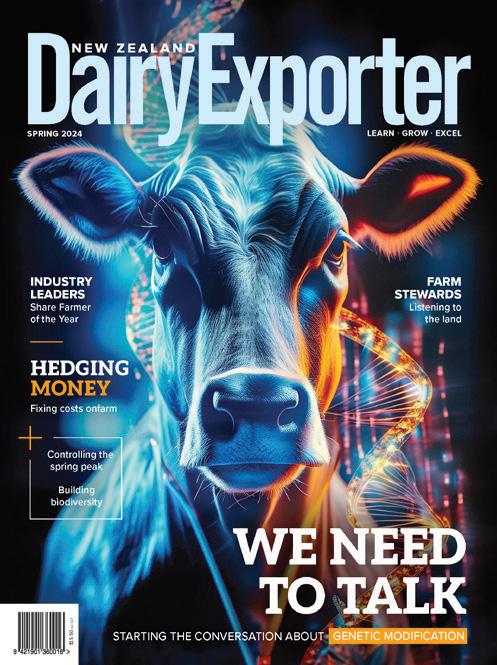

PUBLISHED BY
CountryWide Media
0800 224 782
PO Box 167, Tai Tapu 7645 country-wide.co.nz
MANAGING DIRECTOR
Sarah Perriam-Lampp
MANAGING EDITOR
Lucinda Diack
EDITOR
Sheryl Haitana
DEPUTY EDITOR
Anne Lee
ART DIRECTOR
Klaudia Krupa
SENIOR DESIGNER
Jo Hannam
CONTRIBUTORS
Dr Alice Armstrong, Trudi Ballantyne, Philippa Cameron, Heather Chalmers, Rosalind Crickett, Dawn Dalley, Kara Dawson, Tammy Deans, Andrea Dixon, Ginny Dodunski, Esther Donkersloot, Louise Gibson, Michelle Good, Rebecca Greaves, Holly Lee, Tony Leggett, Kylie Leonard, Chris Lewis, Winston Mason, Emma McCarthy, Dr Anneline Padayachee, Trish Rankin, Richard Reynolds, Kathryn Wright
ADVERTISING ENQUIRIES
Viv Montgomerie 027 370 6922 viv@countrywidemedia.co.nz
Donna Hirst 027 520 0466 donna@countrywidemedia.co.nz
David Paterson 027 289 2326 david@countrywidemedia.co.nz
SUBSCRIPTIONS
dairyexporter.co.nz/shop 0800 224 782 subs@countrywidemedia.co.nz
PRINTER Blue Star
Dairy Exporter is published quarterly ISSN 2230-2697 (Print) ISSN 2230-3057 (Online)
There is nothing quite like hearing from a country’s farmers on the way they are governed, financed (i.e. subsidies) and perceived by their population, to understand our own opportunities deeper.
I was excited to spend 10 days in Switzerland as part of the International Federation of Agricultural Journalists Congress as it’s the home of our largest supplier of New Zealand milk, Nestlé, who have been making loud signals on their expectations of our small, unsubsidised island nation to continue to supply them. As a critical journalist I used every opportunity for conversation to grasp an understanding of their thoughts on our proposed gene-editing regulation changes, and their definition of regenerative agriculture to better inform the discussion here at home.
The prequel to the story began in a trendy bar in London as young (under 40) expat Kiwis, working in multinational agriculture and food companies, came together to meet me for a drink and discuss how they are seeing the major trends from abroad. Quotes like “New Zealand has missed the regenerative boat,” and “NZ’s current political narrative of undoing environmental regulations is having a negative taint in our markets,” had me worried and intrigued but not surprised.
give high priority to free choice and mass demands for liberalisation. This becomes increasingly costly and detrimental to economic effectiveness, of which Switzerland is a classic case in point.
Our tour guide, Alex, was the communications director for the Swiss Farmers’ Union who shared the hot topic among farmers that Switzerland’s traditional exercises of direct democracy in action called their initiative rights. It’s a public petition system where 100,000 signed petitions can enact a national referendum on a topic. The current referendum was on increased protected area for biodiversity which its opponents say was an “extreme and inefficient” way to protect biodiversity calling for farmers to lock up 30% of their land for protected habitats. Those in favour of the initiative, such as BirdLife who we heard from at the congress, said the open pastures policy of the government paying farmers subsidies to keep farmland in the Alps clear from encroaching forests was a way for their food marketers and tourism operators to maintain the Heidi-like scene in the mountains. This is the third referendum they have had in 12 months, stopping the nation every quarter. The next one in line is to ban animal agriculture from Switzerland.
This publication uses vegetable-based inks and environmentally responsible paper produced from Forest Stewardship Council® (FSC®) certified, Mixed Source pulp from Responsible Sources.
We touched down in the cosmopolitan city of Geneva, home to the United Nations but also a transit population, where half the workers live in France, as it is cheaper to travel across the border to work each day. This was my first glimpse of the desire to earn and invest in Swiss francs, the most stable currency in the world and a safe haven of international investment. In the academic literature of “social licence” they explain how higher levels of economic security and an increase in standards of living from a post-industrial knowledge society such as Switzerland leads to a growing emphasis on the values of its people who
So it’s no surprise they have the Agricultural Information Service, funded by 80 organisations from the agriculture and food industry, whose sole job is to educate schools and the general public about farming. Our trip to Agroscope (the NZ equivalent of AgResearch) was an informative tour of how the environment they farm in is forcing their agriculture research and development. They research management solutions for a future of reduced chemical use and greenhouse gas emissions. I asked one of the principal scientists if they were preparing for any changes to their restriction of gene-editing technologies. He said that would be a long way off for the EU as their sole focus for carbon removal and less chemicals

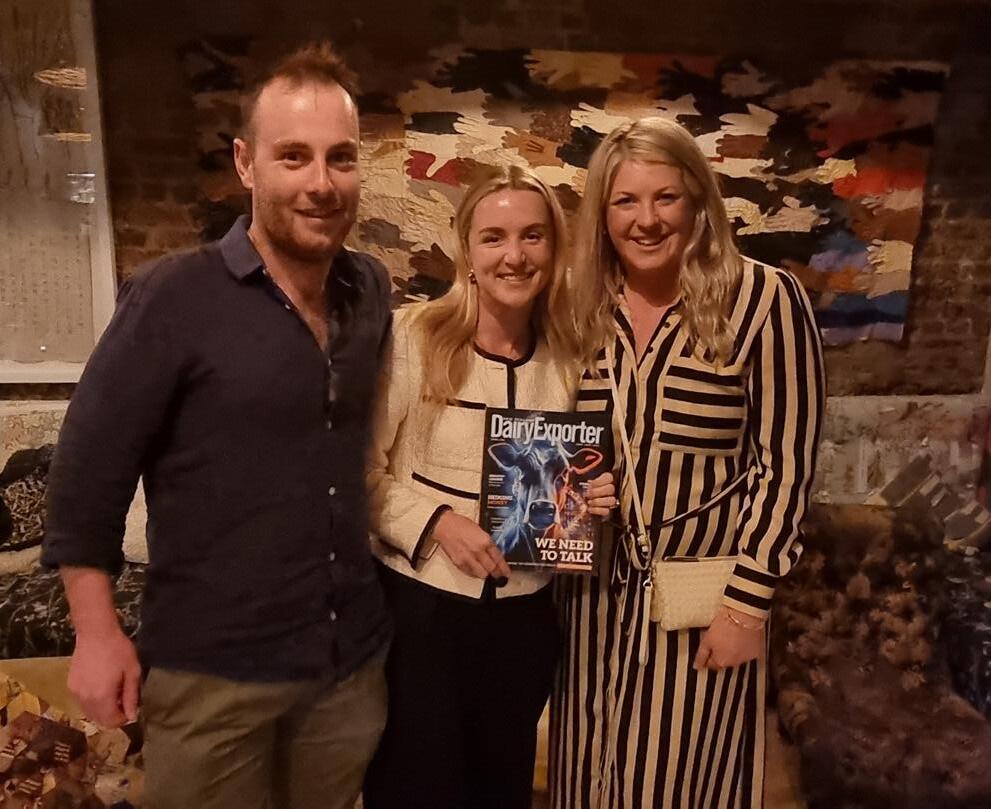
is on soil health – remember there aren’t incentives to plant out their hill country in trees! We visited Nestlé’s Research and Development in Lausanne to meet with Jeroen Dijkman, the founding head of the Nestlé Institute of Agricultural Sciences. They explained how dairy is 31% of their carbon footprint and that is why they are coming up with their own agronomic solutions to put the science behind defining regenerative agriculture to underpin achieving their procurement targets of sourcing 50% regenerative milk by 2030 and 100% by 2050. They are validating solutions on their test farms such as the Nestlé-funded trial in Taranaki. We were shown through their newly opened laboratory where they had gas chambers to mimic the anaerobic fermentation of rumen microbiomes with different feeds and the enteric methane produced – no GMO or gene-edited feeds are being trialled. We were shown their educational regenerative area about the importance of hedgerows for beneficial insects and the significance of soil cover and porosity for moisture retention. I asked Jeroen about the current discussion on NZ’s gene-editing regulation and received a careful reply: “There will always be a market for New Zealand dairy.” Read into that what you will.
In June 2024, Nestlé was a foundational member of AgroImpact where they provide participating farms with climate premiums calculated based on their level of carbon reduction. We visited a farmer who was a part of the
project and through translation I was able to discover that his carbon storage capacity was measured by a ruler and he didn’t need to pay the premium back when he released carbon into the atmosphere when he lifted the “lowcarbon” sugar beet for Nestlé. They looked at me sideways as to why it would be an individual farmer’s responsibility when you are helping Switzerland “inset” its carbon from the airlines in their soil. Then I got to ask my question to former Nestlé CEO, Mark Schneider:
“I represent New Zealand dairy farmers here and Nestlé is one of our largest suppliers. You talk a lot about the transition (to regenerative) and with New Zealand being in the bottom three in the world for agriculture subsidies, and it doesn’t look like that will change, what is the role of Nestlé to fund that transition [such as through premium payments] or would you see that as an expectation on our government to fund this through subsidies?”
He replied, “What you will see in other countries is a healthy mix. We are not shying away from carbon initiatives or taking the lead, but it’s a systemic problem across the value chain and we share responsibility. Especially in countries where agriculture is large, the government has invested interest like here with dairy in Switzerland you see us step up, but also the government, so everyone has skin in the game.” Switzerland is in the top three countries in the world for agriculture subsidies
to the tune of over $3 billion per year. According to OECD data, subsidies in the EU account for less than 20% of farm income. In Switzerland, the average is 62.7% with 543,000 dairy cows. Even though this is the home of our largest supplier’s global headquarters, they are sourcing, producing and selling Nestlé consumer goods within their “gene-editing” friendly markets such as the United States. So Fonterra’s new strategy to strengthen their ingredients business model of a commodity product tells me that gene editing and regenerative are now the ticket to remain in the commodity game.
SARAH PERRIAM-LAMPP CEO & EDITOR-IN-CHIEF sarah@countrywidemedia.co.nz

Charity Golf Events
October 2024 – February 2025
Play a round and raise money for your local Rural Support Trust.
• November 15 – Whakatāne
• February 21 – Morrinsville rural-support.org.nz
Milking It Live Webinar
November 6 2024
Get to know the stars of the Milking It project, Addie and Kip Nolan, and hear how they’ve learned to take control of their farm’s profitability with the help of CMK Chartered Accountants, Figured and Dairy Women’s Network through their podcast series on Rural Exchange. dwn.org.nz
Owl Farm November Focus Day
November 21 2024
A range of seasonally relevant topics. owlfarm.nz
Managing Risk in Sharefarming
November 2024
Federated Farmers events are being held throughout the country. Learn how to navigate business and individual risks for both sharefarmers and farm owners. A guide through contractual changes, farm assessments, and how to build and maintain strong, enduring working relationships. fedfarm.org.nz
Pasture Summit Fieldays
November 2024
Hosted by farmers for farmers, with input from dairy sector specialists, sharing ideas and developments on achieving profitable food production from grass.
• Waikato – November 13
Dan and Gina Duncan onfarm in Te Awamutu
• Canterbury – November 27
Leighton and Hayley Parker onfarm in Ashburton pasturesummit.co.nz
Primary ITO Courses November–December 2024
Primary ITO courses on Milk Harvesting, Livestock Feed Supply and Demand, Operating Dairy Effluent Management Systems. primaryito.ac.nz
Lameness Management Workshops November 2024 – January 2025
The workshops are designed to give students an overview of issues relating to lameness management and introduce them to the 5-step trimming process according to the 5-Step Method. dairyhoofcareinstitute.ac.nz
NZ Dairy Expo
February 11–12 2025
The Dairy Expo at Matamata will feature more than 100 businesses from across the dairy industry, to showcase the latest innovations in technology, equipment, and services tailored to dairy farming only. nzdairyexpo.co.nz

AGMARDT’s The Common Ground
Interested in industry leadership into the future with the challenges we face? You’ll enjoy The Common Ground podcast hosted by Sarah Perriam-Lampp in conjunction with AGMARDT and KPMG’s report Are industry good bodies good for industry? The podcast series goes deep into the concept of The Common Ground with farmers and industry leaders past and present.
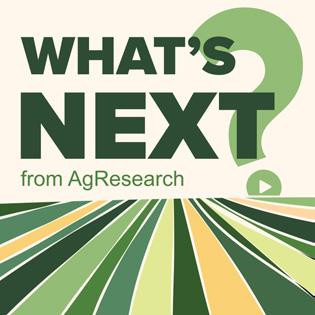
AgResearch’s What’s Next?
AgResearch is tasked with helping our pastoral agriculture sector face its challenges headon so in their podcast series, What’s Next? they explore the big questions facing New Zealand agriculture. Hosted by veteran radio broadcaster Eryn Breading, she talks to experts about greenhouse gas mitigation, water quality, land-use change and its impacts, biosecurity, and the opportunities that new technologies offer for food and fibre producers. All working towards growing our economy and becoming more sustainable.
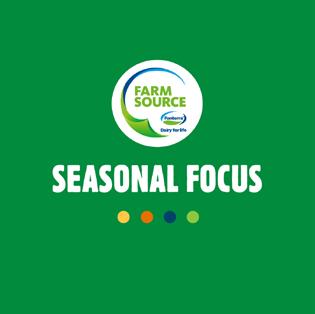
Farm Source’s Seasonal Focus
With practical onfarm advice from Farm Source’s suppliers and On-Farm Excellence team delivered to your headphones, Seasonal Focus includes episode interviews, as well as highly recommended on-demand webinars ensuring you have all the information you need at your fingertips, when you need it. Whether it’s understanding how to read your Farm Insights Report or calf rearing tips, it’s a great podcast series to get your farm team to start listening to.






The NZ Dairy Exporter is celebrating its centenary in 2025. The NZ Dairy Exporter was the bible to dairy farmers across the country as the dairy industry formed and grew. As we count down to this celebration, enjoy some excerpts from one of our earliest editions.




Properly cleaned udders, thorough sterilisation of milk and cream cans, and adequate cooking are three things essential to a high-quality milk or cream. In the course of an interesting address at the National Dairy Association’s conference, Mr. P.O. Veale, scientist at Hawera laboratory, dealt fully with these three important factors. “In the past, too much attention has been paid to quantity, and insufficient to the more important question of quality.”
Our last review indicated the board’s intention to make a further payment in the second butter pool when the last butter within that pool had been shipped. This having been done, a payment aggregating £350,000 was made on July 31. This payment brings the advances on the second pool to the following figures:
• Finest grade … 1s. 2.16d
• First grade … 1s 1.66d
• Second grade …1s 0.66d
The total quantity of butter handled in this pool amounted to 1,575,920 boxes.
“I have just received a bit of information from a friend of mine in Walsall, England, concerning New Zealand butter which I think will come as a surprise to a large number of dairy farmers. My friend says ‘I am surprised at the treatment meted out to the New Zealand producers by the British butter merchants by giving such a low price to the New Zealand farmers, yet charging a high price to the consumer’... But until that day comes we will have to spank old ‘Daisy’ a little harder, drink the skim-milk, and give the butter-fat to others.” Yours L.M. Nicklin.
nue identi fying your best genetics w i t h G e ne Ma rk
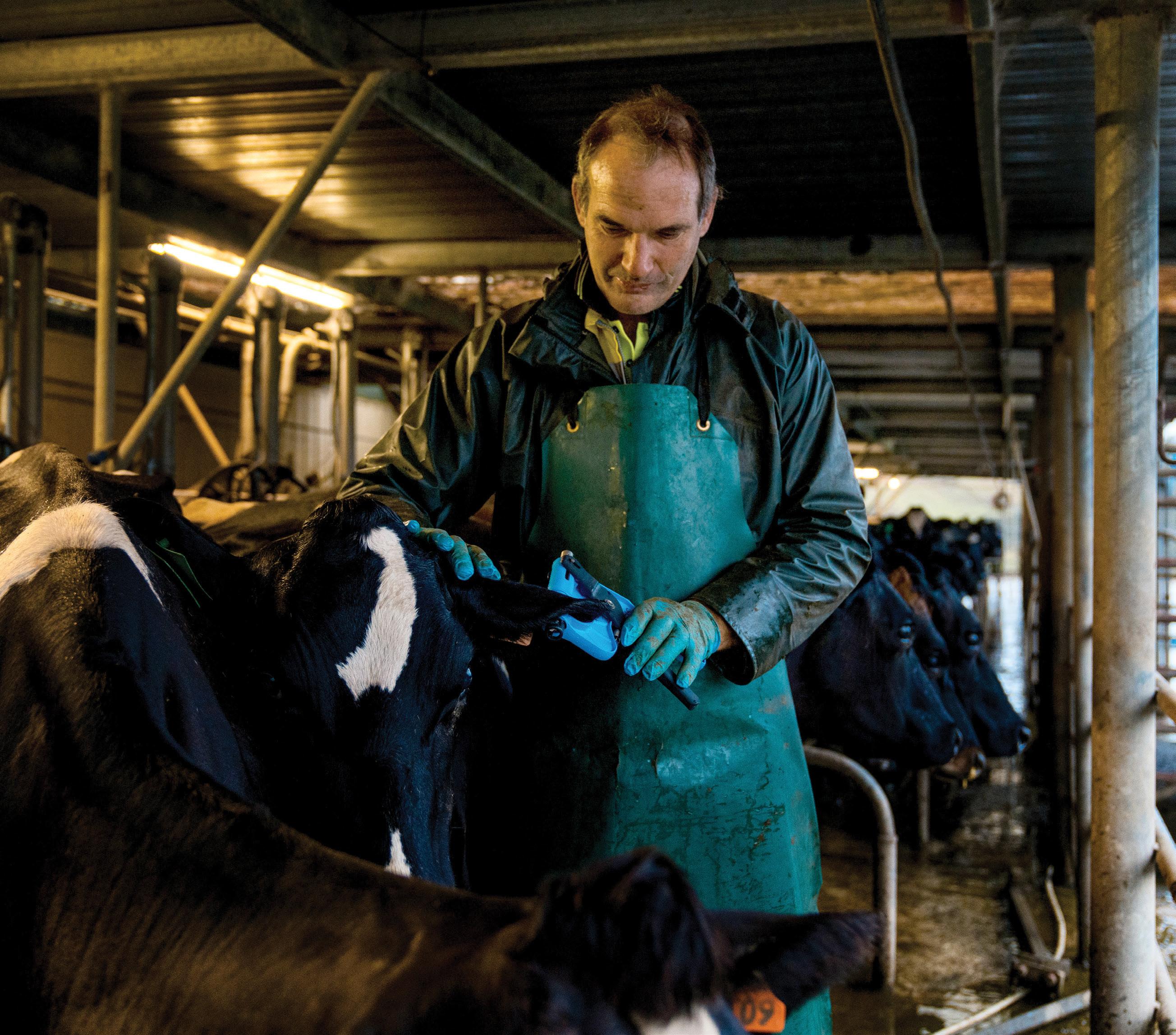
You’ve always tried to breed from your best, and you already know the power of genomics. Through our new GeneMark® Genomic service you can continue to identify superior genetics with increased reliability at a younger age.
GeneMark Genomics takes the guesswork out of matching calves to parents while accessing genomic data, adding precision to your animals’ breeding values at a more cost-effective price.
All of which helps you fast-track your herd’s genetic gain.
So continue breeding from your best and building your confidence with GeneMark Genomics.
Talk to your Agri Manager today or visit lic.co.nz/genemark
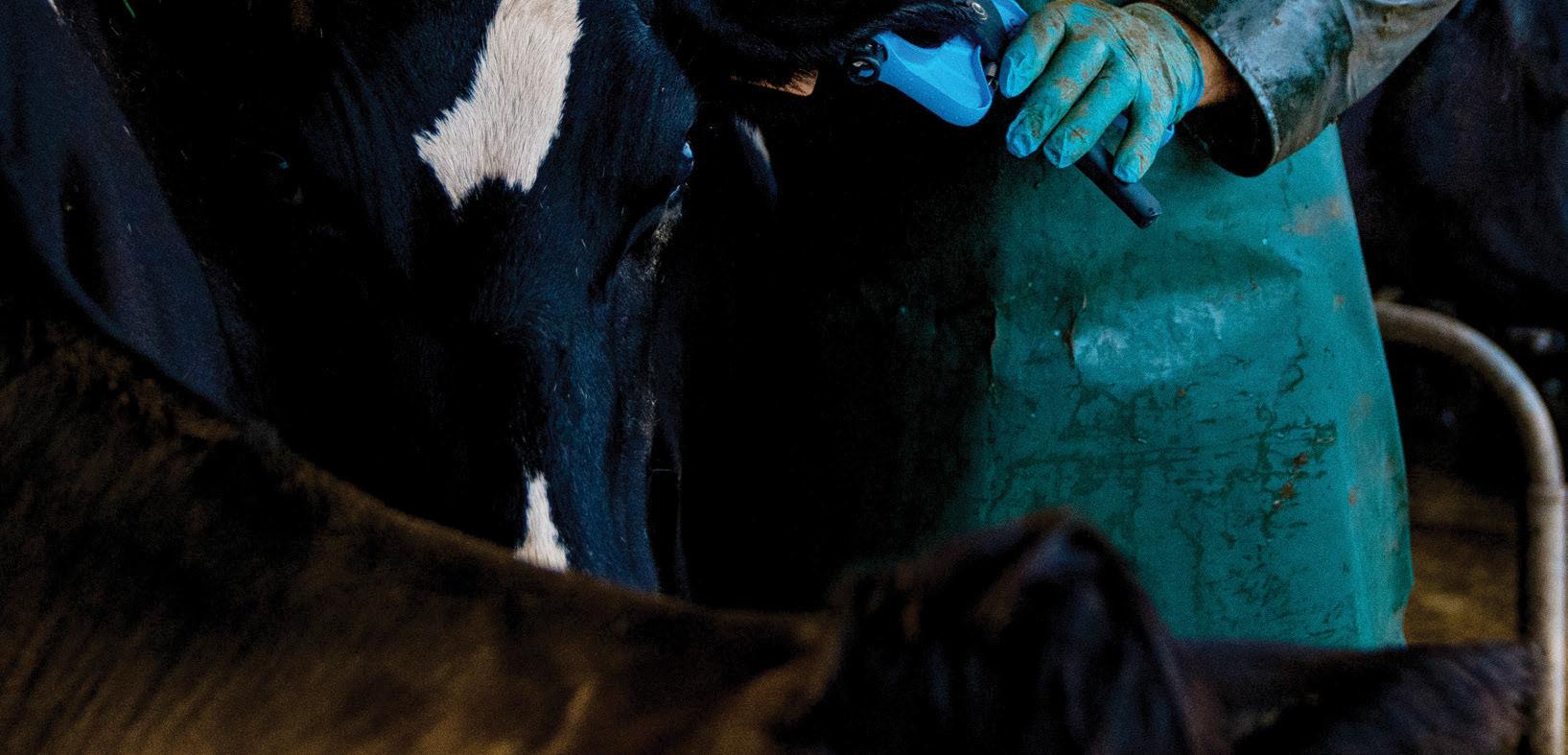
There's always room for improvement
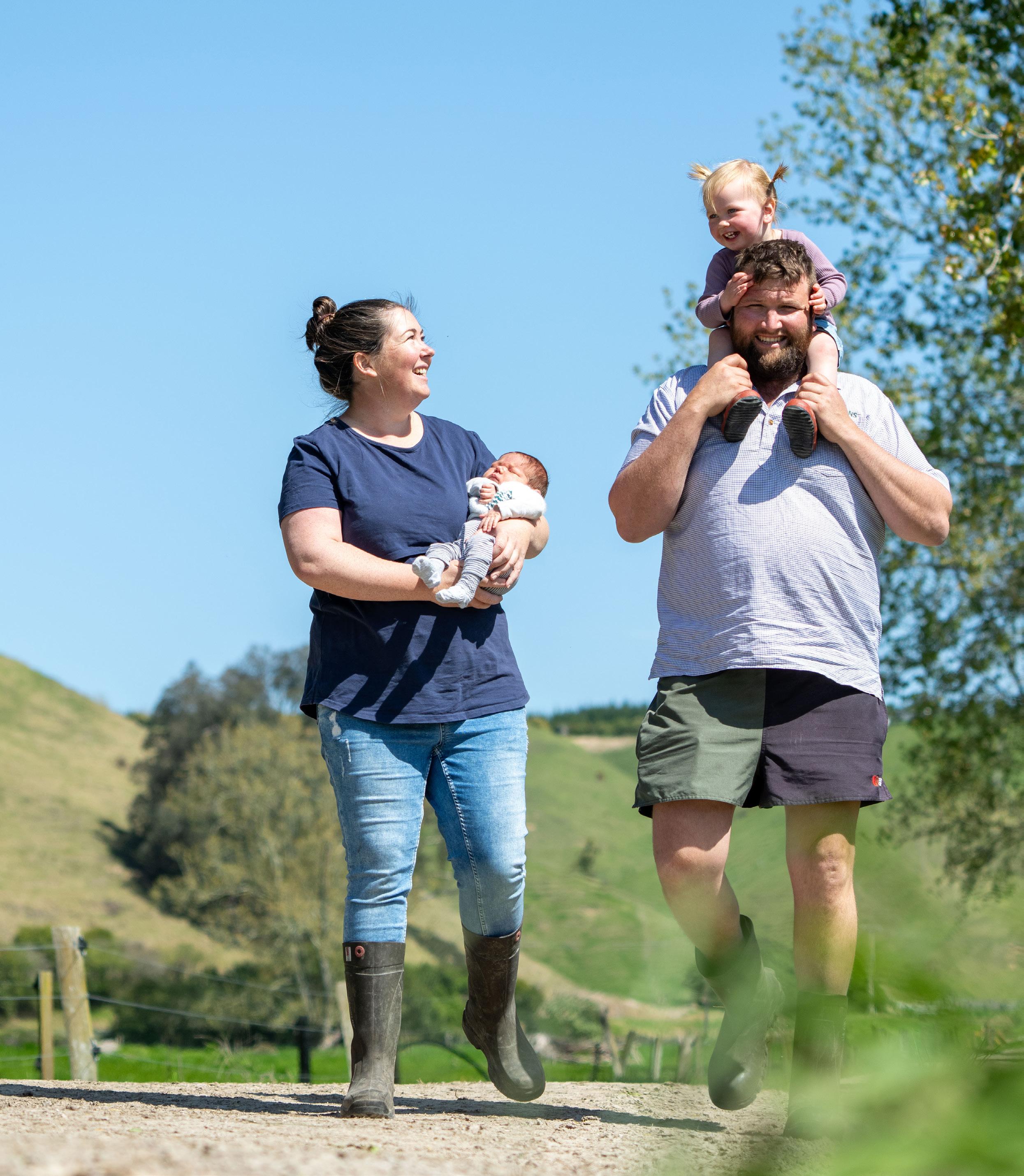

As the creeping Kikuyu plant smothers more pastoral land in the North Island, the decision for farmers is to either fight the Kikuyu or embrace it. Bay of Plenty dairy farmers Andre and Natalie Meier have embraced the summer grass, altered their system to once-a-day and are enjoying the productivity wins.
Words SHERYL HAITANA Photos EMMA MCCARTHY
Embracing Kikuyu and switching to once-a-day (OAD) has led to better results for Andre and Natalie.
The couple are equity partners in Natalie’s family business, which includes two dairy platforms, a significant kiwifruit block and a quarry. Four generations of Camerons have farmed at Ōtamarākau since 1930, with land use swaying between sheep and beef, dairy and horticulture.
The farm Andre and Natalie are currently living on had been sold by Natalie’s grandparents Matt and Ethel Cameron and purchased again by Natalie’s parents, Bruce and Gill Cameron, 12 years ago.
The 118ha effective dairy farm is located in the valley, five minutes from the beach, with 90% of the milking platform on flats next to the Waitahanui stream, 70ha of which is irrigated.
Drains weave through the very low lying paddocks, which do have a tendency to flood in winter.
There is another 10ha of grazing across the road on steep country with 42ha retired and planted out in pine trees.
When Natalie and Andre bought into the family business five years ago, it was struggling to fight off Kikuyu on a large proportion of the dairy platform. The business was spending thousands of dollars on spraying paddocks out annually, sowing ryegrass, only to see the Kikuyu take back hold within two years, Natalie says.
The herd was also struggling with the system, producing just 280kg MS/cow with a poor reproductive performance of 55% six-week in-calf rate and an almost 30% not-in-calf rate.
“That was for consecutive seasons; we were pouring in a heap of feed, mainly because of the wet weather events,” Andre says. “We were having to sell cows for low margins as an empty cow then having to go out and buy in-calf cows to replace them.”
It wasn’t great on the cashflow or for the future of their herd.
The company purchased another dairy farm at Otakiri one year after Andre and Natalie had bought in as equity partners. After a couple of tough wet seasons, there was poor reproductive performance and production across both herds. It was evident that things needed to change.
Andre and Natalie did their research and got some experts in to see if running a Northland-style system to embrace the Kikuyu at the Ōtamarākau farm was a good idea.
There is benefit to fighting the Kikuyu when it is minimal and is at a manageable state, but they were just pouring money down the drain trying to fight it on this farm, Natalie says.
“It is so costly to try and get rid of it, and frustrating for it to just grow back.”
On the family’s drystock platform land there were paddocks which had been grown in maize grain for years and had been constantly sprayed with glyphosate.
“We put them back into ryegrass and in just two years the Kikuyu was dominant,” Andre says.
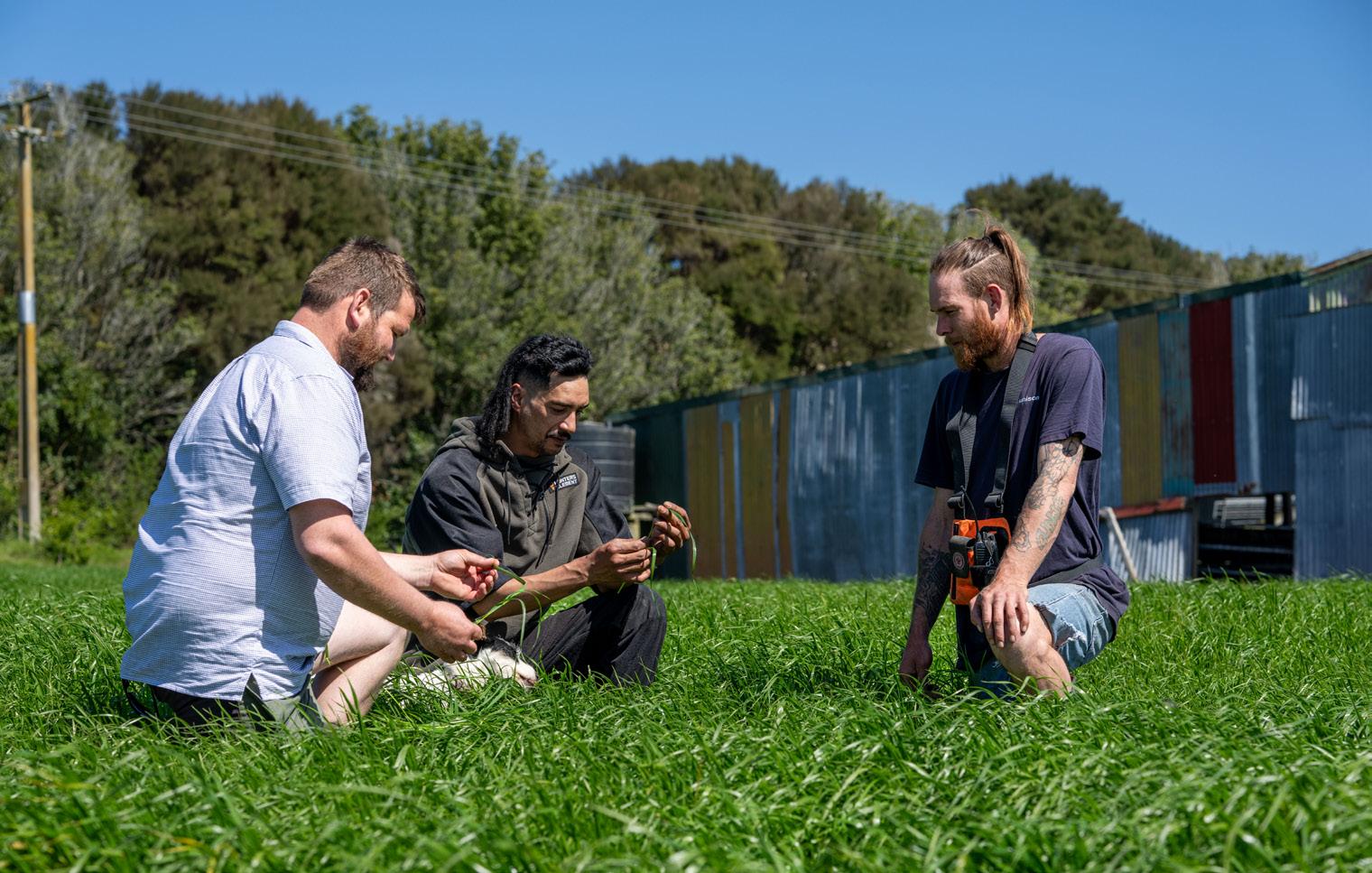
They now run the Northland Dairy Development Trust system with an eightweek regrassing programme over the whole farm.
Kim Robinson from AgFirst has been extremely helpful to the couple and has guided them through it.
“She’s jumped on Zoom calls with us and is on the other end of the phone to answer our questions,” Andre says. “Running this system has definitely turned the farm around; the mulching has been the main thing. We used to undersow every year, but since we’ve brought the mulching in, it resets the whole paddock and takes away any of the competition from that Kikuyu to the new grass.”
Every paddock on the flats gets mulched with a Y-Flail mulcher trying to disturb the Kikuyu stolon as much as possible.
“We’ve modified it a bit ourselves and we drill extra holes to allow us to get it mulching at ground level to disturb the Kikuyu. The first season was slow, it was very wet, but this year the tractor was about 5km/h faster through the paddocks. We try to do everything in-house, and use our own cultivation gear. I used to be an agricultural contractor before I went dairy farming.”
They follow straight in behind the mulcher with the undersow drill to sow Italian ryegrass.
“We buy non treated, the cheapest seed we can buy.”
They plant 15ha of chicory every year which the cows rotate on a 21-day round
in summer. The chicory paddocks are then sowed with a hybrid ryegrass which lasts about three years.
“We don’t put perennials in because after three years the Kikuyu smothers it anyway. You’re just throwing money down the drain so you’re better off having the hybrids which grow faster and have a better ME,” he says.
The family always grew maize on the runoff block as in around November the farm would reach a feed deficit so the maize would supplement this, however, they wouldn’t see much production change in the cows.
“This is where Kim educated us that maize and Kikuyu are both high in carbohydrate, therefore, take the maize out and introduce chicory for protein and you will see results … which we have,” Andre continues.
LEFT Andre, Lindsay and Jamie checking out the pasture. BELOW The ryegrass hybrid is what gets them through winter until the Kikuyu takes over again.
“Kikuyu is very efficient at using water so if the pasture cover gets too high we turn the irrigation off. But if we do get into a tight spot you can turn the irrigation on and within half a week you’re away again.
“We realised we were turning our irrigation on too early some years after drilling new seed and this would encourage the Kikuyu to bolt, smothering the new seed we had planted. If they start running at a surplus they will either shut up the former chicory paddocks which are mostly ryegrass for silage, or mulch the Kikuyu paddocks down to 1400 residual to reset them.
“Irrigation is an extremely cheap way of growing feed. When you can grow your grass it’s a hell of a lot cheaper. We try and use that to as much benefit as we can. Running the irrigation for a month is equivalent to about 4t of palm kernel.”
The Ōtamarākau farm has 22ha on a pivot, with the rest on laterals. Grieve Road has 76ha of the platform irrigated by pivot and laterals. That farm also has 35ha that gets whey from Fonterra’s Edgecumbe factory.
“With that plus the effluent area it’s almost 100% irrigated.”


‘Maize and Kikuyu are both high in carbohydrate, therefore, take the maize out and introduce chicory for protein and you will see results … which we have.’
The next part of the new strategy for the dairy units was looking at going OAD full-time.
“When pulling the farms apart, the thing we kept coming back to was the poor repro results; we knew if we could improve this area then everything else will positively follow in the same direction – which kept bringing us back to OAD,” Natalie says.
With well-fed cows who are under less stress, they have better condition, leading to better reproduction results and a tighter calving spread would lead to more milk in the vat.
“We knew it wouldn’t change overnight, but it was a long-term goal for future benefits to the cows and business.”
Vets and industry professionals had told the couple the only farms in the area that rode the really wet season through were the OAD farms or the really high input farms – and it cost the high input farms a lot.
“The OAD farms had a bit of decrease, but the cows didn’t lose weight and it didn’t impact their following season.”
Andre had experience of switching a farm from twicea-day (TAD) to OAD milking when he was farm manager for Ao Marama Farms further up the road at Pongakawa.
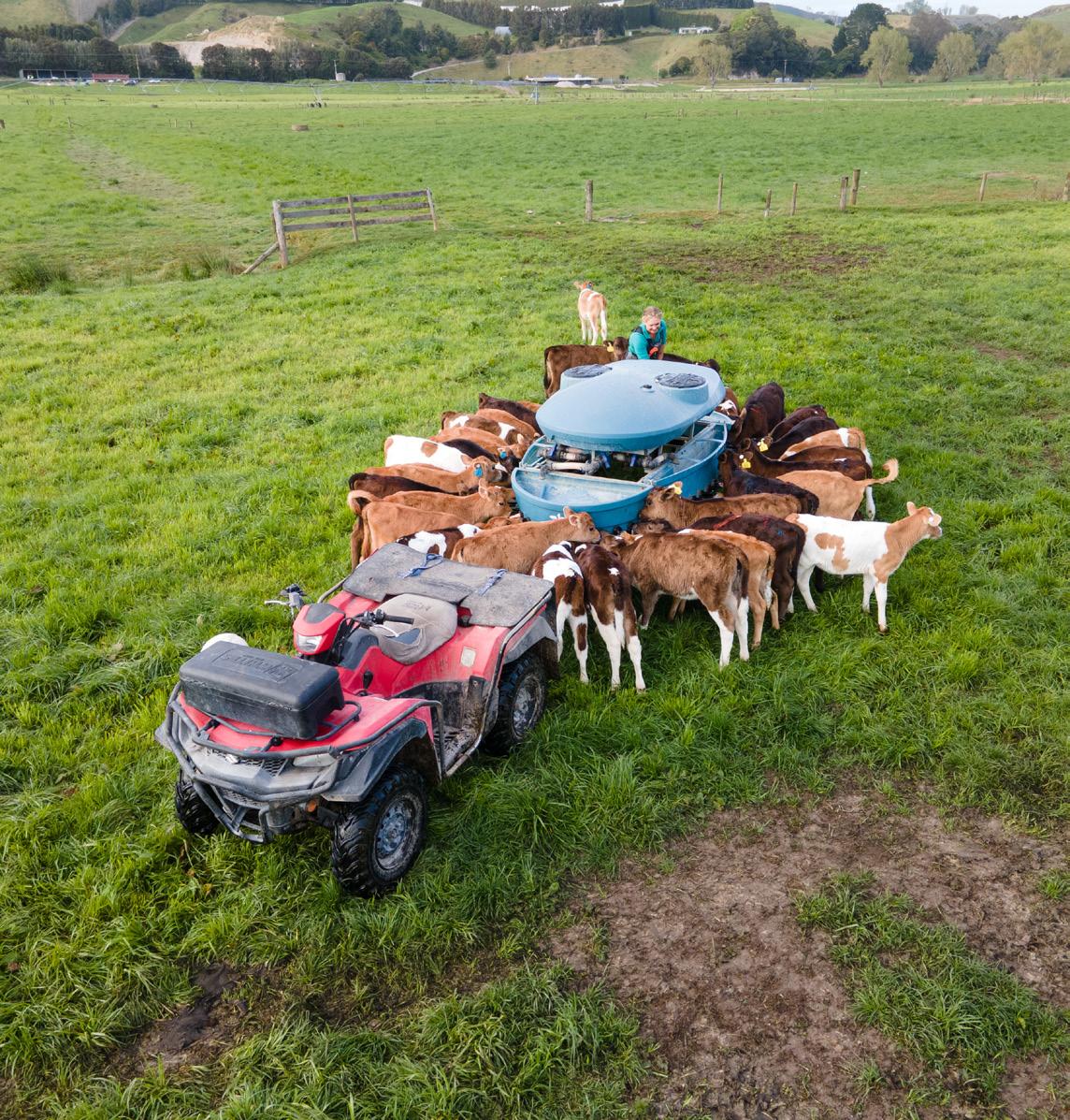
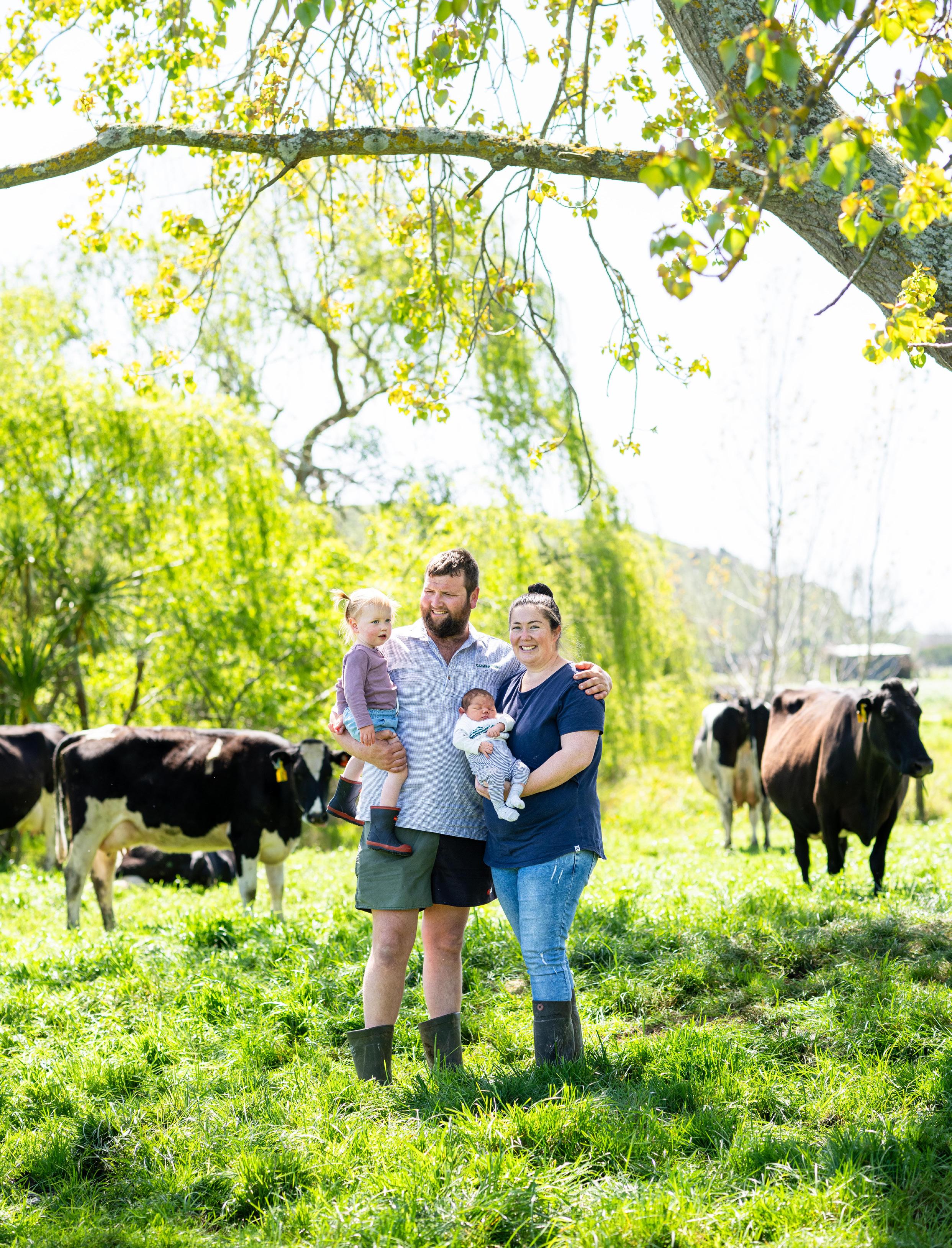
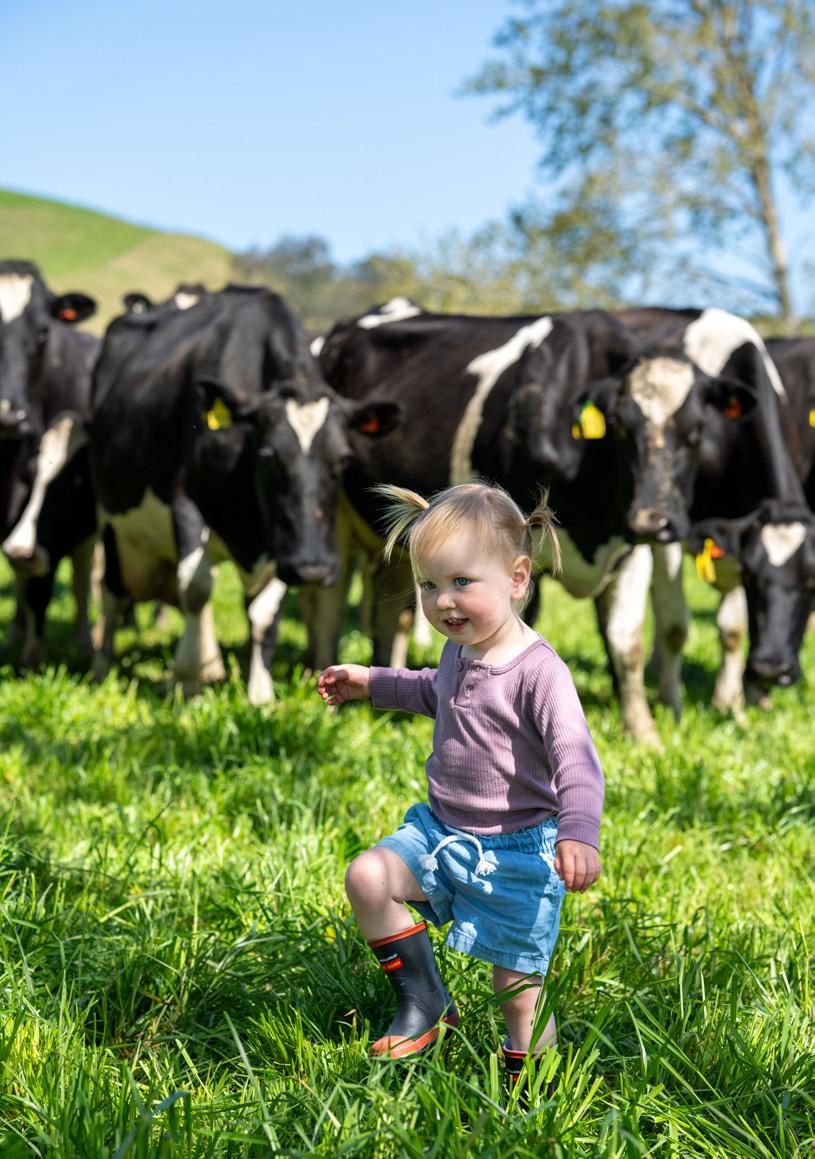
“I knew the benefits of going OAD. We went to OAD on my last farm because we had a staff injury and two junior staff left, and so we were left with me and one other milking 800 cows. We made the call to go OAD and we made it through the season just the two of us.
“We saw the results instantly, we had better mating results, we had surplus in-calf cows which gave us the opportunity to cull the poorer cows. That farm has stuck to OAD and they’ve smashed my TAD record, they are doing nearly 360kg MS/cow on all grass and steep country.”
Going OAD can be viewed negatively by banks, but the couple were surprised at the positive comments and support they’ve had from the banking sector.
It can be a really good option for poor-performing farms on less-productive land, Andre says.
While the Otakiri farm doesn’t have Kikuyu, the poor reproductive performance was reason to go OAD there as well.
They are now in their second season of milking OAD across the two farms. The cows’ production went up in the first season of milking OAD from 280kg MS/cow to 326kg MS/cow and their mating results improved dramatically.
“This last season, our mating results were a 67% six-week in-calf rate, 91% three-week submission rate – with no intervention – and a 13% not-in-calf rate.”
• Equity shareholders Bruce and Gill Cameron, Anna and Rikki James, Natalie and Andre Meier
• Location Ōtamarākau
Two Dairy Units, 118ha and 144ha effective
• Drystock/support block 170ha
• Kiwifruit 70ha (50% green, 50% gold) 100ha pine trees
• Cameron Quarry
ŌTAMARĀKAU VALLEY FARM
• Area 160ha, 118ha effective
• Irrigation 70ha
• Farm Dairy 41-aside herringbone, half ACRs, CowManager
• Cows 340 Friesians
• 2024–25 Target production 326kg MS/cow
• System DairyNZ System 3, OAD, feedpad
• Pasture and crop harvested onfarm 8t DM/ha
• Total feed eaten 15t DM/ha
• Crops 15ha chicory
• Supplement 170kg DM kiwifruit, 150kg DM PKE
• Assistant manager Lindsay Williams
• Herd manager Jamie Fryer
Mating Results from going OAD TAD OAD
• Six-week in-calf rate 55% 67%
• Not-in-calf rate 26% 13%
GRIEVE ROAD, OTAKIRI
• Area 148ha, 144ha effective
• Irrigation 90ha
• Farm Dairy 20-aside double-up, protract, ACRs, CowManager
• Cows 440, 60% Friesians, 40% Jerseys
• System DairyNZ System 2, OAD, 500-cow Herd Home
• Pasture harvested 12.5t DM
• Supplement 76t DM of kiwifruit
• Assistant manager Rāhoroi Tutua Bennett,
• Herd manager Toby Hall Te Kiri
Mating Results from going OAD TAD OAD
• Six-week in-calf rate 55% 76%
• Not-in-calf rate 28% 11%
Cost savings from going OAD
• Farm Dairy Electricity – $10,000
• Breeding/Herd – $12,000
Animal Health – $30,000
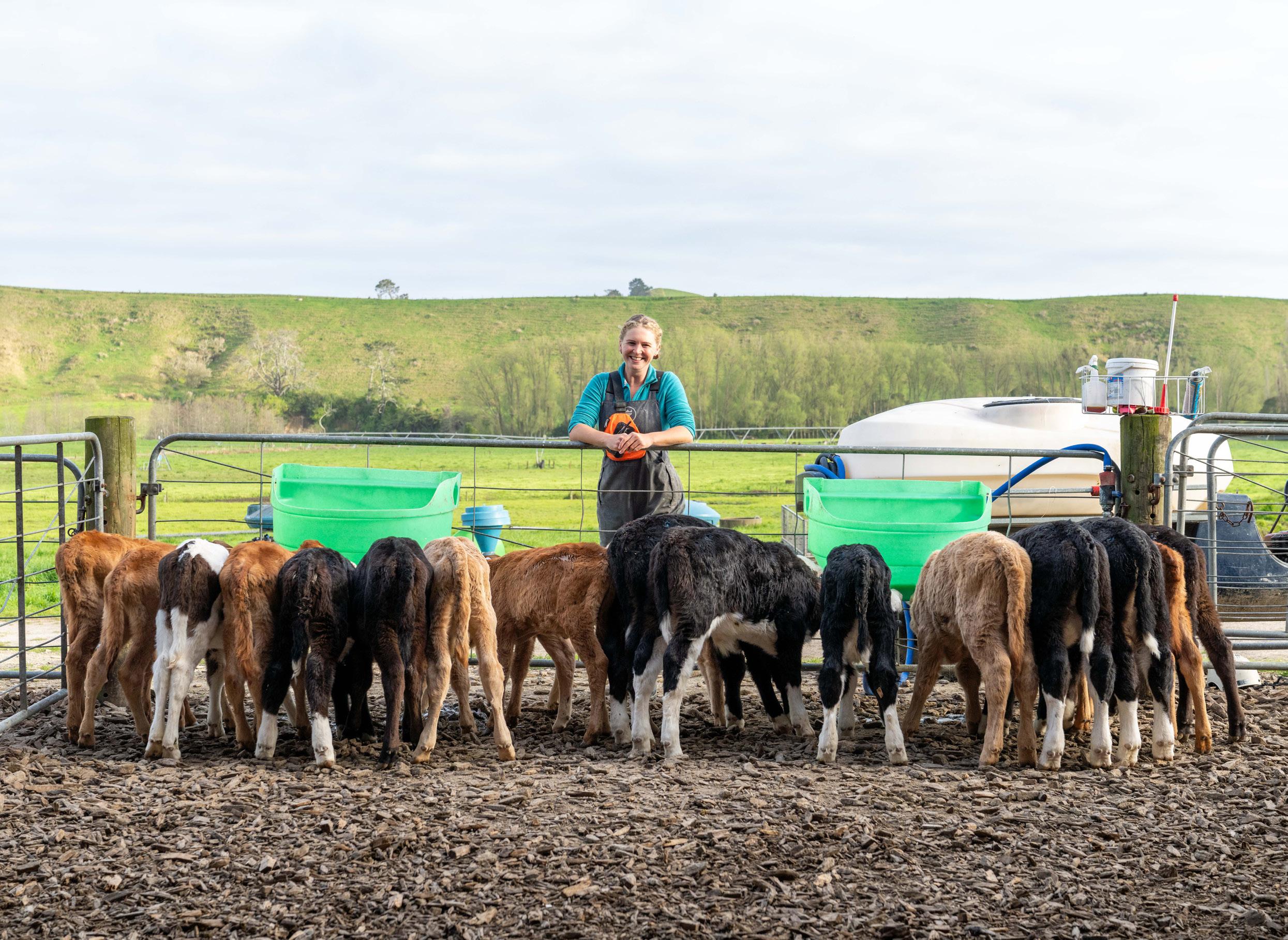
At Grieve Road, they had a 76% sixweek in-calf rate and 11% not-in-calf rate.
“We simplified things, we took out a lot of feed, we decreased our stocking rate. We did the opposite to a lot of other people who go OAD. A lot of people increase their herds to try and soften the production loss.
“But with taking the chicory out we were stocked at 3.8 cows/ha and it was putting too much pressure on the system and pouring way too much imported feed. Our stocking rate is 2.8 cows/ha now.”
“I had some industry professionals tell me this Friesian herd would have a lot of blown-out udders, and all sorts of health issues. This season we haven’t had any health issues from going OAD, it’s been all positive. We have saved $40,000 on animal health across both farms.”
The change in system has resulted in some other major savings, including less electricity in the farm dairy and a lower fertiliser bill.
‘This season we haven’t had any health issues from going OAD, it’s been all positive. We have saved $40,000 on animal health across both farms.’
The cows still lose the weight in the spring, but they put it on better over the summer months, Andre says.
“They’re drying off in a better condition so the work is already half done. I find they put the weight on a lot easier.”
Before they made the call they did get independent advice on whether the herd’s udder conformation would handle the change to OAD.
“We have also earnt $60,000 more in milk just from having more cows calved earlier.”
In 2022 they installed CowManager on both farms and the level of information they have captured has been crucial in the strategy change.
“The nutrition tool showed us at Grieve Road our rumination was low – therefore a change in diet was made,” Andre adds.
Rumination has improved across both farms and highlighted the importance

in the dry period and transitioning cows while calving down has helped with milk production, but also getting them cycling quickly again post calving.
“During mating it has simplified our system, we can run a pre-mating report and see if we require any intervention, and during mating each morning we have a list of cycling with some of these having no visual signs we would have previously missed.”
It has also helped reduce animal health costs with identifying sick cows earlier which means they spend less time out of the milking herd.
“Throughout the tough seasons and with inflation we looked for opportunities to cut costs where possible. CowManager was a cost that we saw adding a lot of value to the operation and decided to continue with it and we’re really happy with the results we’ve been gaining with it.”

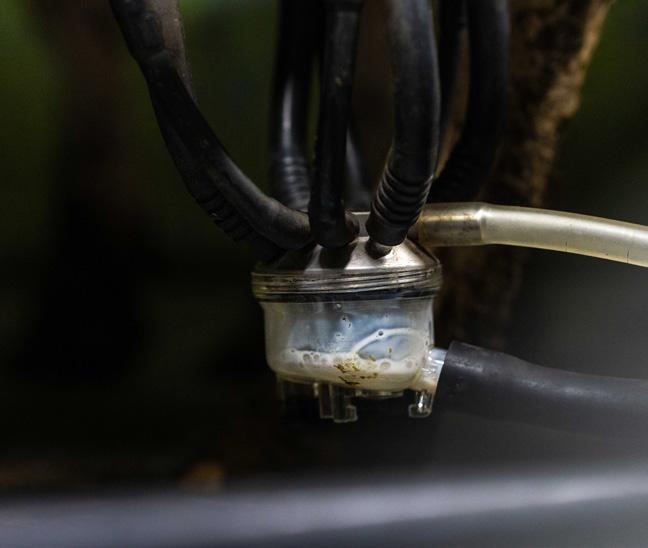
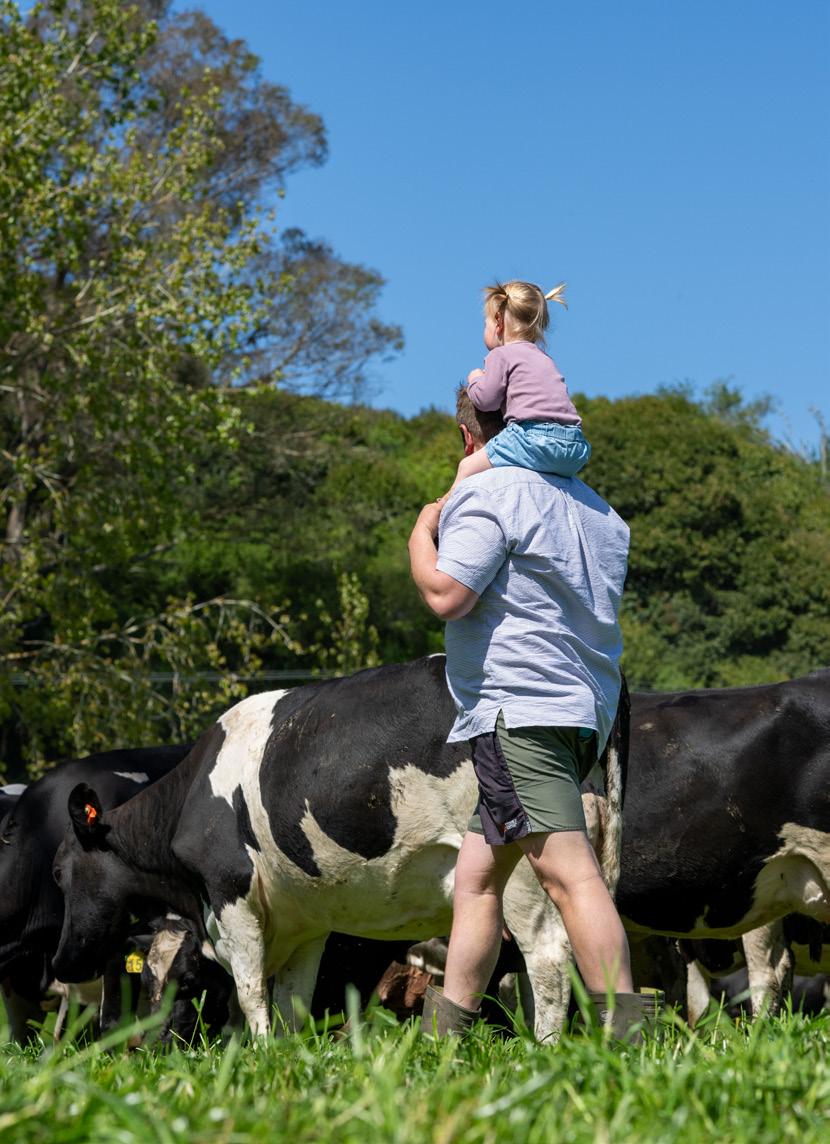
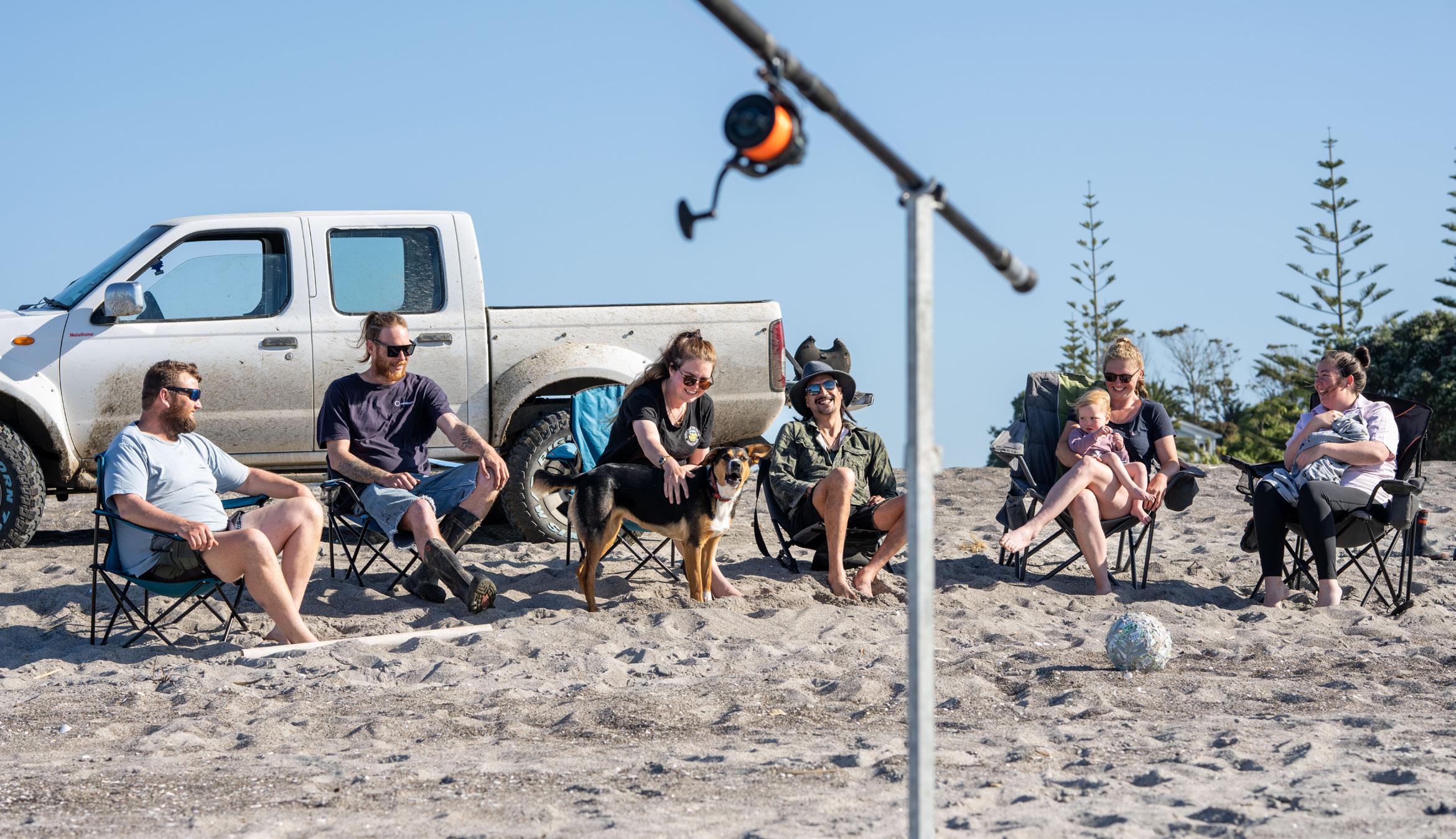
Another giant win from switching to OAD has been team morale and staff retention. Andre has always prided himself on looking after staff. His manager Lindsay Williams has worked alongside him for the last 11 years.
“One thing I’ve been told is you can’t roll out a good strategy without good team culture. It will never succeed. With this in mind we took our staff along this journey with us, they have been involved in the Zoom calls with Kim, CowManager tutorials, farm consults, etc.
“We have shared our strategy with our staff and the reasons behind it. We have our monthly production targets on the wall in the dairy office and at our weekly meetings we measure how we are tracking towards these, and ensure we are all working together to achieve these.”
This has led to great team culture, executing their strategy and their staff feel empowered.
“The last two seasons we have really worked on this and this season it’s really showing. Nat and I can slip away without any dramas. We can do it because everyone knows their jobs and there is a good culture.”
All the staff on the dairy units choose to still milk the cows at 5.30am and on the weekends they can be finished by 8.30am and take the family out for the day. Or finish early in the afternoon during the week to take the kids to their sport or drive the five minutes down the road to the beach.
“We make it very clear, we still pay our staff the same as on a TAD farm, we don’t sacrifice on that wage. They do similar hours, but more hours are out of the shed benefiting the farm maintenance, etc. and it allows us to be more family orientated.”
The Cameron family business owns a trailer with a barbecue and longline, surfcaster rods and whitebait nets for staff to use and enjoy the beach on their time off.
Through their struggles and poor farm results before doing their strategy change it was becoming very hard to show up each day, Natalie says.
“When you and your staff put in 110% effort, but get back poor results it really does affect you all. We love this industry and that’s why giving up wasn’t an option, even though sometimes that seemed the easier way out. Instead we used all the industry help we could, our family, and did a lot of research.”
The couple were asked to host field days about their journey and at the start it was daunting to open up their business to judgement of others.
“However, we were told that there are so many other farmers in the last couple of years in the same situation and that we need farmers to speak up to support each other and know we aren’t alone; then it made the decision easier,” she says.
“Just like this article, the more people we can connect with and make feel less alone in hard times means a lot to us, but to also share the learnings we’ve had along the way during our research is awesome too.”

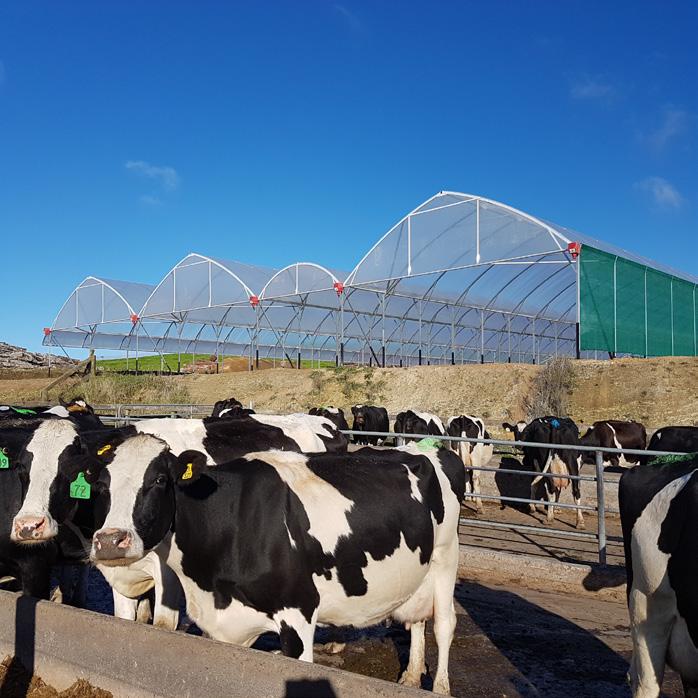



For drier, cleaner loafing areas & superior pasture management



Could gene editing animals spell the end to costly, painful diseases? US scientists have used CRISPR and cloning to create an animal resistant to BVD.
Words ANNE LEE
n the heart of Nebraska, United States, a three-year-old cow named Ginger is about to produce her first calf. It is a big moment for scientists in the US and worldwide because Ginger is no ordinary cow.
She is a clone, with one important exception to her genetic make-up when compared with her mother – she has the world’s first gene-edited genome for resistance to Bovine Viral Diarrhoea (BVD).
While the disease does cause diarrhoea, it is also a respiratory disorder as well as a disease that can have severe impacts on reproductive performance, reduce milk production and cause mastitis.
DairyNZ estimates the disease costs about $127 million per year to the dairy sector in New Zealand.
Dr Aspen Workman is the lead researcher responsible for Ginger’s existence, heading up a team of scientists from the US Department of Agriculture (USDA), US Meat Animal Research Center, the University
of Nebraska-Lincoln, the University of Kentucky, and industry partners, genetics company Recombinetics and its subsidiary Acceligen.
She says one of the difficulties with BVD is that animals can be continuously shedding the virus although they’re showing no signs of it themselves.
“Another problem is BVD can cross the placenta and infect the developing foetus. There’s a critical time frame between about days 45 and 125 of gestation. If the virus infects [the foetus during that time], it can establish a lifelong, persistent infection (PI). When the (PI) calf is born, it sheds huge amounts of the virus into the environment and because it won’t ever clear that infection, it will go on to potentially infect countless other animals.”
Previous studies have identified the mode of attack of the virus and how it “comes on board” its host at a specific site of the cattle genome known as the bovine CD46 receptor.
“We wanted to target that very first interaction between the virus and the receptor at a cellular level, but we know that receptor is also involved in immune regulation for other diseases, reproduction and other important functions for the animal, so removing CD46 altogether wasn’t a viable option. Instead, we wanted to make the smallest change possible to disrupt the ability of the virus to bind on without affecting other functions.”
Work by other scientists had identified which amino acids are responsible for BVD’s ability to bind, but it was Aspen’s team that took the research to the next stage, using CRISPR-Cas9 gene editing to alter just six amino acids on CD46. For context, it has about 418 amino acids in total.
Although we’re risking a bit of “alphabet bamboozlement” in the explanation of
‘We wanted to make the smallest change possible to disrupt the ability of the virus to bind on without affecting other functions.’
DR ASPEN WORKMAN Lead researcher
the science, the simplified version is that the work involved removing the amino acid sequence GQVLAL, responsible for allowing BVD to bind to CD46, and replacing it with ALPTFS, a sequence identified on a pig CD46 receptor which doesn’t allow BVD to bind.
Aspen explains that doesn’t mean the work is transgenic in the traditional use of the term because typically that would mean inserting a gene from another organism. Instead, this work involved making a small substitution within a gene that already exists in the cattle genome.
The team carried out numerous tests to ensure the edit reduced BVD virus susceptibility, which it did for every cell type tested. They also checked for any
off-target modifications using whole genome sequencing and found none.
Aspen and her team then took the work a giant leap further – to produce a live calf with that gene edit. That process involved replacing the nuclei of bovine egg cells with the edited material, enabling Aspen and her team to create cloned cattle with the desired edit.
They created 16 embryos, eight with the edit and eight without. Each was placed in separate recipient cows to gestate.
Knowing that days 45–125 of gestation are critical to infection, they took one edited foetus and one unedited foetus at 100 days, exposed cells from those animals to BVD virus and tested their levels of infection.
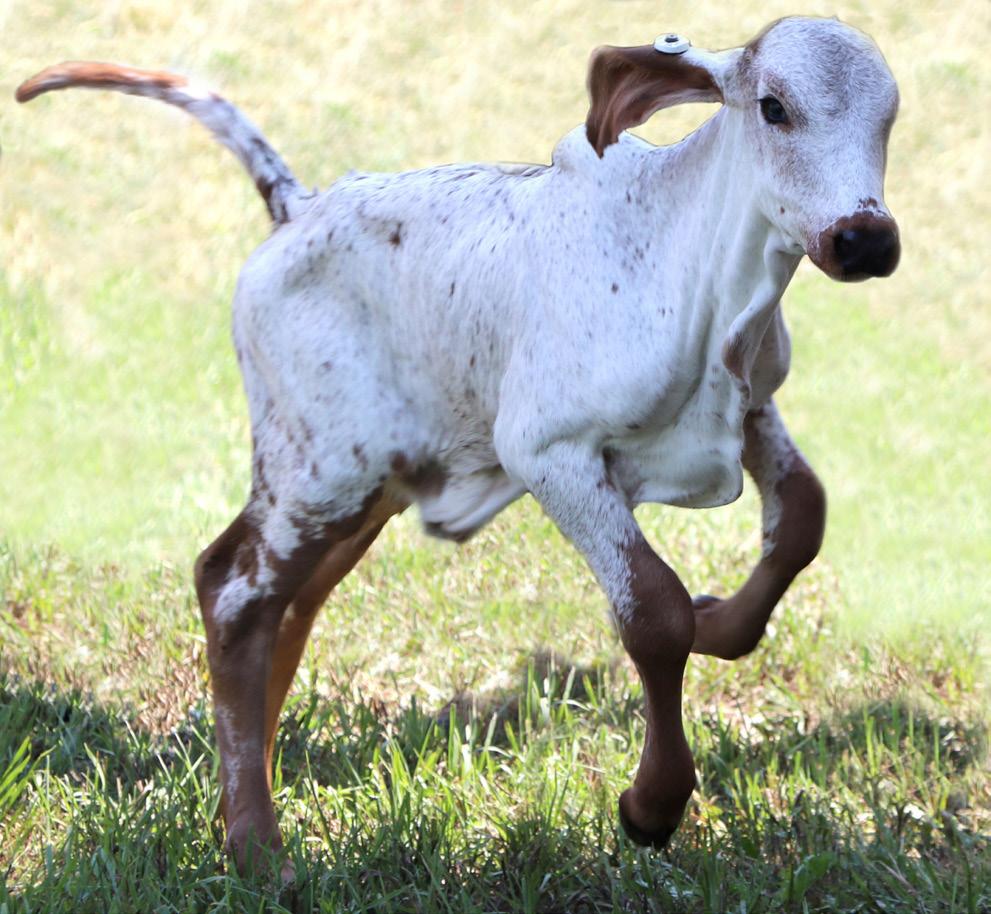
“We saw a huge reduction in virus in the cells of every tissue type from the edited foetus,” Aspen says.
While it offers numerous benefits in experimentation, one of the big downsides of using cloning technology is the lower survival rate of embryos to full term, Aspen says.
Ginger was the only edited calf to make it to full term. She was born in July 2021. None of the unedited animals made it that far – suggesting it wasn’t the editing process itself that caused the low survival rate.
The next challenge for the scientists and Ginger, was to see if she showed the
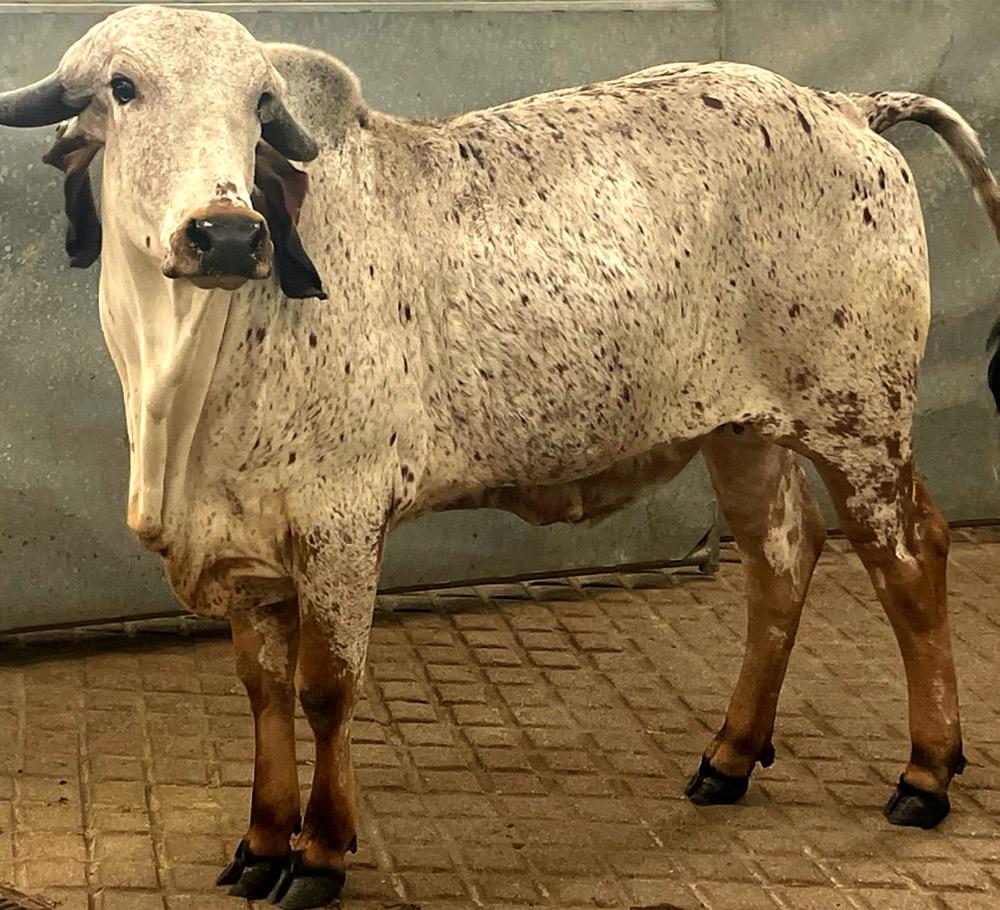

same level of resistance to BVD as the cells of the foetus had.
Ginger and the other embryos which started out in the experiment are a GIR breed, but because none of the unedited clones survived, she was compared with a female Holstein Friesian calf born on the same day that had been fed the same colostrum replacement as the edited calf.
At 10 months of age both were exposed to the same PI animal.
“That’s the main route of virus transmission in nature, so we wanted to replicate that as closely as we could.”
The unedited calf showed typical clinical signs of infection and blood tests revealed signs of the virus in her bloodstream for 12 days after exposure.
“Our edited calf, though, did not show any signs of an upper respiratory tract infection and we could never detect the presence of the infectious virus in her blood.”
Aspen says the next steps for Ginger have been to see that she can carry on and do all the things a normal cow
would be able to do such as get in calf, produce milk and remain within normal parameters for other health aspects.
LEFT Aspen Workman and Ginger, the gene-edited cloned calf born in 2021. Ginger is soon to have her own calf which may also carry BVD resistance.
“We’ll be able to test her calf to see if being heterozygous for the edit confers any resistance to BVD.”
Aspen says the next steps may be to look at other breeds, although she doesn’t expect there would be a breed difference in the edit’s success in providing BVD resistance.
She says that in theory existing elite genetics could be edited – both males and females – with the resulting offspring, that include the BVD resistance, then able to be bred from in the usual ways.
Ginger is a proof-of-concept animal and there’s still some work to be done before we are likely to see
‘Our edited calf, though, did not show any signs of an upper respiratory tract infection and we could never detect the presence of the infectious virus in her blood.’
DR ASPEN WORKMAN Lead researcher
She’s been inseminated with semen from an unedited animal and successfully carried a pregnancy so far. She’s due to calve in December.
Ginger is homozygous for the edit which means every cell in her body including both of her sex chromosomes carry the edit.
The bull had no edit so Ginger’s offspring will be heterozygous for BVD resistance – they will have one copy of genes from Ginger with the edit and one copy from the bull without.
commercialisation of the technology, says Aspen
But Ginger is a significant marker on the gene-editing route in agriculture.

Dr Aspen Workman –gene editing for BVD resistance and cloning a world first.
The Australian Office of the Gene Technology Regulator (OGTR) will be used as the blueprint for New Zealand’s gene regulator, likely to be proposed in the bill to be introduced to Parliament later this year. Anne Lee looks across the Tasman at what the OGTR is and how it works.
The Australian Office of the Gene Technology Regulator (OGTR) has been in existence for almost 24 years as an independent, statutory decision maker for activities with genetically modified organisms (GMO).
The office is headed by the gene technology regulator, which is an appointed role. Dr Raj Bhula has been in the role for eight years and has been reappointed through to 2026.
She explains that anyone wanting to work with a GMO must have an approval or apply for a licence and, under the current system, the type of licence is dependent on whether the organism is to be released into the wider environment or not.
Work with a GMO within a laboratory for research for instance requires a “dealing not involving an intentional release (DNIR) licence”.
But a “dealing involving an intentional release (DIR) licence” is required if a crop that has any genetic modification, for instance, is to be trialled or sold commercially.
As of June 2023, there were 56 current DIR and 157 DNIR licences.
Genetically modified (GM) canola, cotton, safflower, carnations, banana and
Indian mustard have all been licensed and are grown commercially in Australia.
Almost 100% of the cotton grown in Australia is GM with various insectresistant and herbicide-tolerant traits. During 2022–23 there were also 932 notifiable low-risk dealings (NLRD) notifications received which were predominantly for research work being carried out in certified facilities.
There are changes afoot to the process though that will likely also see the introduction of a permit-style system for lower-risk research work such as medical studies and clinical trials operating under standardised, compliance-monitored conditions in a laboratory or hospital setting.
Some application processes may be streamlined too, such as instances where field-trial licences are being sought for crops with the same traits as those trialled under licence for many years.
Herbicide-tolerant cotton field trials of a new cultivar that contains the same genetic trait as others already grown commercially could be an example, Raj says.
“The two categories that were put in place at the beginning of the scheme don’t quite fit neatly with everything that’s coming to the office now.”
The OGTR includes two branches.
One is the evaluation branch which carries out the evaluation of licence applications and prepares risk assessment and risk management plans.
The other is the regulatory practice and compliance branch which includes the monitoring of licences to ensure any dealings with GMOs are being carried out in accordance with legislation and licence conditions. The team monitors and audits facilities and field-trial sites. It also inspects field-trial releases to ensure they are carried out so they meet licence requirements.
Raj’s advice for NZ is to have that compliance team in-house.
“It helps that there’s good communication between the risk assessors and the people going out doing the inspections and compliance monitoring.”
When it comes to assessing risk and evaluating licence applications, she also has words of wisdom.
“Make sure you have a very good technical advisory committee. I know NZ has very good expertise and it’s important the expert panel has a range of expertise. Seeking advice from experts elsewhere is also important if the risk assessment team feels they need to.”
The first step in a typical DIR application is to make a public notification informing the public, interest groups, government agencies and expert organisations that an application has been received and what it is for.
The next step is for the staff at the OGTR to carry out a risk assessment and draw up a risk assessment and risk management plan.
Raj says staff at the OGTR carry out extensive reviews of known research on the GMO and can seek advice from experts both in Australia or overseas. While the OGTR sits under the Department of Health and Aged Care, advice is also sought from experts in environmental risk assessment with a close working relationship with the Australian Department of Climate Change, Energy, the Environment and Water.
The OGTR works with a range of other regulatory organisations too, such as Food Standards Australia New Zealand, the Department of Agriculture, Fisheries and Forestry, the Australian Pesticides and Veterinary Medicines Authority and state and federal authorities so advice and consultation can be carried out with the relevant authorities to the application.
These organisations often also have roles to play in regulating effects of the GMOs or the GMOs themselves.
A critical part of the OGTR’s structure and the licensing process is consultation with the 14-member gene technology technical advisory committee.
For a DIR, that consultation with the committee happens twice – once in drawing up the assessment and risk management plan and then again when the assessment and plan are completed. The technical committee is appointed and includes experts with a range of technical knowledge across a number of fields. They look for any gaps, ask a lot of questions and provide feedback for the regulator, Raj says.
The role of the technical expert committee is purely advisory. It does not make decisions on licence applications –that is up to the regulator.
The panel must include a member of another expert group – the gene technology ethics and community consultative committee which has nine members.
In determining risk, a wide range of factors will be taken into account such as
allergenicity, toxicity, potential effects on human and environmental health.
The OGTR operates using a published risk analysis framework.
All submissions including those from the public and interest groups received through the consultation phase are considered when finalising the risk assessment and risk management plan and before the regulator makes a decision on whether or not to issue a licence.
Over the years few applications have been turned down but Raj says in many cases where the application was unlikely
to gain a licence, the applicant would withdraw their application prior to the decision being made.
A crop that has been grown for a long period under licence and has shown no deleterious impacts on human health or the environment, may be placed on the GMO register which could mean anyone is then able to grow it without a licence.
Up until August, carnations – genetically modified for their colour – were the only organisms listed on the register but the OGTR has recently added GM canola –tolerant to the herbicide glyphosate.
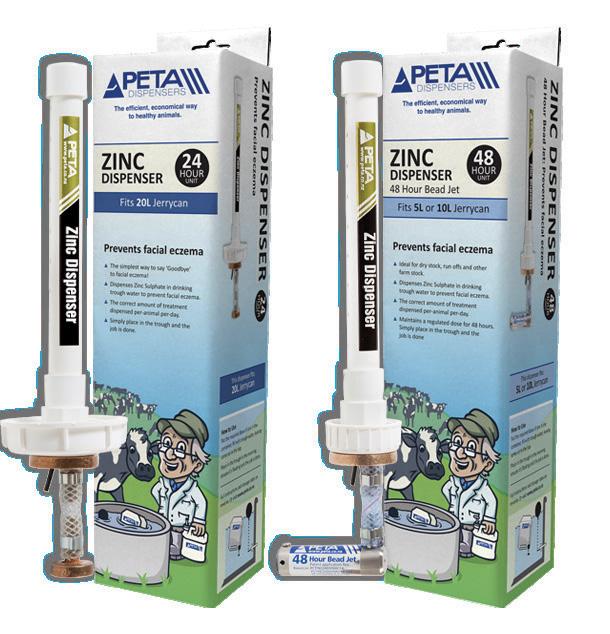

In 2019 the OGTR proposed not regulating any genetic modifications made using gene editing where no new genetic material is added.
Known as SDN1 gene editing, it often involves CRISPR-Cas9 technology and results in a break in the genome that may cause a deletion or a modification where a gene is silenced or knocked out. It can also lead to a modification through spontaneous repair of the break that creates a mutation. It’s argued that the end result could theoretically be no different to a natural mutation.
In the risk assessment and risk management plan it was noted that any risks associated with increased use of glyphosate on the crop were outside the scope of the OGTR’s assessments, with its focus on the crop and any effects associated with the GMO itself.
The OGTR releases a number of reports each year on its activities and documents relating to gene technology.
Transparency and public engagement are important for the success of the OGTR, Raj says.
The annual report is detailed and quarterly updates from the OGTR as well as communiques from the technical advisory committee meetings are all posted on the OGTR’s website along with licence conditions.
Community attitude surveys are also regularly carried out and posted on the website.
In the latest survey, published in June, support for genetic modification was reportedly stable with 38% of the Australian community in support of its use in general and 20% against it. There remains a large proportion of the community sitting on the fence at 37% and 6% say they don’t know how they feel.
Support for food crops rose from 38% in 2019 to 44% in 2021 and has settled back to 42% in 2024.
The survey found that for farmers whose income mostly comes from primary production, support for genetic modification and gene technology was greater than for people who do not generate any income from primary production (64% compared to 32%). Similarly, farmers showed greater support for uses in food and crops (63% to 31%), and believe it is a safe way to produce food (43% compared to 16%).
It is often impossible for an SDN1 modification to be detected as a “manufactured modification” as opposed to a naturally occurring variation.
Raj says there was plenty of debate at the time with organic and anti-GMO groups opposed to it. Some states set up moratoria on GMOs but she says they have largely fallen away now with just Tasmania, the Australian Capital Territory (ACT) and Kangaroo Island remaining GMO-free.
“In the end the debate narrowed to market access rather than risks to health and environment. But when it comes to market access – there are then issues because you can’t detect that GM technology has been used.
“So, traceability is another issue and that’s something that was discussed a lot. If SDN1 had been used in a plant breeding programme, do we want to know about that if the final organism is the same as a conventionally bred plant?
“That’s something NZ will have to work out for itself. But here we don’t regulate organisms developed using SDN1.”


LIC is dipping its toe in the water with gene editing, collaborating offshore with the Bill & Melinda Gates Foundation and gene technology company Acceligen in the United States to produce animals with gene edits that improve outcomes for cattle in Africa. Why, and what could this mean for New Zealand?
Words ANNE LEE
LIC’s involvement in a global partnership that could see a world-first, large-scale breeding programme using semen from geneedited bulls will allow the NZ farmerowned co-operative to build experience in the new technology ahead of regulation changes in NZ.
LIC chief executive David Chin announced plans in September for LIC to supply high breeding worth (BW), low-methane embryos as part of a collaborative project with the Bill & Melinda Gates Foundation. The foundation is meeting the $8.3 million cost.
Stem cells from the embryos will be gene edited in the US by Acceligen, a subsidiary of genetic company Recombinetics.
LIC international dairy development manager Jason Schrier is the project lead for LIC and says the project aims to develop gene-edited animals for the Sub-Saharan African environment for smallholder dairy farmers.
The gene edits will include the Slick gene which causes animals to have a shorter, finer coat and confers other heat-tolerance benefits. LIC discovered the Slick variant and holds the intellectual property rights on Slick testing.
Jason says three other gene edits will be carried out – one will be the Bovine Viral Diarrhoea (BVD) resistance edit (see page 24 for more). Another edit will create resistance to trypanosomiasis (Tryp), transmitted by the tsetse fly, which causes anaemia, weight loss and fever in cattle. Humans can be infected by bites
from infected tsetse fly too and catch African sleeping sickness.
The fourth edit is yet to be decided but may be resistance to East Coast Fever, a tick-borne disease that causes anaemia in cattle, or it could be an edit that confers resistance to Bovine tuberculosis (TB).
The gene-edited, male-sexed embryos will be transplanted into recipient cows in the US with the aim to produce 20 gene-edited bull calves that will then be transported to Brazil to be reared as elite sires.
The target is for one million semen straws to be collected from the bulls with straws then sold and distributed in Sub-Saharan Africa through a developed distributor network.
All the edits involve dominant homozygous traits so all calves sired by the edited bull semen will display the traits even though the mothers’ genetics don’t carry those genes.
LIC has been working with the Bill & Melinda Gates Foundation in Africa since 2017.
“They initially approached us to design a livestock information system for Ethiopia with the Ministry of Agriculture there,” Jason says. He’s spent time in Africa throughout that project and has made subsequent trips to progress this new project.
LIC is in the process of breeding the Slick gene into animals using conventional breeding programmes here in NZ, but Jason says the project to edit it into the cattle genome using CRISPR is giving LIC the opportunity to learn more about the process ahead of the legislation changes
the NZ Government has signalled for this country for next year.
“Gene editing also enables us to get the Slick variant into animals far quicker than natural breeding programmes,” Jason says.
Speed is important if NZ and LIC want to play a part in meeting future global food demands, with predictions the world could face a food supply crisis by 2050 due to increasing demand but lower production because of impacts caused by climate change, he says.
LIC general manager commercial Dr Emma Blott says CRISPR technology allows scientists to make a very precise cut in the receptor protein prolactin to truncate that protein and bring about the Slick, short-haired coat phenotype.
The work does not involve transgenics –bringing genes from other species.
She says LIC’s role in the project is multifactorial including having an impact on sustaining and growing dairy production globally. The project will enable LIC to help create improved economic, animal welfare and human welfare outcomes for tropical countries and will also help build knowledge and experience in gene-editing technology.
“Any learnings we have from this over the longer term could be applied to our home market or other international markets in the future, depending on legislation and stakeholder support which of course would include our farmers, dairy customers and the general public,” she says.
Farmer feedback on the project has included questioning the role of the Bill


“The questions have been more around what this technology could provide for their farm in the future. Do we have any intention of bringing that back?
“Some are excited, I’d say some are interested and some are nervous.”
Emma hopes that by sharing information about the project as it progresses, LIC will be able to educate, collect data and myth-bust.
More than 18 months ago LIC carried out surveys of its stakeholders, including a subset of its shareholders to gauge feedback on gene-editing technologies to help develop its stance and determine if it should be involved in such projects.
with the sustainability challenges we have in NZ and globally.
“But it’s really important we don’t introduce any changes into our very valuable food value chain here in NZ without the consensus and understanding of everyone involved along that chain. Because ultimately, what we do upstream here with the animals actually impacts the milk and the meat that ends up with our consumers overseas and in NZ. It’s very important that this is done with learnings, education and very broad consultation.”
Like many others, LIC will be extremely interested to see more detail of the proposed gene technologies bill to be introduced to parliament later this year.



L earning to read starts early in life. It’s a critical skill. Financial literacy and being able to read the language of money and finance is a skill often neglected but one that’s also hugely important.
The terms and jargon can be daunting if they’re not familiar to you, so in this special report we’re stepping you through some of those terms with our glossary.
We’re also making sure you understand the wondrous power of compounding and providing some advice from rural professionals, as well as giving you some insight into how one family farming business always has their numbers at their fingertips.
Words ANNE LEE
A balance sheet is a snapshot of your financial position at a specific time. It shows:
• Assets: What you own
• Liabilities: What you owe
• Equity: What’s left after subtracting what you owe from what you own.
For example, if you want to borrow money, the bank will look at your balance sheet to understand your financial situation. Sometimes it is referred to as your statement of financial position.
These are the things you own. Even if you still owe money on them, they count as assets.
Example: If you have a tractor worth $50,000 but still owe $20,000, the tractor is listed as an asset at its full value of $50,000.
Liabilities are your debts – what you owe to others. This could include:
• Bank loans
• Money you owe for equipment
• Debts to family or other lenders.
Equity is the part of your assets that you actually own outright. It’s calculated like this: Assets - Liabilities = Equity
Example: If your assets are worth $500,000 and you owe $300,000, your equity is $200,000.
This ratio shows how much of your business (total asset value) is funded by debt. Banks use this to measure risk. Debt/Asset x 100
Example: If you owe $100,000 and have $200,000 in assets:
$100,000
$200,000 x 100 = 50%
This measures how much profit you’re making from your assets. It’s useful for assessing the efficiency of your assets to generate a return and is a good way to compare investments. Return (or operating profit)/asset value x 100
Example: If you have an operating profit of $800,000 and assets worth $9 million:
$800,000
$9,000,000 x 100 = 8.8%
Similar to ROA but also includes any gain or loss in the value of your assets over the year.
Example: If your operating profit is $800,000 and your assets increased in value from $9 million to $9.35 million:
$800,000 + $350,000
$9,000,000 x 100 = 12.7%
ROE shows how much profit you’re making from the money you’ve invested, not just the total assets, after accounting for loan interest.
(Return - Interest Cost) / Equity x 100
Example: If your operating profit is $800,000, interest costs are $394,200, and equity is $4.5 million:
$800,000 - $394,200
$4,500,000 x 100 = 9.02%
A budget is your financial plan for the year. It lists all your income (like milk and stock sales) and your expenses (like farm running costs).
A cashflow report shows when money comes in to your business account and goes out each month. It helps you see when you’ll need extra funds, like an overdraft, to cover expenses during low-income or high-expense months.
This report compares your actual budget or cashflow with what you expected, showing whether you’re on track or not.
EBIT is your income after all farm operating costs are paid, but before interest and tax are taken out.
Operating profit includes all your income and expenses, as well as changes in the value of things like livestock, feed inventory, and depreciation. Unpaid family labour and support adjustments are also made. These adjustments ensure that operating profit is the best way to compare farms on a likefor-like basis. It can be expressed on a per hectare, per kg milksolids (MS) or per cow basis when making comparisons.
Depreciation is the gradual loss in value of equipment, buildings and infrastructure over time due to wear and tear. While it doesn’t directly affect your cash balance in the short term, over longer periods of time it should approximate the capital expenditure required to replace these items.
Learning to read the numbers and decipher what they’re telling you is a skill that can be learned. Anne Lee talks to long-time financial educator Paul Bird about the process and discovers the wonder of compounding.
Becoming proficient in any language takes time and practice. The language of finance is no different.
DairyNZ’s Paul Bird has been coaching farmers in the money side of their farming business for more than 20 years.
“Managing budgets and cashflows, doing the accounts – that’s not usually what draws people into farming. But when you understand what those things are telling you, when you can look at the numbers and see the story clearly, that’s when you can be in control of the narrative,” he says.
Paul cites renowned investor Warren Buffett when he says, “Accounting is the language of business.
“There are key accounting terms and financial KPIs (key performance indicators) that tell you where you’re at and if you’re heading in the right direction. They help you see what’s working well and to pinpoint where you need to improve. They also help you make decisions about what to do next, to analyse a venture proposition and see an opportunity.
“If you don’t understand those terms and KPIs, it would be like living in a foreign country and not being able to speak the language. Everything would be so much more difficult.”
Just as it takes time to become fluent in a language, it takes time to become fluent in the language of money.
“If you were moving to France and didn’t speak French, you wouldn’t expect to just turn up and be able to converse. You’d buy the CD and put it in your car or download the app on your phone and start by learning how to say the basics.”
The dairy sector provides numerous opportunities to learn financial skills whether that’s through courses such as those offered by Dairy Training (a subsidiary of DairyNZ) or Primary ITO, online webinars run by farming groups,
accountants or accounting software companies.
“For those starting out, it might mean asking your farm owner or the sharemilker you’re working for, “Hey, when you do your budgets do you mind if I’m involved so I can see what you do and how you do it? Can I sit in when you’re doing your cashflows?”
Paul warns people not to get discouraged if they don’t understand every concept straight away.
“Persevere and practise and don’t be afraid to ask.”
Building financial skills isn’t just for those starting out. Those who have
SAVING $20,000 PER YEAR AT 7% RETURN FOR 40 YEARS

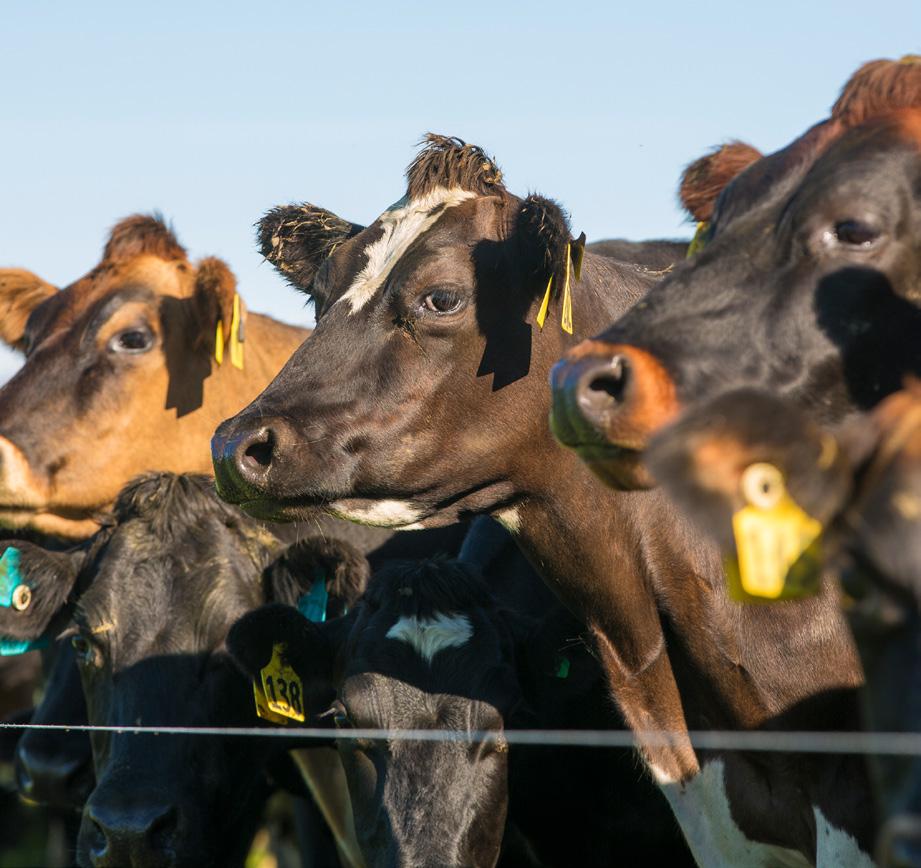
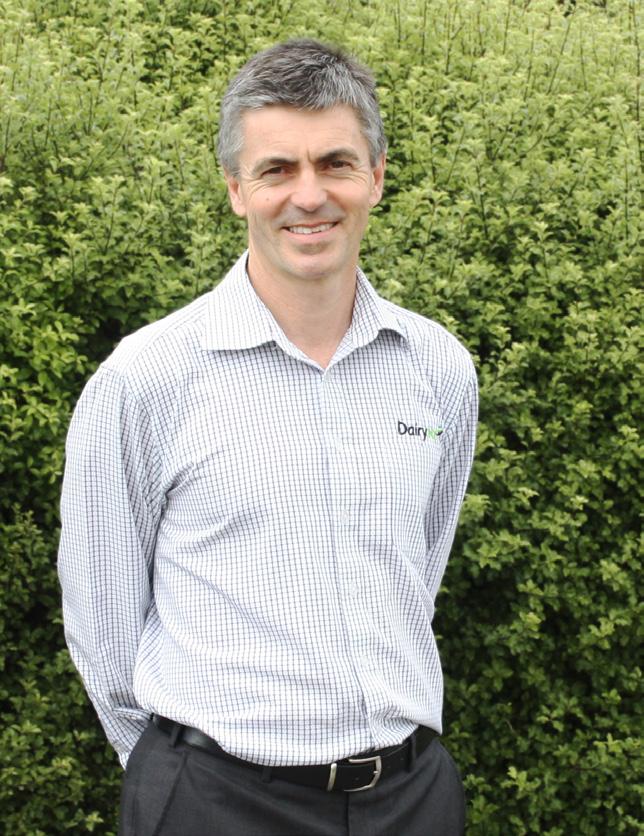
been in business for longer can lean on their advisers and shouldn’t be afraid to ask for deeper explanations so they can better understand the advice, ask probing questions and be in control of where the business is going.
“Compound interest is the eighth wonder of the world. He who understands it, earns it … he who doesn’t … pays it.” Albert Einstein.
Grasping the concept of compounding can be a pivotal “aha” moment for people in business, savers and investors alike, Paul says.
The magic happens when people see that by reinvesting the interest or the returns they have made on an investment each year, they then have a greater amount to earn interest on the next year.
Although the percentage return on the investment or the interest rate remains the same year-over-year, the amount earned grows exponentially as the savings and amount reinvested back grows.
For example:
$100 invested at a 10% interest rate will return $10.
If that’s added back to the original investment, it becomes $110 so a 10% return on that at the end of the next year gives $11, so the original amount is now $121.
At the end of the third year, at the same 10% return, the payment will be $12.10 so you will have $133.10. The total is growing by a larger amount each year. Fast-forward 20 years and the annual increase has gone from $10 to $61.16 and you have $672.75 from that initial $100 even though you’ve done nothing more than returning the interest back into the account each year.
Using your calculator to work out the final compounded value. In this example we use a $20,000 investment with a 10% or 8% return over 10 years.
‘By returning that interest and sticking with the $20,000 annual savings you will have put in $820,000 (in the $20,000 increments), but thanks to the power of compounding you will have $4.5m and be earning $300,453 a year in interest.’
Now look what happens when you do more than just put in a one-off amount at the beginning and each year you consistently save a more significant amount.
The power of compounding really comes into its own.
A $20,000/year saving plan at a 7% return (10% adjusted for inflation) will be returning you an extra $22,097/year. By year 10 you will effectively be doubling what you put in that year.
Step one
Step two
Enter the original amount. Multiply the original amount by 1 plus the interest rate (if
Step three
Press the equals button on the calculator for the number of years you want to calculate the return over (for 10 years press the equals button 10 times). $20,000
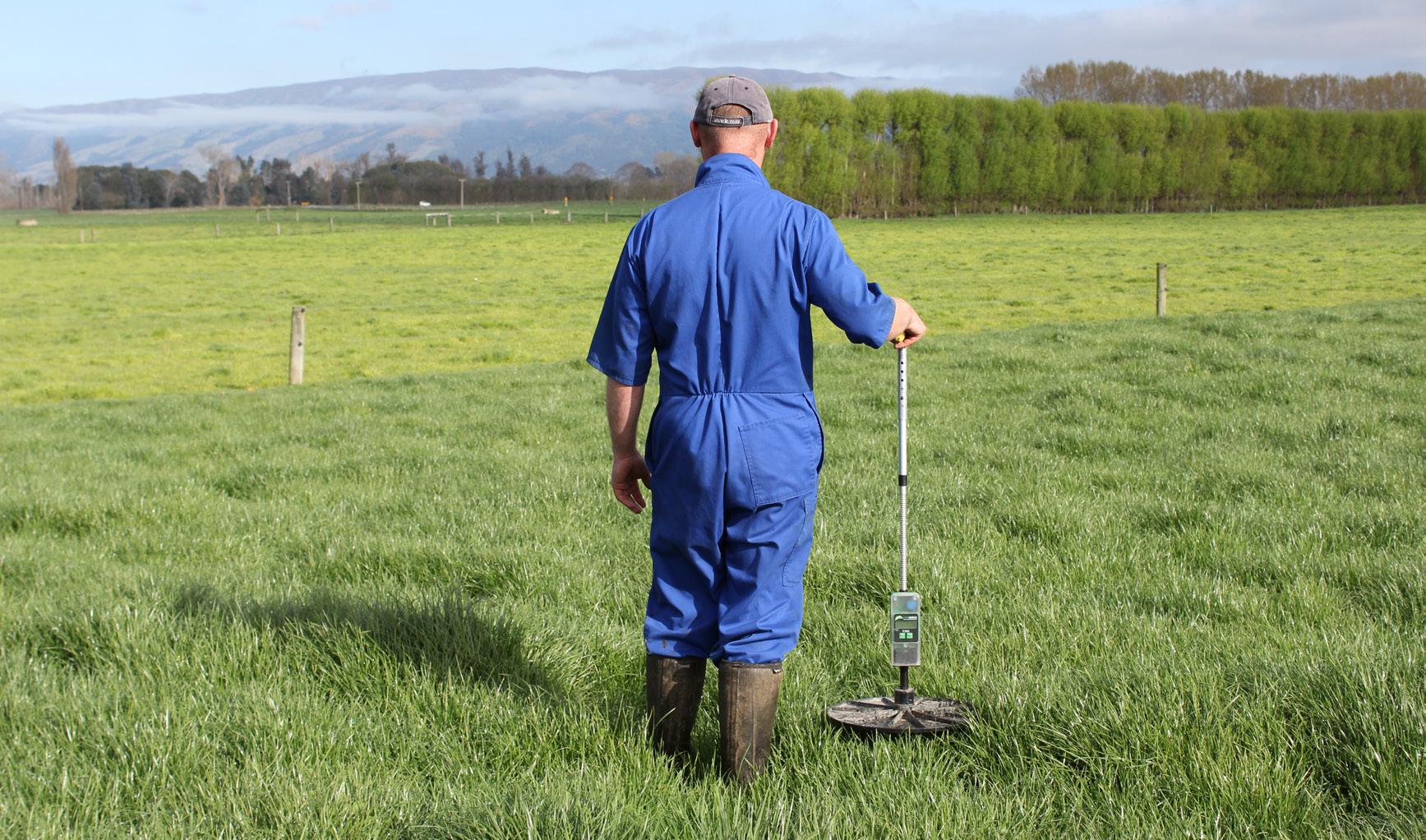
Your total savings will have ballooned up to $315,672 – an extra $95,000 over what you have put in of your own money.
If you stick with it for 21 years you will have just over a $1 million savings and each year you will be earning $68,608.
By the end of 40 years, by returning that interest and sticking with the $20,000 annual savings you will have put in $820,000 (in the $20,000 increments) but thanks to the power of compounding you will have $4.5m and be earning $300,453/ year in interest.
In the early years, when saving $20,000/ year may be taking big sacrifices, people can feel disappointed that the savings aren’t going up as fast as they’d like.
“The magic happens when they persevere and those numbers start rising exponentially – they enter the zone of amazement,” says Paul. “Those who truly understand compounding connect daily decisions with long-term wealth creation.”
For instance, if better pasture management leads to an additional 1 tonne of drymatter (DM) per year, that’s an extra $350/ha/year added income. For an average 140ha farm, that’s an extra $49,000/year.
But on a compounding basis, at a 7%/year return, over 30 years that’s equivalent to $5m or $3.6m after tax of additional income.
If you have this mindset, you’ll look at your purchasing decisions a bit differently too.
A one-off capital saving of say $25,000 by purchasing a reliable second-hand vehicle over a brand-new, flash, shiny farm vehicle would be $190,000 if that
one-off saving was invested at a 7% return for 30 years.
“You’ve got to think about making your money work for you over the longer term.”
Paul says he uses 10% per year as a standard return because historically global sharemarkets have returned that amount over longer periods of 25-plus years.
When he takes into account inflation, that long-term return figure becomes 7% per year.
“What we often see is people in their thirties feeling like it’s all just not happening fast enough for them, but there’s a point where the exponential nature of compounding means you start seeing those numbers going up significantly every year.
“Hang in there – if you’re disciplined the rewards are really worth it.”
DairyNZ has several online tools such as:
• Budget templates for farms supplying each of the major processors.
• Cashflow budgets.
• A partial budget to help analyse options.
• Calculators to assess returns from contract milking and variable order sharemilking contracts which include budgets.
• A stock reconciliation calculator to help work out the change in livestock values from year to year and to calculate livestock income.
• A guide for calculating return on assets and return on equity.
$6,000,000
$4,000,000
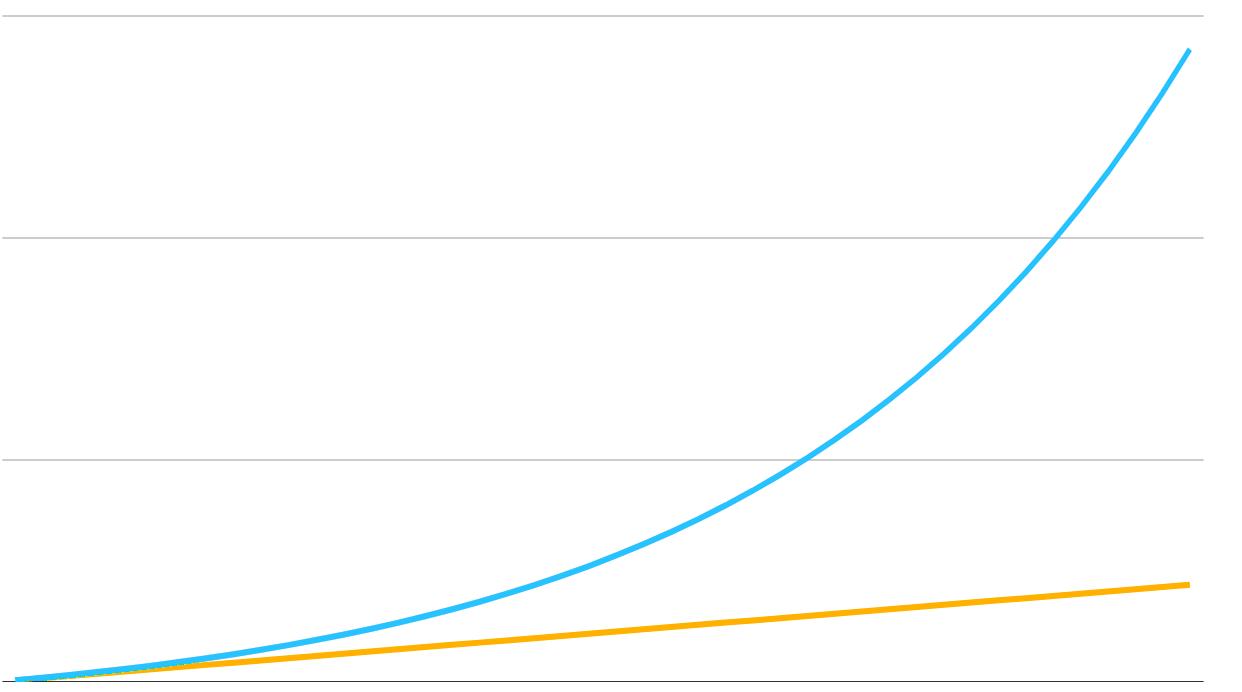
Forecasting your season ahead and picking the right tax payment system may help to avoid that unexpected eye-watering tax bill.
Words TRUDI BALLANTYNE
One of the pet hates a rural bank manager has is the phone call from a farmer asking for an overdraft extension to pay an unexpected tax bill.
The volatility of farming incomes can often lead to tax surprises – where you are suddenly asked to pay a large amount of tax or where you receive a large tax refund because you shouldn’t have had to pay the tax in the first place.
The traditional provisional tax system means tax payments for the current season are based on what your farm earned in the previous season – or if your financial statements are prepared late – on what happened the season before that. As we know, milk prices, onfarm costs and changing interest rates cause farm profitability to drastically change from year to year – meaning the tax being paid may not be based on upto-date information.
To avoid this, farmers need to “know their numbers”. They need to prepare a forecast to understand what the year ahead looks like. There are some excellent software providers out there that, in conjunction with your accountant, can make this a pain-free process. Once you have a draft budget, ask your accountant to look it over and add in the likely tax flowing from those numbers. By doing this, you are highlighting to your accountant that your profitability is going to vary from the previous year, and you can start a discussion about the best way to handle the tax volatility.
If your profit is going to increase, you may want to consider making a voluntary payment to IRD to avoid hefty interest charges. Alternatively, if your profit is dropping, consideration should be given to filing an estimate with IRD.
There is an alternative to the traditional provisional tax system – AIM – Accounting Income Method. This system allows you to pay your provisional tax every two months alongside your GST. The payment is calculated based on your actual profit for the two-month period. This means you are only paying tax in the periods you make a profit. This may mean that for the first half of the dairy season, provisional
tax payments are minimal with higher payments later in the season as cash starts to flow.
AIM returns do need to be filed in conjunction with your accountant. They need to check over the coding in your accounting software and make sure things like asset purchases and depreciation are calculated correctly every two months – but this is stuff they have to do at the end of the year anyway. By getting an accurate profit result every two months, you get to the end of the financial year with some certainty that your provisional tax payments made via AIM are reasonably accurate and the money left in the bank at the end of the financial year is all yours.
‘By getting an accurate profit result every two months, you get to the end of the financial year with some certainty that your provisional tax payments made via AIM are reasonably accurate and the money left in the bank at the end of the financial year is all yours.’
Whether you use the traditional provisional tax system or the newer AIM system, being proactive with your financial forecasts means you can avoid nasty tax surprises.

Successful farming hinges on more than just good soil and weather; it relies on disciplined financial management, from tidy records to strategic budgeting and clear communication.
Words CHRIS LEWIS
Atop farmer once told me, “A drive around the tanker track will tell you a lot about a farm.” They were right. A tidy, well-organised, well-run farm can be picked out inside the first 200 metres of the farmgate.
In the same fashion, you can pick a business with good financial management by a glance at the farm office desk. Is it tidy and organised, paper records filed, not loosely stacked?
Then you flick open the computer. The cashbook is up to date and reconciling. The budget is being utilised and has an accurate livestock tally.
When you ask a good farming family about their business they can talk to key financial numbers without a flurry of paperwork. They can comfortably answer questions like:
• What is your cost structure per kilogram of milksolids (kg MS)?
• What is your breakeven milk price?
• Which months are tight for cashflow?
• What trading result is expected this season?
• How strong is the balance sheet?
It would be remiss if this article did not pause and reflect on communication of the business plan and financial aspirations. The most important place being at the dinner table. Are spouses
talking the same language? Do they work as a team and commit to the same plan? Are the sacrifices needed to progress being shared?
The successful family business will regularly talk about what they are trying to achieve. They know how far away they are from achieving it and agree on what needs to be done to get there.
With the shared dream, good business systems and a clear plan, the successful farming family will communicate well with their advisers and mentors. Business goals are well articulated and progress towards achievement is being monitored.
Then with a clear understanding of what needs to be achieved, direction can be given to the farm team on implementation. Expectations for physical performance are clear. There will be a few simple monitoring points and if the direction of travel is not as planned, an alert will sound.
Milk production falling below target. Farm expenses tracking ahead of the budget. Feed purchases up or inventory building. Unexpected repairs and maintenance costs. All of these will raise flags in a well-managed dairy farm business and bring about prompt and appropriate management responses.
Timeliness of well-informed decisions are core to good business management.
Your accountant, bank manager and farm consultant will be quick to recognise the above. The accountant recognises the clients that are prompt with their annual records and compliance (PAYE, GST, operating consents) reporting. The informed farming client doesn’t just have tidy records. They are asking questions of their accountant about insights into financial performance, tax management, and seek their expertise.
The bank manager will see budgets that are connected to reality. There will be searching questions from the client about margins, debt structure and interest rate decisions. Funding requests will come with a clear, well-presented plan of what’s required, why and how it will be funded.
For farm consultants, working with clients on business planning, goal setting, budgeting and monitoring is the “day job”. But the clients who really lead in business, the top 10%, will have pre-prepared the core information. On farm visit day the cashbook is updated
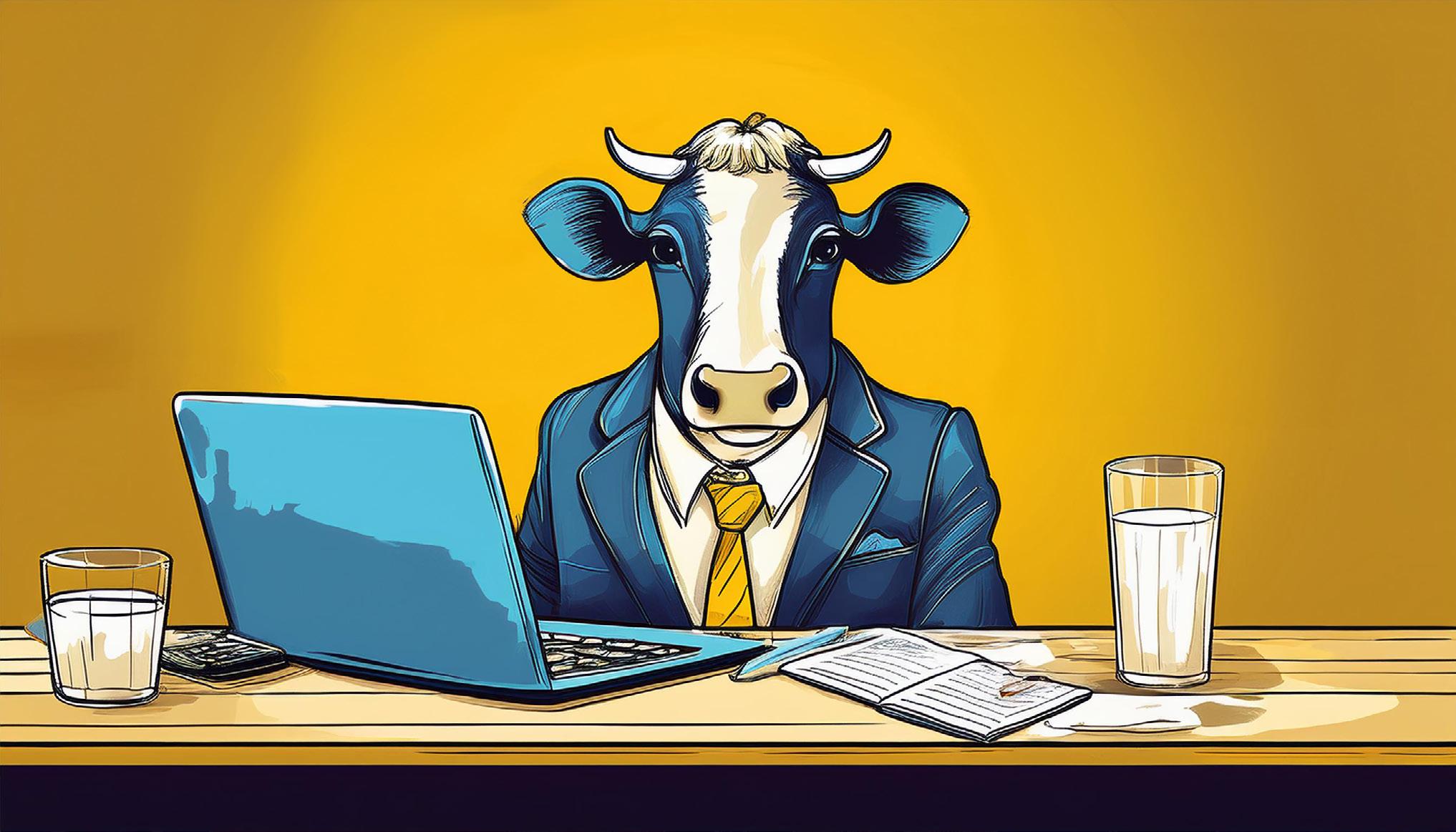
and reconciled ready to view. They will have the financial statements and current physical performance written out and ready on the kitchen table. They know what you need before you ask and there will be a written list of questions, essentially an agenda on what they want addressed during the meeting.
With good information comes insight and with insight there is sound decision making. The business-minded farmer will know what good looks like and they will constantly challenge themselves to achieve or exceed the standard.
The sort of financial standards you typically see in a successful dairy farm business are as follows:
Strong cost control. Expenditure is managed and scrutinised. Does this “spend” add value to the business? Is it a “need or a want”? Will the expense represent efficient use of resources or contribute to inefficiency?
Spending will be in tune with productivity. The measure most farmers would be familiar with is operating cost/kg MS. For the astute this will include provision for depreciation and adjustment for labour and change in feed inventory.
Currently a cost structure of $6.50/ kg MS is average. But good is a cost
structure below $6/kg MS. If costs appear high, it will be because of spending behaviour, farm system design or the absolute costs are okay but, through inefficient management practices, the milk is not being produced.
With good information those who are trying to step up will know what they must do next. What has to change and what are the specific outcomes to be delivered?
When something outside of the prudent operator’s control changes, for example milk price or weather, our good farmer will look to the things they can control to buffer the impact. A response to lower milk price might be to contain expenses that don’t impact productivity. In a bad season they will look to ensure core functions like mating are not compromised or pastures are not damaged.
A strong business does not always mean “mortgage paid off”. Size of debt does not define business performance. What is happening in terms of debt management is critical.
Debt that is building in an unplanned manner is of serious concern.
That said, debt can be a motivator to perform. Successful farming businesses can operate with high debt, but the
balance sheet is improving. Equity is growing by design, not by default.
In summary, good financial performance is more than a number on a balance sheet. It will look like a tidy, well-organised farm office. The conversation is clear, articulate and searching. Questions are being asked. Dreams and goals are in the dinner-time conversation and shared.
The team working with our successful farming business knows what is expected and is clear on what outcomes are required.
Key metrics are known and monitored. If something falls out of line, there will be a timely response. Farm expenditure is disciplined and in keeping with the farm system.
The size of the debt is not important but how it is being managed is.
Ultimately you don’t have to drive very far to recognise and hear a good farming family in action.


Understanding and closely monitoring the numbers is helping a North Canterbury farming family drive their business to achieve their goals.
Words ANNE LEE Photos HOLLY LEE
Nicky Anderson’s aim for managing the finances in the family farming business is to be paperless. Her husband Duncan loves to write things down on paper.
He has a sturdy eraser and well-worn pencil and while it may seem at first that they’re not quite aligned, it’s soon clear they are most definitely on the same page – whether it’s paper or a screen.
Their core document is paper – a large A3 with a multicoloured wheel at its heart. It’s the planning wheel, created during a DairyNZ Mark and Measure course in 2015, but more about that later.
The family has been dairying for just over 10 years, converting their 405ha Rotherham sheep and beef farm, Auchenbrae, in North Canterbury to dairy in time for the 2013–14 season.
It’s now a substantial 482ha property milking 1750 cows with an adjacent 418ha support block which includes both leased and owned land.
Their son Jack is now managing the support block and they have variable order sharemilkers Paco and Lou Mones-Cazon running the dairy farm. Their older son Angus has recently returned to the area too and is running his own sheep and beef enterprise on leased land about 25 minutes away.
The dairy farm has an 80-bail rotary and in total they have 14 pivot irrigators – along with other forms of irrigation too.
The conversion was a big step, one they discussed as a wider family with their two sons Angus and Jack, then high school age.
“We knew that if we were going to have a longer-term vision for the business as a family then going to dairy was the way to make that happen. The decision was driven out of frustration really, with the meat companies and the mistakes you could see happening again and again, decade after decade,” Duncan says.
“But it took Duncan ages to get me over the line with it –mainly because of the debt we’d be taking on,” Nicky says.
But the monthly milk cheque, long-term returns and the opportunities for the future eventually won her over.
They had grazed dairy stock from the district and Duncan had also been an AI (artificial insemination) technician in the Amuri Basin.
“When I was out on the AI run, the guys who knew I was converting were more than happy to share information,” he says. “The dairy industry is so transparent and the transfer of information between farmers is fantastic.”
While it hasn’t been a straight line, with the first year’s $8.40/kg milksolids (MS) milk price followed by $4.40 and $3.90/kg MS, they have no regrets about the decision.
Having a close eye on the financials is a must, Nicky says. Trained as an accountant before going farming, she readily admits that she enjoys the numbers side of the business and making it part of the daily routine isn’t seen as a drag.
Instead, she’s found it has helped her learn about the dayto-day activities of the farm alongside Duncan and made her feel very much a part of the business. Knowledge, she agrees, gives you power.
But she says it also gives you comfort because at any time she and Duncan will know where they’re sitting relative to budget and how the monthly cashflow is panning out across the season.
“I think one of the reasons I enjoy it is that I can see how we’re tracking towards the longer-term goals we have and that’s exciting,” she says.

AUCHENBRAE FARM Rotherham
• Owners: Nicky and Duncan Anderson
• Variable order sharemilker: Paco and Lou Mones-Cazon
• Area: 482ha
• Cows: 1750
• Supplement: 500–700kg drymatter (DM)/cow silage, palm kernel, grain. Spring includes soya meal and distillers dry grain (price dependent)
• Farm dairy: 80-bail rotary
• Automation: Protrak, automatic cup removers, Allflex collars, in-shed feeding (three feed heads)
• Production: range from 465–510kg milksolids (MS)/cow since conversion
Support block
• Area: 418ha
• Rearing: 400–440 dairy replacements, 200 Wagyu-cross reared and finished for First Light (total up to 500 onfarm), 150 bull beef calves to 100kg, rear 52 bulls for onfarm use and finish 30 of these, 120 Hereford-cross calves sold at one year old.
• Cows: 1800 cows wintered.
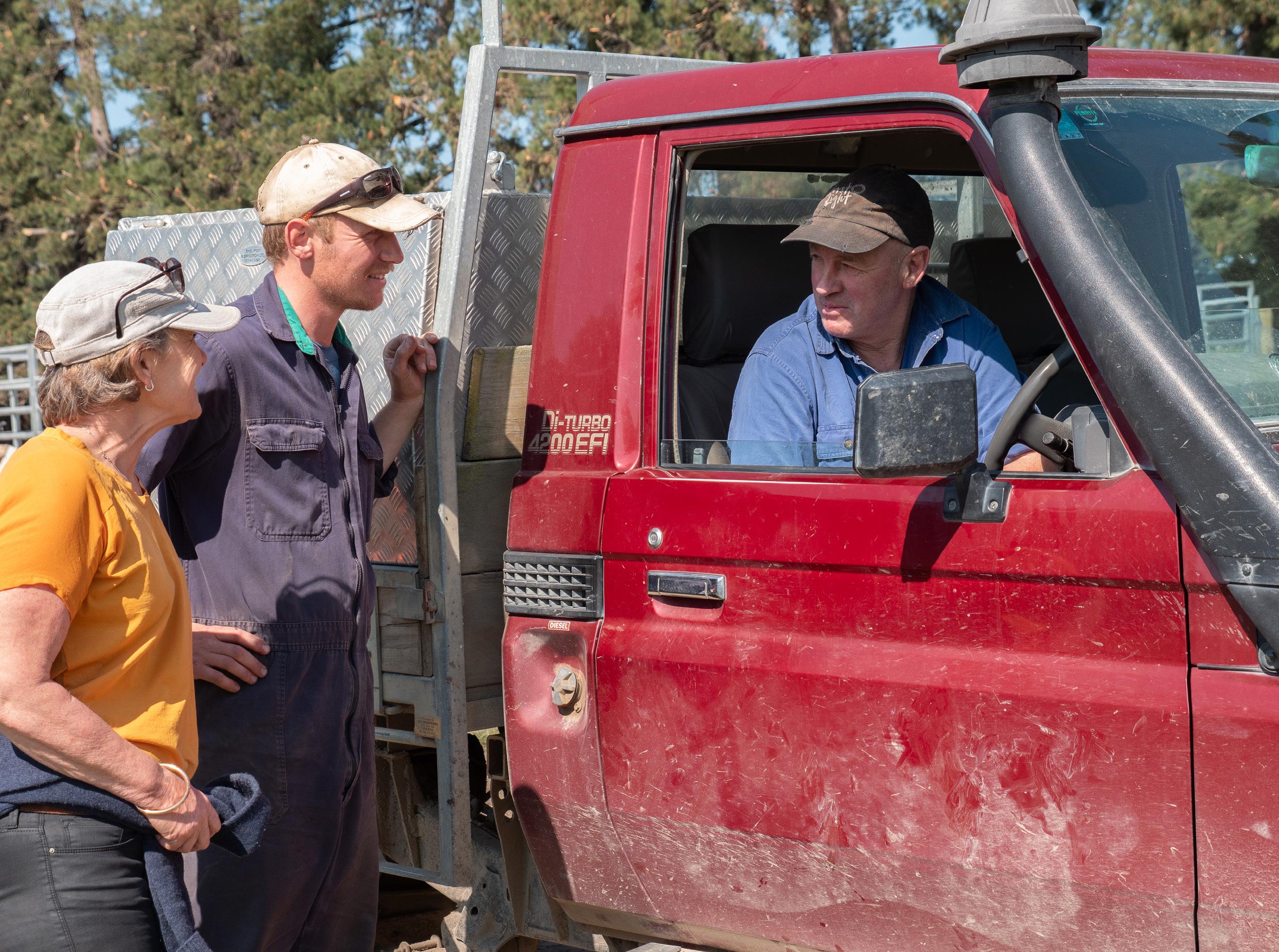
“I think one of the most powerful things we did right at the start of this was, after our first season, we went to a DairyNZ Mark and Measure course,” says Duncan. “We took the boys too – Angus was at Lincoln (University) and Jack was in his last year at high school.”
They created their own planning wheel, a strategic planning tool, setting goals and mapping out how they were going to make each happen.
“Every time we get to a crossroads or have a big decision to make we go back to that and think okay, how does this fit with that plan, is it going to get us to the goals,” Nicky says.
“Some of the goals were a long way out so we’ve had to actively drive progress and still have to do that,” adds Duncan. Having a good understanding of your working financials informs decisions about the opportunities that arise, they say. To do that, Nicky and Duncan set up a budget in their farm financial accounting software.
They start by looking at the actuals for the current season on a line-by-line basis and whether anything will change, either with the way they’re running their system or in terms of price changes. There are always tweaks to the system, informed by Paco’s rigorous record taking and analysis.
Now with Jack on the support block, he too is identifying areas for greater efficiency or better gains.
“We try to do as much of our own servicing and maintenance as we can,” Duncan says. “For instance, we’ve been servicing our own pivots for the last six years but if there’s something we can’t fix – such as a drive chain – we call up and tell them what specifically we want fixed and which pivot it is.”
They’ll go out to suppliers of some of the larger consumables such as teat spray each year and get quotes for the best deal they can do. Making use of suppliers’ interest-free deferred payment schemes can make for a smoother cashflow too.
“We’re using milk powder for our beef-cross calves on the support block and have been able to make use of the Farm Source scheme and put that cost into December, once the 100kg animals have left the farm and been paid for,” Nicky says. “It all helps to even out some of those lumpy months when it comes to costs.”
Speaking of lumpy items, budget time is an opportunity to talk about plant and machinery replacement, she says.
“We do all our own ag work – regrassing and balage, although we get contractors in for the silage,” Duncan says. “But it does mean that every few years something might need replacing.”
Nicky prepares the cashflow and initially does her own spreadsheet to come up with the monthly milk income for the cashflow, but once Fonterra has put up the advance rate for the new season, she will update the information using Fonterra’s dairy forecaster which links into the software.
Whenever there’s a milk price announcement the updated prices automatically flow through at the click of a button.
The livestock module in the software is the place to start for the beef side of the business. It has taken Nicky a bit of time to master this, but since their son Angus started in his sheep and beef business, the importance of this module has become very apparent. Building the numbers in the livestock module forms the basis of Angus’s sheep and beef business budget.
One of the “work ons” in their Mark and Measure planning was to lift stock returns to help buffer inflationary costs and milk price fluctuations. They’ve boosted returns on a kg MS basis from 23c to $1.15.
“You have to keep on top of recording the births and deaths and make sure classes are recorded correctly when transacted,” Nicky says.
‘I run my eye along the balance at the bottom of the page to see the peaks and troughs and make sure it’s what we’re expecting. Then I run a year-to-date variance report to see how we are tracking.’
NICKY ANDERSON
With the budget prepared, it’s then a matter of keeping it updated. Both their accountant and banker have access on a read-only basis to the information, allowing them to see key numbers and what’s behind them if they wish to.
As the season starts to roll through, electronic invoices and credit notes are uploaded to the software and around the 13th of each month, once all invoices and statements are in, Nicky matches the invoices she has to their statements to make sure all invoices have been correctly received.It’s at this time the paperless office system gets challenged, with Duncan noting down each invoice amount on his notepad. He confirms whether it’s related to the dairy farm or the runoff and who can verify the spending.
“I’ll ask Paco about any on the dairy farm and I’ll talk to Jack about any on the runoff. They’ll be able to tell me if the thing that was ordered and invoiced actually turned up and that the pricing matches what they were expecting. It might be for servicing something and they can tell me how long someone was actually onsite for and what the outcome was.”
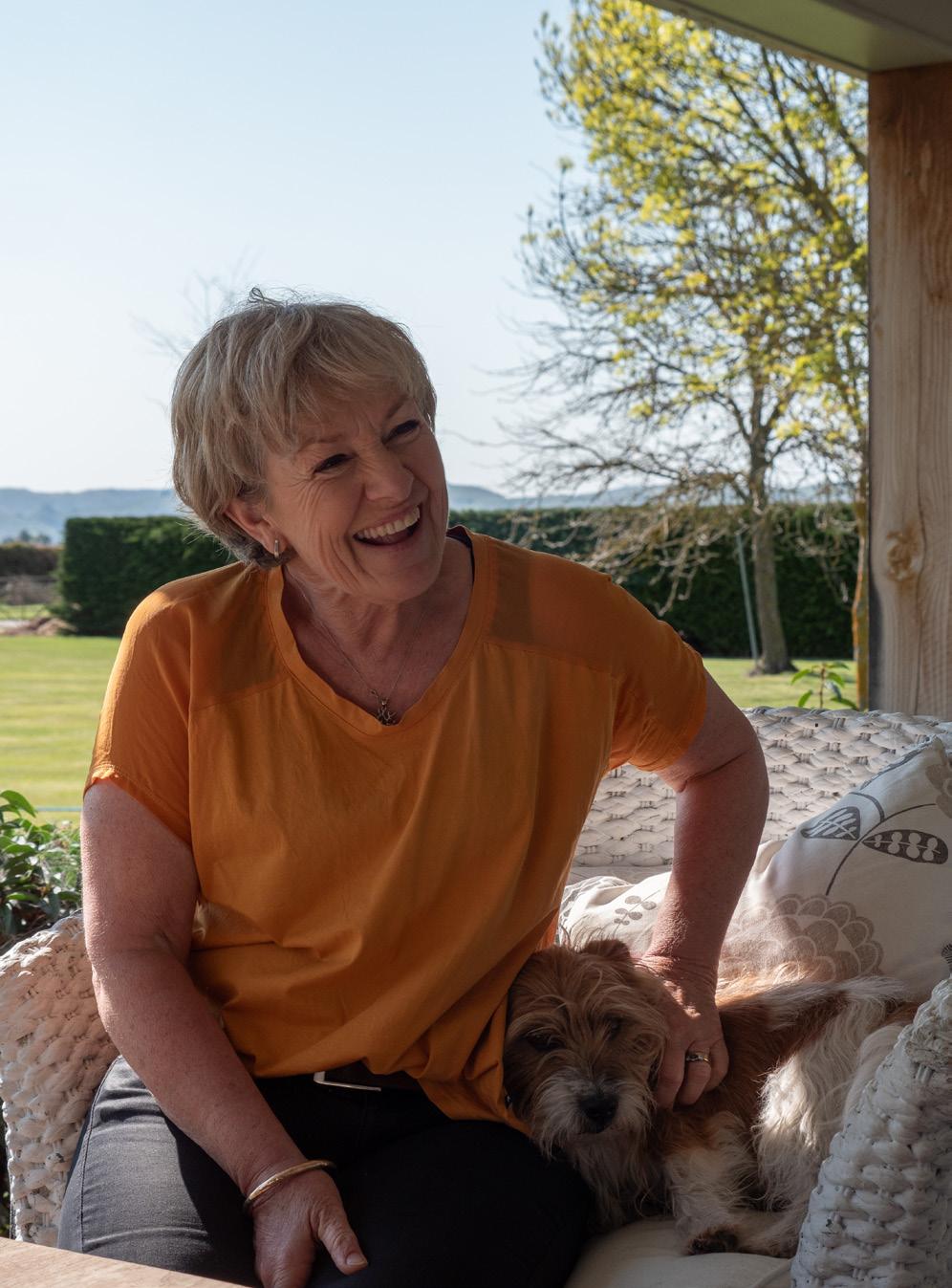

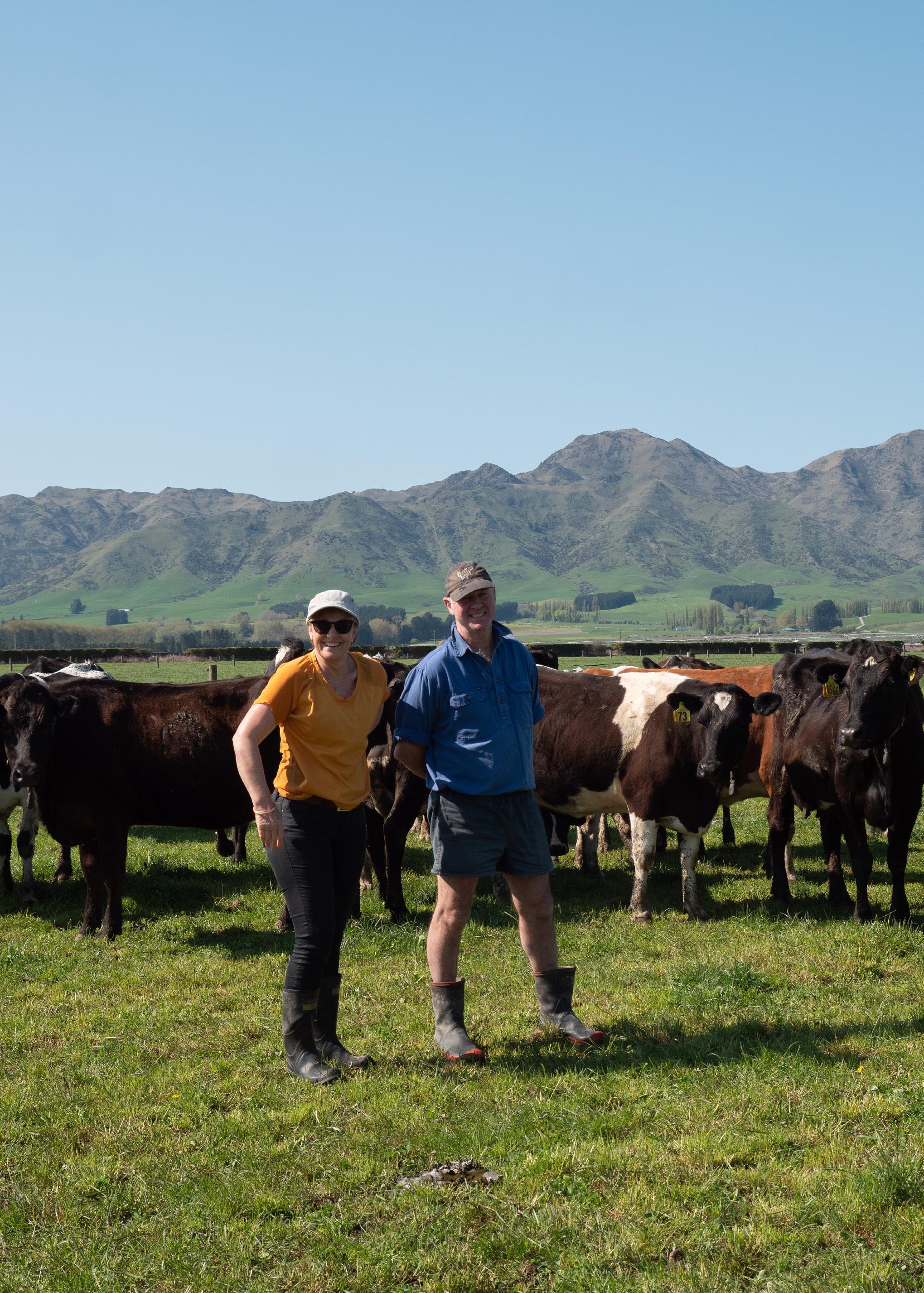
He says it’s amazing how many times there will be some kind of discrepancy that wouldn’t have been picked up otherwise.
“I’d say every month it would amount to $500 to $1200, so it’s a very worthwhile exercise. I don’t have a problem ringing a supplier and challenging an invoice. It’s about putting some discipline around it and not just paying invoices without question.”
They also have a stipulation that anything put on account at the major suppliers such as Farm Source is accompanied by a note of who ordered or purchased it.
“The suppliers know the purchase needs a name, so again every purchase has some accountability attached to it,” Duncan says.
Once the invoices are approved and paid, Nicky will look at how the updated cashflow is tracking.
“I run my eye along the balance at the bottom of the page to see the peaks and troughs and make sure it’s what we’re expecting. Then I run a year-to-date variance report to see how we are tracking. If something is out of whack, I’ll look at it more closely and we [she and Duncan] will talk about it. If it’s something that’s come in a month early for instance, I’ll go through and update the cashflow.
“This season, with Fonterra’s milk price going up, it’s been nice to see the cashflow effects. I’ll email the accountant and make sure they are aware of the change it will make to our provisional tax liability.
‘So the key number for us is our annual cashflow surplus and balance sheet wise, what’s happening with our debt-to-equity ratio. The aim is equity growth.’
NICKY ANDERSON
“We don’t want any surprises when it comes to tax – it’s quite a change from the sheep and beef days to have to be thinking that way, but you do have to be prepared, as those tax payments make quite a hole in the cashflow,” she says.
The couple’s loan arrangement rolls their working capital and loan facility into one account with provision for principal payments to be flexible to match cashflow.
“Managing our cashflow is number one when it comes to our financials because it helps us minimise our interest cost and gives us visibility with which to make decisions on things that might pop up unexpectedly,” Nicky says.
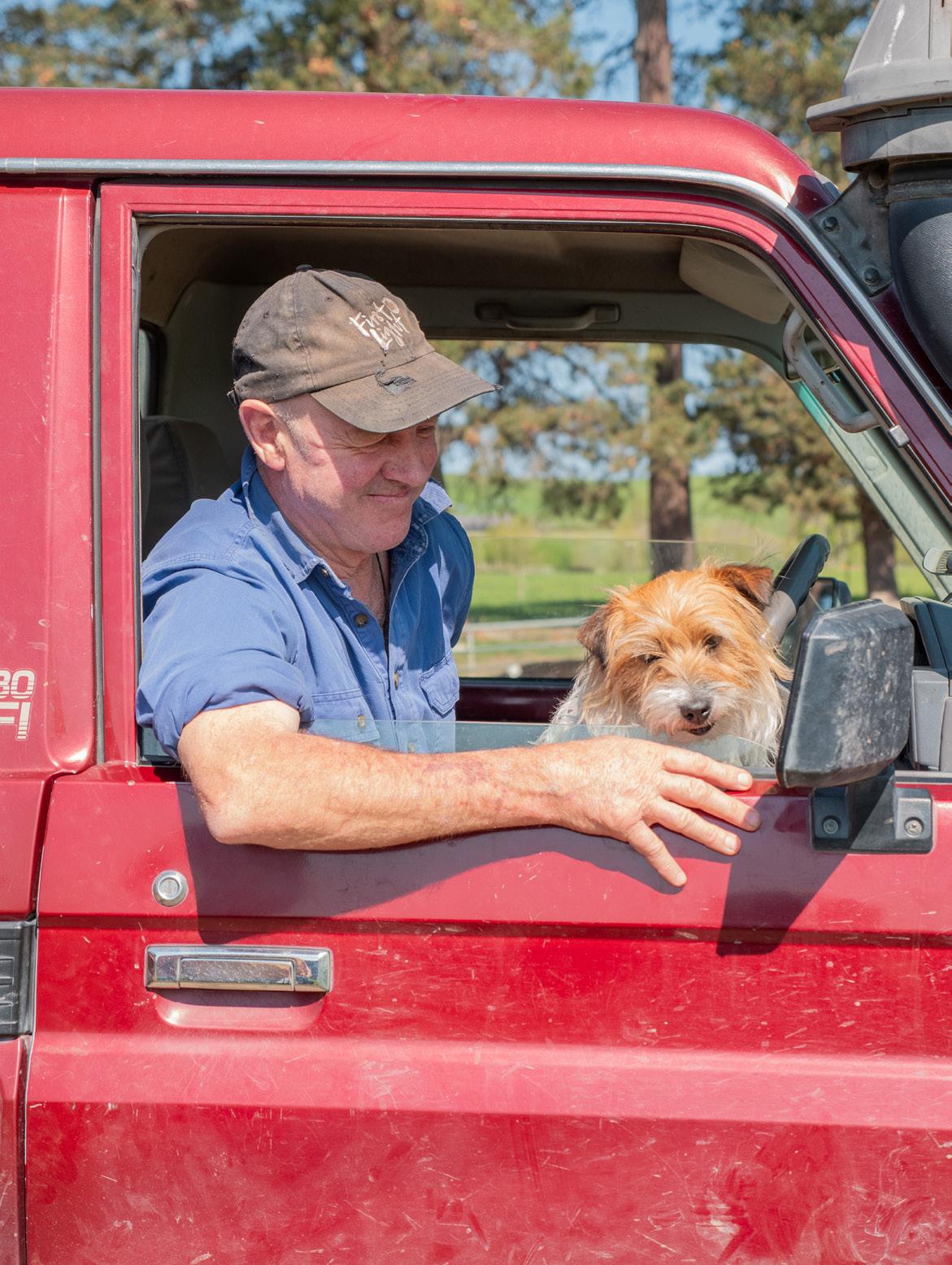
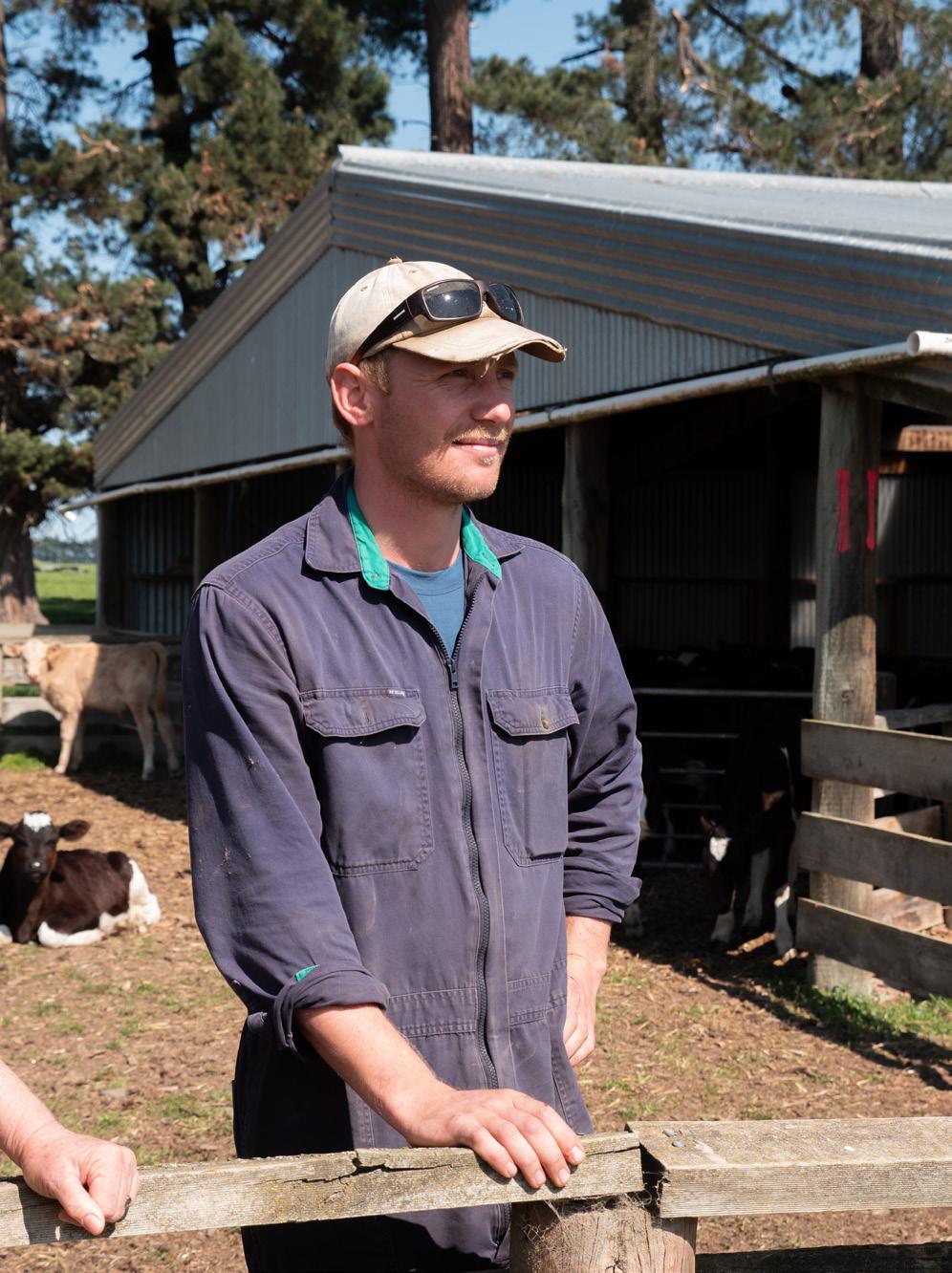
At any time Nicky and Duncan will know where they’re sitting relative to budget and how the monthly cashflow is panning out across the season.

“So the key number for us is our annual cashflow surplus and balance sheet wise, what’s happening with our debt-toequity ratio. The aim is equity growth. They’re the big numbers but they’re driven by all the little things and it’s important to keep an eye on them all the time.”
They’re interested in, but not focused on, return on asset or return on equity at the moment because selling the asset is not in their plans and land-use change isn’t in any near-term plan.
When they did the conversion, those numbers were important to secure funding from the bank. As they have grown, the numbers and the bank’s comfort with their financial management have enabled them to take on the next challenge. The change in return on equity from sheep and beef farming to return on equity from dairying put the compelling numbers around their initial investment.
“We know where we want to be and this is the best use of our assets right now. We’re not blinkered – if something came up that was better use of the asset, we would definitely look at it,” Nicky says. “Because we’re all over our financials, we
have that information at our fingertips and we could quickly compare returns and see if something else would get us to the goals we set out.”
Having a good understanding of their financial position at any time and having good communication with their banker and accountant means the conversations with those professionals are ones more of governance than compliance or micromanagement.
That’s helped in the succession style conversations with their rural professionals who are party to their goals and understanding how their boys’ farming goals work in with the overall family enterprise.
Good communication and a good relationship with everyone you work with is a big part of all this, Duncan says. This includes people onfarm and off it.
“The sooner you can get everyone around the table and understand the goals, understand the numbers, then you can actually take control and make things happen. You get to drive it.” he says.
Financial literacy can become complicated with a biological business like dairy farming, with so many moving parts which can influence the year’s profit. Tracking farm performance in real time is key to keeping control of the budget.
Words
SHERYL HAITANA
When your income isn’t fixed and it fluctuates, it can be challenging to have a handle on your finances mid-season and predict where you are going to land.
Keeping to a budget with a biological farm business, which is directly influenced by weather, can be difficult and farmers need more information at hand to keep financial control.


tools out there, but they are based on the past, what happened last season.”
As an example, Southland farmers who have had a terrible spring this year would be able to input their lower pasture covers, account for extra supplement they’ve used, their unexpected costs, and the model will show what their new expected production is and how to budget around it.
‘Farmers need to be able to run different scenarios, and know what the outcome is on their farm, their finances, and now their greenhouse gas profile.’
FARMAX is a modelling and decision support tool that can help farmers accurately predict the impacts of the business decisions they make during the season.
When it comes to improving financial literacy, it allows farmers to act in real time and look ahead at what decisions they make today will do to their bottom line for the season, FarmIQ B2B channel specialist Craig Trotter says.
“It allows farmers to look through the windscreen instead of the rearview mirror. There are a lot of financial benchmarking
Layering emissions outcomes across a farm management plan also requires a new skill of financial literacy. Farmers now want the ability to model various scenarios on their farm operation to factor in environmental outcomes that work alongside financial performance, Craig says.
“Farmers need to be able to run different scenarios, and know what the outcome is on their farm, their finances, and now their greenhouse gas profile. For example, if they drop 50 cows out of the system, what happens to their
milk production, to their profit and their emissions intensity?”
Having the ability to track farm performance and benchmark against other farms throughout the season is of huge value, Macfarlane Rural Business farm consultant Jeremy Savage says.
FARMAX’s Dairy Systems Monitoring (DSM) is the tool Jeremy and his colleagues use to help their clients not only analyse their past performance, but see what performance could look like in the months ahead.
“We get 50% of the value from being able to review farm performance through the season and benchmark against farms. The other 50% is strategy – have we got the right farm system? We can see what the top-performing farms are doing in the area and ask, ‘How do we do that?’”
The bonus of DSM is it has all the farm records, from pasture growth to environmental footprint, so farmers can use the data to create reports to share with ownership structures, councils, dairy companies, etc., Jeremy says.
The DSM tool does take a bit of driving and wisdom to interpret the data, so having a skilled farm consultant onboard is key, he says. Visit farmax.co.nz
Pulling in your financial advisers to play the right role depending on your financial skill level will elevate your decision making and business outcomes.
Words ANNE LEE
If numbers and managing your finances don’t come naturally to you or it just seems like a chore, that’s okay, but don’t put your head in the sand and pretend you’ve got the financial aspect of your farming business covered.
BDO accountant and advisory partner Frazer Weir says the most important aspect of managing your finances is being honest with yourself when it comes to your skill level, your desire to build those skills and how much time you want to spend working with the numbers.
“Our farming businesses are becoming more and more complex and having a good handle on your financial position is important, but that may mean different things for different people.
“When I look at our client base, I have three groups of clients and how I work with each group is quite different.
“The first is the group of people who love numbers. They live and breathe financial statements and budgets, they are in their accounting and business software all the time, they update their budgets so they have a full, live cashflow, they focus on their balance sheet and they love it.”
He sees his role with them as challenging them, testing some of their assumptions to make sure the numbers are right, monitoring their key performance indicators (KPIs) against the progress they want to be making, being a sounding board and having the searching discussions.
“That group of people can sometimes see their accountant as only necessary to run their tax calculations so they’re being tax efficient and prepare their accounts for that purpose, but there’s value for them in having those higher-level financial discussions to make sure they’re on track for the goals they set.”
The second group covers the majority of people, he says.
“They’re the ones who really run the business very well. They do the GST returns, they have good clean sets of financial statements and accounts, they are in their budgets and monitoring them but, ultimately, they don’t really know how to read the information and see what it’s telling them about the business.
“Those clients need someone to work with them who can turn the information into a language they understand so it
better informs their decisions and they can use it to run their business.
“For every client, the way we do that can be different too because people learn and take that information on in a variety of ways. Some people like bullet points in an email with a bit of added narrative around it; others want a conversation as well as a report.
“Farmers should be asking for it in whatever form suits them best. With the software we have now there’s no shortage of data, the whole world is awash with data points, but it’s about interpreting that data and putting it into a meaningful form, otherwise people can feel like they’re drowning in it – especially those who are in that second group.”
They’re the people who will benefit from courses and added explanation, because in each interaction they will be taking the learning on board and building on their skills to improve their financial literacy.
The third group of people are those who hate numbers and just don’t want to spend the hours needed on a regular basis to manage their accounts, do their GST or get in behind the workings of their financial software.


“It’s a chore and they struggle – and that’s okay – providing they recognise that and are truthful about it, because then they will be the ones who get the administrator in to pay the bills and do the GST and keep the software up to date.”
The big risk for a farm business, be that a contract milker or a farm owner, is if they’re not fully transparent about that.
likely those in group two) build an understanding of how their spending is tracking and what they’re spending money on, giving them more insight into their budgets. They’ll see problems earlier.
The belts and braces for those outsourcing their financial admin work will come from their accountant or farm adviser, Frazer says. Those professionals
‘The whole world is awash with data points, but it’s about interpreting that data and putting it into a meaningful form, otherwise people can feel like they’re drowning in it.’
FRAZER WEIR
BDO accountant and advisory partner
“Building financial literacy is great, but at the end of the day, if numbers don’t come naturally to you then just work to your other strengths and put a team around you to take that on,” says Frazer.
Farm and accounting software now makes it easy for an administrator to be based anywhere and have access to the information from farm suppliers to keep accounts up to date and do the GST.
“It’s not that long ago someone had to physically come to the farm and key in the information from paper invoices. That’s not necessary now. AI (artificial intelligence) is also being built into systems now so that more and more things are automatically coded.”
Those who manage their monthly accounts and do their own GST (more
need to be part of the team and are vital to ensuring the farming business is on track.
Being able to manage the cashflow, keep an up-to-date stock reconciliation, manage the outgoings but also the income side of the business by forecasting advance payments and stock income are all essential.
“If that’s not your strength, get someone on your team who does that. The worst thing you can do is put your head in the sand or say, ‘Oh no, I feel silly getting someone in to help with the admin,’ and then sit in the office for five hours every night trying to do the GST.
“That’s no good for anyone, and what’s more, you’re likely to get something wrong along the way and be left with bad information coming out of budgets, or
cashflow decisions are based on inaccurate data and the decisions are the wrong ones.”
People in group three can be just as good as people in group one and two at spotting an opportunity, being hungry to grow their business and being driven, but the quality of their decision making will be dependent on whether they’ve pulled people in around them with the financial skill sets they’re lacking.
“What we see in every group is those who do have a good understanding of the numbers – whether they’ve got there themselves or they’re using their accountant to translate and deliver that information – are then asking, ‘How do we use this to drive our business?’ And that’s where they’re using it in a governance sense and getting people around them for those governance discussions.
“They’ll be different depending on what stage of life they’re at and what their goals are, but understanding the financials is a critical point of those discussions. It might be about succession and stepping back and getting equity out of the business, or it could be about making the next step from a contract milking job.
“Quality financial information empowers those discussions and decisions.
Understanding your return on asset for instance will help you to understand if taking on more debt in the business is a smart idea.”
Frazer says people from every group need to seek out financial advisers to be on their team who understand the business of farming and expect more from them than preparing accounts for tax purposes.

Understanding what bankers are looking for and what key aspects of your finances you should build skills in can make a big difference to successful borrowing.
Words ANNE LEE
Ex rural banker, with 30 years experience, dairy farmer and professional director Peter Moynihan says building financial literacy can be a step-by-step thing. He shared some of his key take-home messages.
Understand good and bad debt. Good debt is taking on debt to purchase something that enhances your short- to mediumterm business viability and profit. It can be an asset that appreciates, reduces costs or increases income.
Bad debt is more likely associated with something that depreciates and does little to improve your business viability. Debt for consumer goods such as TVs could be an example.
Understand your cashflow and ensure you have banking facilities to manage the shortfall in cash during the seasonal variations.
Have buffers within your business. These can be cash, good fertility, up-to-date plant, spare feed and low contingencies.
Know your statement of financial position – your equity and debt – before you come to the bank to borrow money. Monitor that position closely throughout your career. It shows your progress and business strength.
Find out from the bank what equity ratio they require.
Don’t depend on your banker to be your key financial adviser, they are your banker. They are in the business of lending money,
that’s how they make money. Just because they are willing to lend to you doesn’t mean you should borrow it. They may have a different risk appetite to you and may over/under assess your ability.
To make a decision on whether they lend to you, your bank will want to know:
• Your equity and statement of financial position.
• That your business is or can be profitable. A realistic budget will be required with indications of how that budget will be achieved, or proof from previous accounts to show your profitability and capability.
• That you are capable and have the ability needed to deliver your plan.
• That your operation is compliant with regulations.
Use the data and information available from DairyNZ or your accountant to help build your budget and to benchmark your financials.
Talk to your banker about what their specific bank expects. Find out what your bank’s interest coverage ratio or debt coverage ratio is. This ratio shows your profitability and ability to service debt. An interest coverage ratio of 1 is when you make enough money to maintain your farm but make no cash surplus. Most banks would be looking for a ratio of greater than 1.2, know
Don’t depend on your banker to be your key financial adviser, they are your banker.
this figure. They would use a standard medium-term interest rate for the calculation of budgeted interest, so find out what that standard interest rate is.
Learning how to do sensitivity analysis can help when assessing future options. What happens to profit/cash when key variables change? Where is the critical point where you don’t make money?
Understand your breakeven milk price.
Total income - expenses including* = breakeven milk price
*Total expenses include farm working expenses, interest and rent, tax, drawings, principal repayments if required from the bank, asset replacement allowance.
Know your strengths and weaknesses. While you’re learning or if you can’t or don’t want to improve a skill then pay someone to do it for you and get help and advice. There are plenty of people who are very successful who outsource their financial management by having a good team around them.

Total income - expenses* = breakeven milk price
*Farm working expenses, interest and rent, tax, drawings, principal repayments if required from the bank, asset replacement allowance.
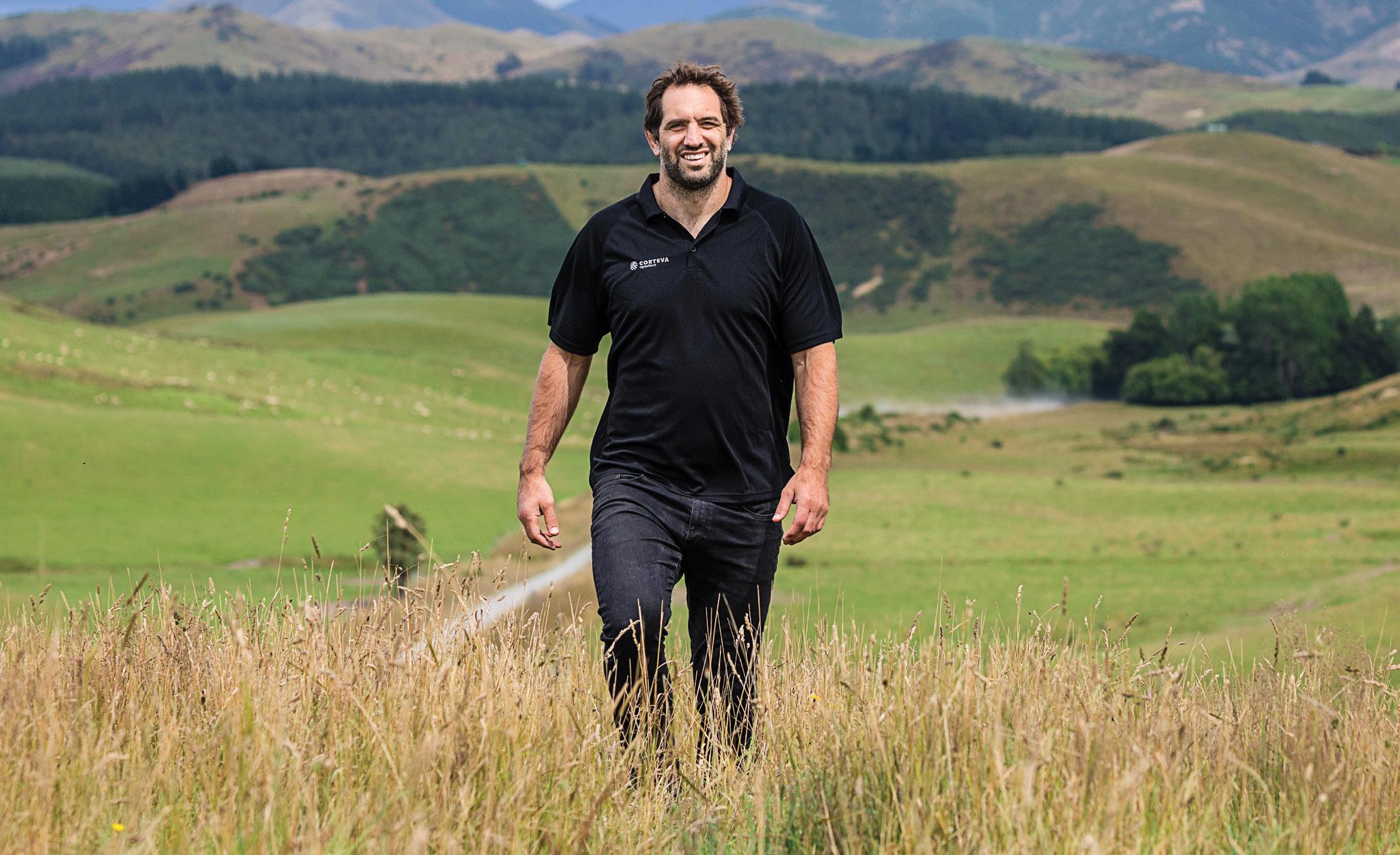
Watching
Our portfolio of powerful, proven products has helped farmers from one end of the country to the other create and maintain thriving businesses, and has earned us an excellent reputation as pasture protection and brushweed specialists. Our extensive suite of herbicides provides farmers everything they need to win the war against weeds and brushweeds. Visit corteva.co.nz to view our online pasture and brushweed resources.































Aseries of devastating weather events and a sharp rise in inflation is behind eye-watering increases in the cost of insurance in recent years for all New Zealanders.
All farm businesses have been hit with big increases in insurance premium charges. Getting a fix on how large the increases are is difficult but some farm businesses are reporting it could be 20% or more in the past year.
A recent analysis by farm consultancy business BakerAg found premiums for one sheep-beef business client had increased by 83% between its 2020–21 financial year and the forecast in 2024–25 for the same level of cover across the same asset mix.
Global news is full of coverage of disasters and damage caused by flooding and wildfires. Weather events seem to be increasing in frequency and intensity, and on a larger scale across many countries.
New Zealand is not immune to the same extreme events. Parts of the North Island last year experienced two of the
most significant weather-related events in decades and both had a big flow-on impact on the cost of insurance premiums for farm businesses.
Widespread flooding occurred over the upper North Island during the Auckland Anniversary Weekend and this was followed soon after by Cyclone Gabrielle which wreaked havoc on the North Island’s east coast, resulting in five deaths and pushed the total cost of damage from extreme weather to just under $4 billion for the 2023 year. To put that in context, the cost in the 2022 year was just $351 million, less than 10% of the 2024 year.
The severity and frequency of these types of events is changing the risk profile of NZ when local insurance providers buy what is called “reinsurance”.
Reinsurance is a word often mentioned after major events or in a breakdown of the key factors which make up an insurance premium (see breakout on what makes up a premium).
Reinsurance is insurance for insurers so they have their own set of insurance policies to protect themselves against the financial implications of one-off major events, like flooding, cyclones or earthquakes.
It is purchased on a global market and, to give some indication of its growing importance to the insurance sector, it is expected to triple in size within the next decade, from US$642.37 billion in 2023 to reach around US$2000.08 billion by 2034.
When an event like Cyclone Gabrielle occurs, insurance providers use reinsurance to recover part or all of an insurance payout from their reinsurer.
Insurers use the additional financial cover to help make sure there are enough funds available to pay out their customers’ insurance claims and also reduce the risk of falling into financial difficulty as the result of a major event.
Part of every customer’s insurance premium goes towards covering their insurance provider’s reinsurance. As the number and cost of weather events and natural hazards increase, so does the cost of reinsurance and, therefore, the amount of premium charged to customers.
Keeping these global reinsurers willing to invest in the NZ market could be an increasing challenge, given the rising frequency and severity of weather and wildfire events in recent years.
Steve Johnston, the boss of trans-Tasman insurance company Suncorp Group, was reported in late September saying he had to convince its reinsurers to keep providing cover for policies offered by its NZ subsidiaries, Vero and AA Insurance. He said Suncorp New Zealand’s reinsurance costs rose by 36% in the past financial year because of the magnitude of the 2023 weather events.
Insurance companies already limit new business in areas where they already have a large concentration of risk or they want to reduce the financial risk to the business if a major disaster strikes.
With sea levels forecast to rise as the climate warms, some insurers are already either insisting on much higher excess levels for homes and buildings cover, or excluding homes and buildings in some coastal areas.
Inflation is also influencing the size of premiums paid for insurance cover. According to Statistics New Zealand, insurance cost inflation rose by 14% in the year to June 2024, making it one of the most significant contributors to the consumer price index (CPI).
Insurers are dealing with rapidly increasing costs for repairs or replacement of damaged and lost items or infrastructure. Even lower-value items typically covered on a replacement cover, such as vehicle windscreens or mobile phones, have more technology built into them than before, so the cost of replacement has significantly increased.
Also contributing to premium costs is the impact of fraudulent claims, estimated by the Insurance Fraud Bureau New Zealand at $994 million for the year to date. Fraud ultimately costs clients through increased premiums.
Just 46% of a total insurance premium typically remains with the insurer providing the cover according to the Insurance Council of New Zealand.
It says about 12% pays for reinsurance cover bought on a global market by an insurer to protect itself against the financial impact of one-off major events, like flooding, cyclones or earthquakes.
The balance of a premium comprises government levies and taxes – Fire and Emergency New Zealand levy (5%), Natural Hazards Commission levy (24%) and GST (13%).
The Natural Hazards Insurance (NHI) levy is collected by all insurance companies on behalf of the Government and helps fund earthquake and other natural hazard insurance cover provided by the Natural Hazards Commission (NHC). Insurance companies include them in their premiums and ensure they’re passed on to the Government.
The Fire and Emergency New Zealand (FENZ) levy is collected by all insurance companies on behalf of the Government and funds FENZ to deliver fire and emergency services to all New Zealanders. Insurance companies include them in the premium you pay and ensure they’re passed on to the Government.
In NZ, the Natural Hazards Commission (NHC) provides first-loss insurance to landowners for most natural hazard risks. Cover is capped for insured homes and residential land, and private insurers can provide additional cover above that amount if required.
NHCover and EQCover are the Government’s natural hazards insurance provided by the Natural Hazards Commission for homes and some residential land. Claims lodged after July 1, 2024, fall under the Natural Hazards Insurance Act 2023 and are known as NHCover claims. Those lodged before July 1 this year fall under the Earthquake Commission Act 1993 and are known as EQCover claims.
For commercial buildings, including those on farms, the National Hazards Commission levy is based on the sum insured rather than the flat fee set for domestic buildings.
The FENZ Levy for farm buildings is also based on the sum insured and for vehicles, fees vary based on the weight of the vehicle.
Dairy farm businesses should be insuring farmhouses, the domestic contents of the farm owner’s family, farm buildings, farm contents, business interruption, milk for spoilage, contamination or non-collection, and liability insurance.
Milk contamination liability is a must and covers the farm business in situations where contaminated milk is picked up by the tanker and mixes with uncontaminated milk from other farms on the collection round.
Depending on a farm owner’s appetite for risk, they may opt to self-insure smaller, easily replaceable buildings, or lock in higher excesses on them to reduce premium costs.
Farm employees should have their own domestic contents insurance, but their farmhouse needs to be covered to an appropriate level for loss or damage.
Livestock insurance is also available on dairy cows but is used mostly for high-value stud animals.
Insurance to cover business interruption is recommended for dairy farm businesses to provide cover for when an event prevents the milking shed from being used. Liability insurance for the farm business and its employees is always recommended.
Brokers ensure competition and best fit for farm insurance.
Independent brokers play a key role in the insurance sector, bringing competition and the experience required to match the right package of cover to the specific needs of a farm business.
Experienced insurance broker Matt Stent says one of the biggest advantages for any individual or business is the advocacy and knowledge brokers offer when a client has a claim.
“You get direct access to your broker at claim time, they work for their client, collecting all the information for the insurer and then they advocate for their client to achieve the best settlement possible,” he says. “If a claim has been declined or a limit is reached, then the broker is there to explain the reasons for that too.”
The personal service offered by brokers is available directly from most insurance companies, but most apply a premium threshold which determines if a farm business is assigned a representative or they are channelled into an online “self-help” process or 0800 call centres for advice, claims and feedback.
Stent says brokers should provide a detailed assessment of a farm’s insurance requirements, captured during an initial site visit, before quotes are sought from multiple insurers. This means farmers avoid the need for arranging quotes from several providers or working directly with one insurer and not seeing what others might offer for the same package.
By working closely with a farm business owner, he says a broker is able to discuss whether the standard provisions on offer from most insurance companies are sufficient or not.
“Then you can work with them on their risk profile to tailor the package to their specific needs by working together on setting excess levels and whether they want to do some sort of selfinsurance.”
He favours at least an annual site visit and review unless an event triggers the need for intervention.

“It’s amazing what you see when you actually go to someone’s farm or site. Even if you’re just preparing a quote for new business and you’re walking around with the client, you often see items that are not covered by existing insurance policies.”
Stent works closely with two rural insurance providers, Vero and NZI, to provide cover for his clients. Some insurance firms will only deal directly with clients rather than through brokers.
Brokers are paid commission by the insurance company and this is factored into the premium. The fee percentage varies depending on the insurer and the items being insured, but they must be fully disclosed every time. Stent says some brokers charge administration fees on top of the commission they receive, but these must also be disclosed.
Not having all items insured and sufficient cover is an issue for most businesses, and farms are no exception, Stent says.
“Whether it’s just not updating the sums insured or they are missing something off their insurance policy that should be on it, a lot of farms will be under-insured.”
More than $4 billion in insurance claims has been paid out following the 2023 Cyclone Gabrielle event which devastated the North Island’s east coast regions. But many farm businesses were still caught out by not having all their buildings, contents and livestock covered appropriately.
Stent says under-insurance is driven by genuine errors in collating all the items to insure or farmers taking the risk not to insure items. When cash is tight, it’s understandable that farmers will look to reduce their spending and consider their risk appetite for bearing the cost of replacing items lost, damaged or stolen.
“It’s about weighing up the risk on something lost once in a 100-year event against not having to pay the insurance premium for the 100 years.”
As the old saying goes, insurance is a cost until you need it.
“It is a necessary evil in a lot of people’s eyes. It’s not until they have a big event and have a large claim or a loss that they actually appreciate it,” Stent says.
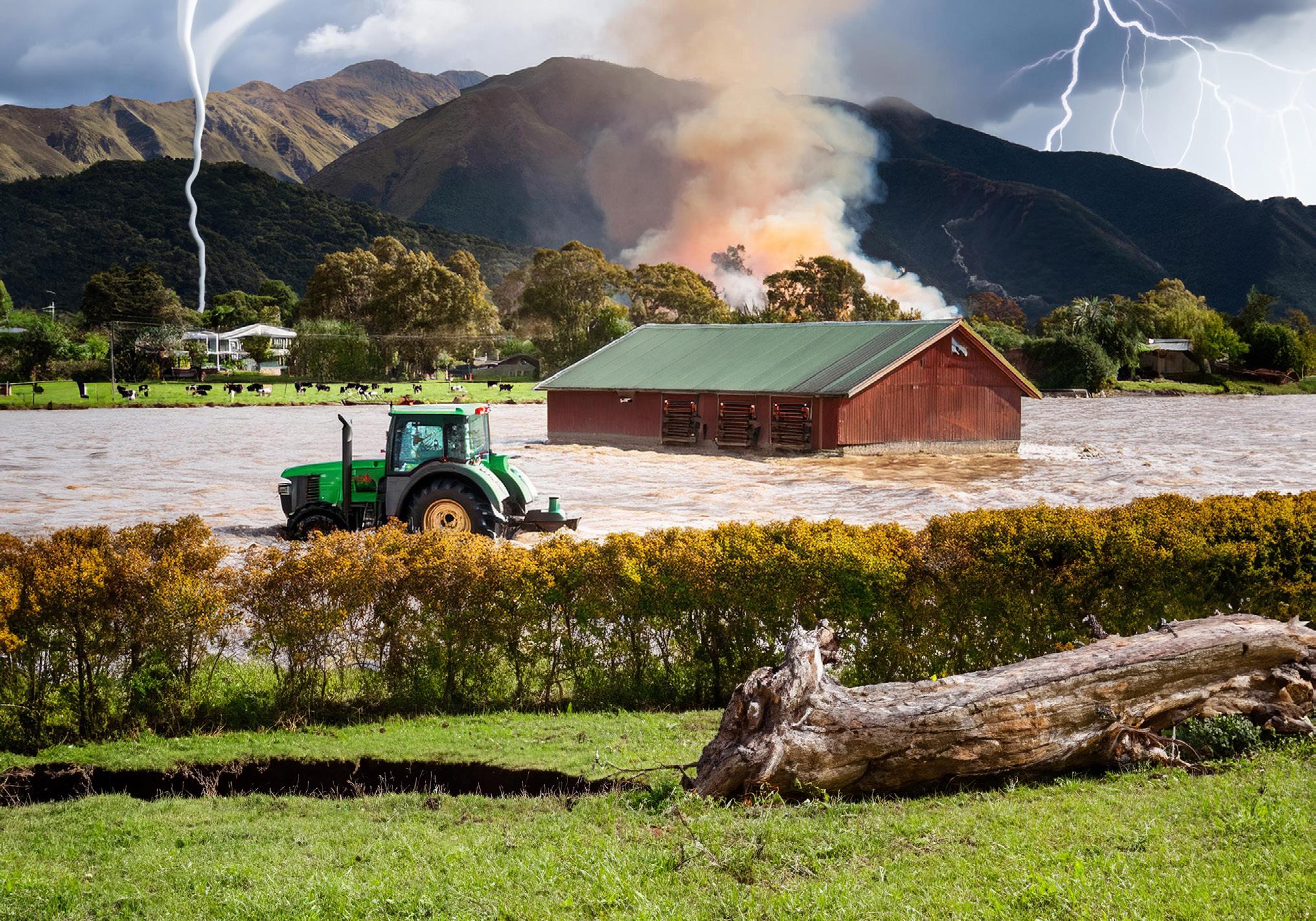
Regularly reviewing the “sum-insured” values for all the assets owned by a farm business and increasing the excess levels on some items are good strategies for reducing insurance premiums.
Experienced independent broker Matt Stent says ensuring values for each asset category covered are insured to the correct level or limit should avoid the risk of over-insuring items.
“This is especially important for assets that depreciate like vehicles and tractors because they’re generally on a market-value policy. If you’re not reviewing those sums insured, you will be paying a premium based on that higher value and you will not get paid out for that if you have a total loss to claim,” he says.
There are some online tools available for valuing vehicles, including on the Trade Me platform.
“The annual review is a great time to amend sums insured on buildings, vehicles, and other limits to make sure that at claim time you’re not going to be blind-sided.
“Building values, generally speaking, for reinstatement should be increased in line with inflation and increases in building costs. But vehicles are mostly on a marketvalue basis for settlement, so their values should be reduced to match that as they depreciate.”
He also advises keeping the excess level for contents cover at a lower level because claims tend to be more frequent.
“But when insuring a house, you can increase it from the standard $400 to $1000 or even $5000 because a claim for your house is generally going to surpass
that level anyway. And remember, $5000 is about one square metre of a house rebuild cost these days in many areas of the country,” he says.
Packaging all the farm’s insurance needs and offering it to a range of insurers can also deliver savings in premiums.
“It also gives you more sway with insurers when they have your total business. They will look after more because they don’t want to lose you, and there are discounts on total premium cost too.”
Having a farm security system in place along with fire protection and well-maintained buildings that are secure is also a bargaining point in premium setting discussions.
As a minimum, a fire-only or fire and burglary policy on farmhouses still qualifies for cover in a natural disaster through the Natural Hazards Commission.
It could also be worth considering if a farmhouse was burned down, would it be replaced or is there sufficient staff accommodation available, or if it would be replaced with a home of the same or lesser size and standard?
In the same way, would the farm’s main home be replaced with a similar-sized or specification home if it was lost through fire? Insuring to a set value could make good financial sense if there is scope to scale back to a more modest-sized new home.
Insurance reviews might be considered a low priority task by many farm business owners, until they endure a major event like an earthquake, fire or flood. It is essential to be well prepared for annual reviews, and to ensure you are aware of your insurance needs and existing policies.











An online survey of 518 people was conducted between December 2023 and January 2024 with those who work or live on farms to understand their insurance needs, perceptions and behaviours.





Used Considered Aware of

• They are aware of 3.0 providers on average that offer Farm/ Business/Rural insurance.
• And they would consider 1.6 providers on average.
• FMG have the strongest share of the General insurance market.








Have a thorough check, potentially look at other providers and reconsider my options
Have a bit of a check, but don’t really think about looking at other providers
Just let it roll over without thinking too much about it
Health/Medical Personal General
Those on Commercial farms (94%) are more likely to have this type of insurance than those on Lifestyle blocks/Hobby farms (65%).
There is a mix of how they look at their insurance when it is due for rollover: Around a quarter have a thorough check of their insurance – looking at other providers and reconsidering their options (though more do for their Farm/ Rural/Business insurance).
• Just under half have a bit of a check but don’t really think about looking at other providers.
• While the remainder are happy to let their insurance roll over without thinking too much about it (more so for those with Health/Medical insurance and less so for those with Farm/Rural/Business insurance).
General insurance has the most switching behaviour while Health/Medical insurance has the least.
So, what has driven their switching behaviour?
42% – Finding a better price elsewhere
• 35% – High cost of current insurance/premium increases
• 29% – Getting more appropriate cover from another provider
• 29% – Getting poor service from current provider
• 18% – Consolidating insurances to one provider
16% – Taking advice from someone else
• 12% – Getting offered an incentive to sign up with another provider
Cinta Insights has been providing insights to the Rural and Agri sector for more than 20 years. Backed by New Zealand’s largest standalone community of farmers and agriculture workers, Cinta delivers a clear opportunity for New Zealand farmers to have their say on topics and issues that impact them directly.
In joining the Cinta Collective you will have the opportunity to earn rewards, donate to important rural charities (Rural Support Trust, Rural Women and NZ Young Farmers), and of course help shape the future of farming in New Zealand!
To sign up for the Cinta Collective, donate to charity, and have a chance of winning a $250 Prezzee Card please scan the QR code.

With more significant weather events occurring, insurance companies globally are applying a new policy for farmers to insure against events rather than insuring assets.
Words SHERYL HAITANA
FMG is exploring the integration of parametric insurance into their offerings, potentially adding a valuable tool to complement the traditional insurance model.
By insuring for specific events rather than the assets themselves, parametric insurance opens up new opportunities for faster claims processing and enhanced client support during large-scale events.
While this exploration is exciting, it also comes with challenges. Understanding and adopting parametric insurance requires a shift in mindset, as it represents a different approach compared to traditional methods.
“Indemnity-based insurance is the model we are more familiar with – a claim is made by the farmer, the insurance provider reviews the claim and sends out someone to assess the damage,” says FMG head of client strategy and advice Lucie Douma. “Once the assessment is done, the amount is agreed upon for the damage.”
Parametric insurance, although not a new concept, has gained more attention in the last few years, especially due to the rise in frequency and severity of weather-related events, Lucie says.
Instead of compensating for the loss suffered, parametric insurance pays out when predefined parameters are met, such as a certain amount of rainfall over a specified period. It is designed to provide a quick payout, helping people make swift decisions to manage their financial risk when the unexpected happens. It can also cover risks that are otherwise difficult to insure against in the traditional market, such as the impact that flood and drought have on cropping.
For example, a wheat farmer can buy a policy that automatically pays out a certain amount if the rainfall during the growing season falls below a specified level, indicating drought, or alternatively, excessive rainfall detrimentally affects crop yield. The likelihood of such events and associated pricing is determined using historic weather data with future modelling, like rainfall, flood data or soil moisture.
The policy is managed by setting up predetermined parameters (triggers and thresholds) agreed upon at the time of purchase. If the rainfall during the covered period falls outside the specified thresholds, the policy is triggered, and a payout is made without the need to assess the loss. Independent and verifiable satellite or weather station data is used to determine when an event has met the defined trigger.
“The benefit to New Zealand farmers is this is bespoke insurance. It’s targeted to your property, you agree to all the terms and conditions upfront,” Lucie says.
By insuring for specific events rather than the assets themselves, parametric insurance opens up new opportunities for faster claims processing and enhanced client support during large-scale events.
While parametric insurance is showing itself to be a useful tool for Australian farmers to better cope with weather risks, it also has some drawbacks. It doesn’t pay farmers exactly what they lose, which means there is a chance of paying too much or too little, or not paying at all, depending on how the weather data matches their situation.
FMG is exploring the use of parametric insurance as one of many new options that could help farmers and growers better manage their risks. Feedback from clients show most recognise the benefits of protecting cashflow and the speed in which payments could be made, but they are also mindful that the policy may not address the full extent of damage or loss as it only responds to the event itself.
FMG learned that while the concept is simple in application, it is not simple to explain.
It takes a mind shift from the traditional insurance model of thinking about overall physical damage, to thinking about the weather event itself.
CelsiusPro offers a Wet Harvest Weather Certificate to Australian farmers to protect against crop downgrades due to excessive rain, with instant payouts and no need for damage assessments for claims. The cover includes singular heavy rain days and extended rainy seasons. Farmers purchase this certificate for harvest, where too much rainfall can result in time delays and downgrades in the quality of produce. Growers can lose up to 30% of their yield in just three weeks if rain persists through this time. Premiums cost approximately 3% of the grain’s sale price.
A grower in NSW understands that they face two risks during their harvest window:
1. Heavy rainfall on any given day.
2. Sustained rainfall throughout the harvest window. Each could result in a downgrade and both risks usually occur simultaneously. The grower agrees to purchase a Wet Harvest Weather Certificate to cover a 30% downgrade worth $200,000 with the following parameters:
• Risk Period: October 10 – November 30
• Max Payout: $200,000
• Premium: $12,400 (6.2%)
Rainy Day Parameters
• Threshold: 20mm (level of daily rainfall which defines a critical day)
• Strike: 1 Day (begins paying on the second critical day)
• Tic: $50,000 (the amount paid per critical day)
• Max Payout: $100,000 (occurs at 3 days of rain greater than 20mm)
Rain Season Parameters
Strike: 110mm (the level at which the certificate begins to pay)
• Tic: $1000 (the amount per mm you get paid)
• Max Payout: $100,000
Historical Payouts
2010: Received 2 rain days over 20mm and a cumulative total of 192mm of rain. The payout would have been $50,000 (Rain Day) + $82,000 (Rain Season) = $132,000.
Visit celsiuspro.com
Educating and upskilling people on dairy farms is imperative to driving down risk and creating a more profitable business.
Words SHERYL HAITANA
The risk of penicillin milk ending up in the vat equates to thousands of dollars down the drain. Even if it is insured, the excess, along with the inconvenience, logistics, and sense of failure within the team, can contribute to the fallout.
Milk claims are one example of a risk that can be prevented on farms with good processes and education. Engaging staff and investing in their future is a key part of not only improving a farm’s performance but also laying the foundation for a strong dairy industry.
“The more people are engaged, the less likely they are to make mistakes,” says FMG North Island rural manager Jason Rolfe.
“From an insurance perspective, if you have a high level of skilled staff who are more engaged, you have fewer preventable claims – fewer milk claims or vehicle accidents.
“We have insurance for when these things happen, but, for example, with milk claims, it’s the inconvenience of it, the downtime, and a lot of dairy companies now have incentive programmes, which can lead to another financial loss. We want to help our clients minimise some of this risk.”
FMG is partnering with industry events this season to help educate and upskill people to promote a stronger dairy industry. Supporting this next generation is fundamental to a bright future for the dairy industry, Jason says.
“We want a successful New Zealand dairy industry that leads the world, and that starts with people.”
Farm employers can help retain staff in their businesses by investing in them, including giving them time off to learn new skills, Jason says.
“Whether it’s upskilling in milk harvesting, mating, or body condition scoring, all these things add up to a more profitable business and reduce some of the preventative risks in your business.”
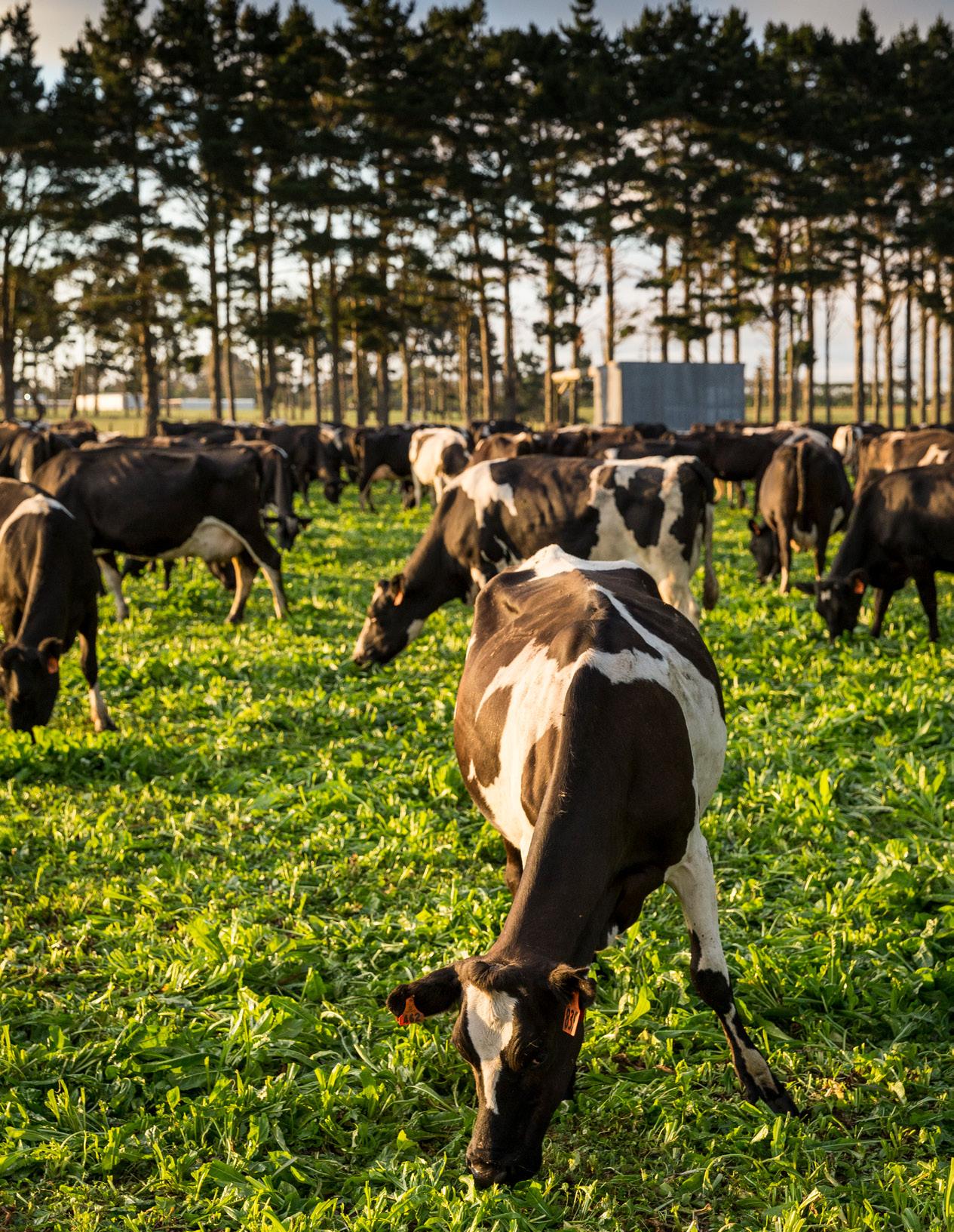

FMG is also keen to help educate the future contract milkers and sharemilkers entering the industry to ensure they have a positive future. Sharemilkers and contract milkers are the people the industry needs to come through and purchase farms in the future to keep NZ’s dairy sector strong and protect rural communities, Jason highlights.
Contract milking can be a precarious step for people transitioning from earning wages if they haven’t received enough advice or guidance to ensure they are signing the right contract and have all their bases covered.
“For a contract milker, if there is a vat of contaminated milk, they not only lose their profit but also have to reimburse the farm owner. They don’t necessarily have the cashflow or asset base to absorb these losses.”
Many contracts are signed in haste as people are eager to secure a job, but both parties need to sit around a table and discuss insurance coverage, he points out.
People need to have conversations about liability insurance regarding claims and who is responsible for what. For example, if there is damage to the farm dairy and the contract milker cannot milk the cows for the rest of the season, does the farm owner have insurance to pay the contract milker out for a set amount of production?
Visit fmg.co.nz
With
a rosy start to the global milk picture for NZ farmers, and downward pressure on some key onfarm costs, farmers could be in line for a better margin profit this season.
Words ROSALIND CRICKETT
With the 2024–25 dairy season chugging along in New Zealand, the current sentiment is one of cautious optimism, particularly when looking at where the industry is sitting relative to this time last year. Pricing buoyancy on the Global Dairy Trade (GDT) platform in the last few months has provided a more bullish start to the production year, with stronger demand and prices seen for dairy commodity products on offer.
Dairy commodities have enjoyed stronger prices when considering the levels they were at this time last year. Milk powders in particular have seen a resurgence, with the return of North Asia buyers to the market. At the time of writing, main ticket item whole milk powder (WMP) is sitting at its highest price point on the platform in the past few months with an average of US$3559/t – carrying an average premium of approximately US$500/t of where it was a year ago. Milk fat products also continue to outperform where they were a year ago, despite seeing slight downward pressure through September and early October events – anhydrous milk fat (AMF) sitting at an average US$7123/t and nearly US$2000 more expensive than October 2023. Butter is much the same for the time being, carrying a near US$1500/t premium from a year ago at an average price of US$6407/t.
On the NZ milk production front, general on-the-ground sentiment from farmers has also been fairly upbeat, with overall nationwide milk production
up 8.3% in the season to date (June –August) when compared to the same period last year. August production alone was up 10.0% compared to August 2023, with 123,823,000kg produced for the month. Less rainfall in the North Island, in particular the Waikato and Taranaki, saw less pasture damage and supplementary feed requirements. Weather conditions have also meant an early start to the calving season nationwide, smoother wintering for livestock, and reduced pasture damage. This has been with the exception of Southland, however, which has faced significant rainfall. As it stands, NIWA’s prediction of a La Niña weather event is 50–50 by the end of spring.
Breaking down global milk production, other major producing regions have not seen the same degree of YoY growth as NZ, with the US reporting a YoY decrease of -0.2% in September. Argentina saw a drop of -4.0%, Uruguay fell by -5.5%, and Europe’s July milk production was flat on 0.4%. Weather conditions as well as factors such as the spreading of the avian flu in the US and bluetongue virus in the UK and Europe, have created production headwinds in this sense.
Fonterra’s recent release of their annual reports noted a final full year (FY) 2023–24 season payout of $7.83 per kilo of milksolids (kg MS) and a total dividend of 55 cents per share. While the
recovery in Farmgate milk prices (FGMP) would have been somewhat of a relief for dairy farmers, DairyNZ has noted an average breakeven cost onfarm of $8.01/kg MS as of September 16, 2024, meaning many farmers could be facing losses. While early in the current season, the outlook looks rosier, with Fonterra’s 2024–25 forecast midpoint sitting at $9.00/kg MS, while the NZX milk price calculator is currently depicting a price of $9.28/kg MS (as of October 3, 2024). DairyNZ has also cast a forward glance for breakeven prices for the current season, currently anticipating an average of $8.09/kg MS for farmers to cover their costs. With the official cash rate (OCR) dropping, and downward pressure on other input costs such as fertiliser, farmers may potentially see a slight reduction in this figure going forward.
If you would like to know more about how the NZX Dairy team can help you with insights on the industry, don’t hesitate to contact us at dairyteam@nzx.com


The following article is based on the Nuffield New Zealand Farming Scholarship report by Kylie Leonard. Kylie is a 2023 Nuffield scholar, and Taupō District dairy farmer.
As a 2023 Nuffield scholar, my journey into the world of profitable, sustainable agriculture began with a simple yet profound question: How can we transition agriculture towards sustainability? This led me to explore the crucial roles of environmental, social, and governance (ESG) factors, innovative technologies, and naturepositive practices in reshaping farming for a better future.
Historical context: The shift from security to sustainability.
Post-World War II, countries prioritised food security, leading to a boom in international trade. However, the Covid-19 pandemic exposed weaknesses in our food and fuel systems, revealing that agricultural practices must evolve to mitigate climate risks. This realisation has sparked a collective call for change, emphasising that the responsibility for this transition cannot rest solely on farmers.
Everyone in the value chain, from producers to consumers, must play a part.
During my travels, I discovered that many countries share concerns about food and fuel security. While some, like Norway, struggle to achieve self-sufficiency due to soil limitations, others, such as Aotearoa, New Zealand, have thrived by embracing innovative farming practices.
The role of farmers: Stewards of the land.
Farmers are at the heart of this transition. They are not just food producers;
they are stewards of biodiversity. A balanced framework is crucial, one that incentivises rather than burdens them. Farmers face dual pressures: local water quality issues and global mandates to reduce greenhouse gas emissions. Confusion surrounding these challenges can hinder timely action, highlighting the need for clarity and support.
The dairy sector, often criticised for its environmental impact, holds potential for significant positive contributions to climate risk. By enhancing nutrition, livelihoods, and environmental health, dairy can play a transformative role. However, achieving greenhouse gas reduction goals, especially in Scope 3 emissions related to raw materials, remains challenging due to financial barriers and perceived risks associated with sustainable practices.
The financial landscape: ESG and its implications.
A growing trend in international finance is the recognition of ESG factors as essential for securing capital. Lenders are increasingly favouring businesses that adopt sustainable practices. This shift has led to the emergence of a global market for green loans, reflecting a growing awareness of sustainability’s economic importance.
Yet, a disconnect exists between farmers and food brands. While brands set ambitious ESG goals, many farmers feel overwhelmed by the demands placed on them without adequate support. Transitioning agriculture towards
sustainability requires collaboration across the entire supply chain, with brands recognising the transition costs involved and directly funding farmers who undertake sustainable practices.
Consumer demand: A double-edged sword.
Consumer demand for sustainably produced goods is on the rise, but the willingness to pay more often lags. This disconnect raises important questions about how to fund sustainable agriculture initiatives. Instead of solely relying on consumer demand, it is often ESG stakeholders and market access requirements that drive change.
To overcome these challenges, collaboration is essential. Farmers and manufacturers can work together to offer nature-positive services. Innovative funding mechanisms, such as reverse auctions for ecosystem services, can empower farmers to engage in sustainable practices while ensuring financial viability.
Case studies: Learning from successful models.
Several initiatives around the world exemplify this shift towards sustainable agriculture:
• Arla Foods launched an 80-point sustainability programme allowing farmers to choose climate-positive actions in exchange for financial incentives. This approach emphasises transparency and rewards sustainable practices.
• Cargill’s RegenConnect Programme encourages regenerative agricultural practices tailored to individual farm conditions, helping farmers improve soil health and reduce carbon emissions.
• Athian, a tech-driven company, offers a platform for livestock farmers to measure and verify greenhouse gas reductions, providing carbon credits for sustainable practices.
• The Catskill Watershed Project in New York incentivises farmers to implement best practices, ensuring clean drinking water while fostering trust within the community.
These case studies highlight diverse strategies for integrating sustainability within agricultural finance, demonstrating that environmental stewardship can align with economic viability.
New Zealand's unique opportunity.
NZ has a unique opportunity to lead the way in sustainable agriculture by
leveraging its co-operative model, particularly through entities like Fonterra.
By adopting a landscape approach, farms can work collectively to achieve sustainability goals, integrating diverse practices that enhance both agricultural productivity and environmental health.
Transition payments and ecosystem services certification programmes can support farmers during this critical transition period. By recognising the contributions of farmers to environmental health, such as biodiversity enhancement and carbon sequestration, these programmes can incentivise sustainable practices.
A collective responsibility.
The journey towards sustainable agriculture is a shared responsibility that requires collective action from all stakeholders, including farmers, brands, and consumers.
To foster a resilient and environmentally responsible food system, everyone must engage deeply with the value chain, focusing on collaborative solutions.
In NZ, sustainability claims must be grounded in actionable practices.
As consumers expect accountability, brands must step up to support farmers financially in their transition to sustainable practices.
By prioritising ecosystem services and establishing transparent payment systems, we can empower farmers to make meaningful changes.
Ultimately, the success of this transition hinges on our commitment to collaboration and community engagement. As we face the challenges of climate change and food security, let’s remember that the most important asset in agriculture is people. Together, we can pave the way for a sustainable future, not just for farming, but for the planet as a whole.

Scan to read Kylie’s full report under the Nuffield tab at ruralleaders.co.nz
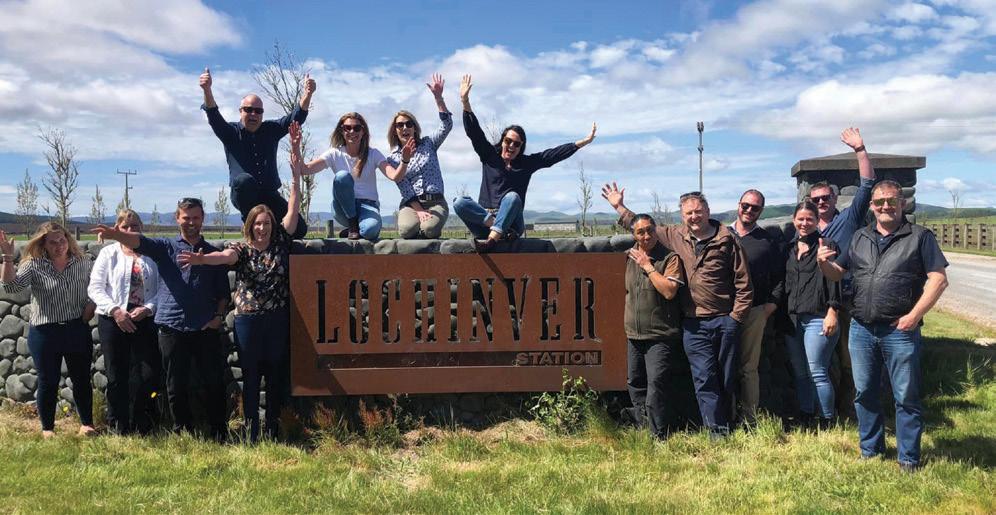
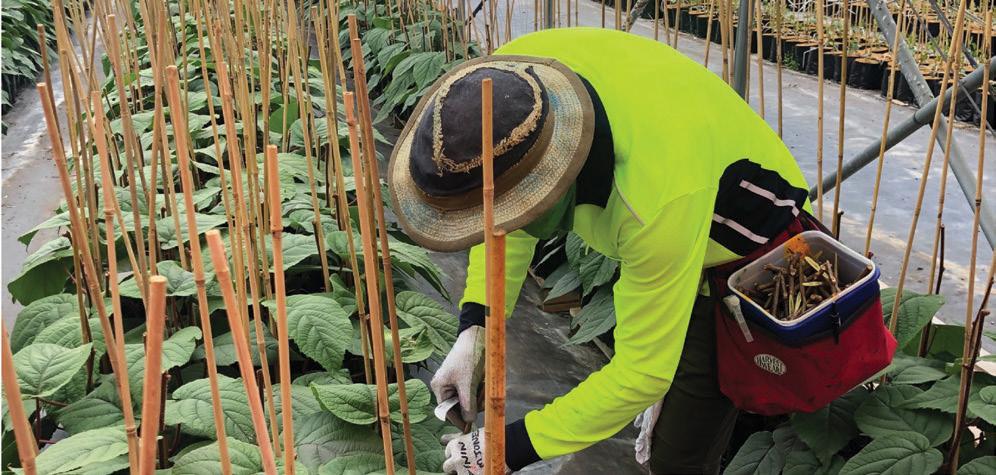


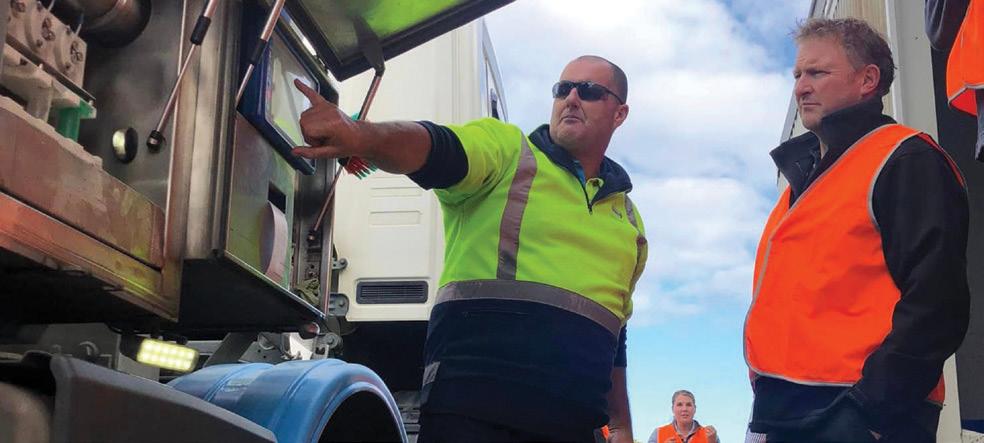
The following article, on dairy’s social licence to operate – perspectives from dairy technologies – is based on the Kellogg Rural Leadership Programme report by Esther Donkersloot. Esther is a 2024 Kellogg scholar and an LIC scientist (quantitative genetics).
New Zealand’s dairy industry is the powerhouse of our economy, generating around NZ$26 billion in export revenue in 2023. As the largest export sector, it plays a crucial role in stabilising rural economies during times of fluctuating milk prices.
To meet a rising global demand, the industry is increasingly turning to innovative technologies that promise enhanced efficiency and sustainability. However, as new practices emerge, they must also navigate public perception and establish a social licence to operate (SLO) – a community’s level of approval of industry practices.
Understanding social licence to operate.
The concept of SLO is vital for the dairy sector. It reflects the community’s beliefs and perceptions, which can change over time based on various factors, such as ethical considerations and environmental impact.
Stakeholders are categorised as either internal – like employees and shareholders – or external, including suppliers, customers, and the broader public. Effectively engaging these groups is essential for establishing a high level of SLO, as their interactions can significantly influence community acceptance and trust.
Key factors influencing dairy’s SLO. Recent literature highlights several important themes that impact the establishment of SLO in the dairy sector:
1. Animal welfare: Public concern over animal treatment requires ethical practices within the industry.
2. Community impact: The dairy sector is a significant employer, reinforcing its SLO through its contribution to communities.
3. Cultural values: Engaging with Māori perspectives is crucial for addressing ethical concerns surrounding genetic technologies.
4. Environmental impact: Addressing ecological issues is key to maintaining public trust.
These themes emphasise the need for proactive stakeholder engagement, essential for the implementation of dairy technologies.
Engaging stakeholders effectively. Successful stakeholder engagement involves a specific skill set that emphasises transparency, along with a science-driven approach. Experts like Sir Peter Gluckman stress the importance of having the right skills for effective communication, especially within the scientific community.
One approach is the Responsible Innovation (RI) framework. This framework
acknowledges the uncertainties associated with biotechnology and highlights the community’s role in shaping innovations. Key aspects of the RI framework include anticipation, inclusion, and responsiveness, all of which are vital for engaging stakeholders throughout the development of dairy technologies.
in genetic dairy technologies.
As NZ pursues ambitious environmental targets, genetic technologies are becoming increasingly important. They can improve efficiency and reduce emissions – key goals for the sector. Notable innovations include:
• Short gestation length (SGL) products: These enhance milk production and reduce recovery time for cows.
Slick gene: Utilisation of this naturally occurring gene through traditional breeding practices aims to create heat-tolerant cows by 2029, improving animal welfare and productivity during summer months.
• Gene editing: Although currently restricted, gene editing offers potential for rapid improvements in dairy genetics.
• Juvenile in vitro embryo transfer (JIVET): This technique accelerates genetic gain, increasing breeding efficiency.
The success of these technologies relies not only on financial and environmental outcomes but also on community and industry acceptance.
Case study: Wearable technology in dairy farming.
A recent survey by DairyNZ revealed a notable rise in the adoption of herd management technologies, particularly wearables that monitor individual cows. Usage of these devices jumped from 3% in 2018 to 16% in 2023. Farmers primarily employ these technologies for heat detection, with health monitoring also gaining traction.
However, public perception poses challenges; some farmers worry about how technologies like virtual fencing may be perceived as overly controlling animals.
Insights from stakeholder interviews.
To gather insights, semi-structured interviews with representatives from wearable technology companies and various dairy sector stakeholders were conducted. The aim was to explore perspectives on SLO with regards to genetic technologies.
Key findings:
1. Importance of engagement: Companies stressed the need to involve stakeholders throughout product development to build trust and ensure relevance.
2. Customer vs consumer: There is a distinct focus on creating tailored products for the NZ market, with stakeholder engagement primarily focused on the direct customers, often neglecting the stakeholder further down the supply chain, including end consumers of dairy.
3. Defining success: Success hinges on delivering tangible value, building brand recognition, and cultivating advocates who promote these technologies.

4. Motivation: The stakeholders’ driver to be involved needs to be taken into account to prevent echo chambers or imbalance between the legal, economic and social licence.
5. Collective responsibility: Stakeholders acknowledged the necessity for collaborative efforts in establishing SLO, advocating for transparency and open discussion.
Looking ahead.
The research findings indicate that ongoing collaboration among all stakeholders – including research institutions, farmers, and regulatory bodies – is essential for the successful adoption of both wearable and genetic technologies in dairy farming. A proactive approach to public education and feedback about these technologies will be key to improving community acceptance.
The research also shows the importance of genetic dairy technologies for the sustainable future of the dairy sector. And with this, a high level of SLO can only be established through comprehensive stakeholder engagement during the development process. The SLO requires ongoing engagement even when a product or technology has successfully commercialised.
Recommendations:
• For research institutes: Share insights widely to encourage feedback and
create promoters, review current stakeholder engagement practices and establish governance structures that balance legal, economic and social licences.
• For stakeholders: Support the development of dairy technologies by building networks and facilitating open dialogue to capture diverse perspectives. Build capabilities, like stakeholder groups or committees, to tackle wider SLO questions as a group of stakeholders by sharing responsibilities and perspectives.
Building trust and transparency through effective stakeholder engagement is crucial for advancing the dairy sector.
This especially applies to genetic dairy technologies due to the uncertain nature of science, the inability to stop or retract the technology once it has been commercialised, and the potential for the community to shape the technology during development.
This collaborative approach will not only enhance the sustainability of the industry but also foster greater acceptance among communities.

Scan to read Esther’s full report under the Kellogg tab at ruralleaders.co.nz
Staff retention is not a new issue and was the reason behind the Sharemilking Agreements Act of 1937. But a signed agreement is only the beginning – farmers need to communicate better to ensure good ongoing relationships with their sharemilker or contract milker.
Words LOUISE GIBSON
Kia ora koutou! As an introduction to those that haven’t come across us before, The Sharefarming Consultants was founded to be an industry disrupter in how we support our farm owners and sharefarmers. We have a people retention problem in the dairy industry, and contract milking especially has long been a gaping hole where people with excellent potential are burnt and make a swift exit from the industry with a mountain of debt and resentment.
This problem has existed for as long as the dairy industry has been around in New Zealand, with articles dating back 100 years referring to the issue of needing to offer fair and profitable sharemilking jobs and ultimately becoming the reason for the Sharemilking Agreements Act of 1937.
As an industry to support retention of our talented people, we need to get better at how we manage our relationships with our sharefarmers. This month as a starting point, I am talking about communication, agreements (yes – the one you signed for this season) and retention. Now is the perfect point in the season to be looking at all three and fix what isn’t working.
Whether you have a sharemilker, contract milker or staff onfarm, you need to assess how the communication is going and if you need support to do this better. It can be really easy to assume that communication is all well and good, and that everyone is happy and no one has any questions because there has been no communication or conflict. However, as New Zealanders we are typically terrible with conflict and tend
to leave things that are bothering us to fester until they blow up. If you haven’t already, I highly recommend setting up more formal fortnightly or monthly meetings to avoid this. Why are these meetings so important? When we are communicating in an ad hoc way, we give the impression that we are in a hurry and that this might not be the most convenient time for a bigger conversation that the sharemilker or contract milker needs to have. For these meetings, I recommend a format of people (because everyone has human things happening in the background), animals (production and health), feed, health and safety, infrastructure (maintenance and improvements), and housing. This format is designed to cover off all the key components required under the industry standard sharefarming agreements, it’s predictable and it catches most things that may be brewing away in the background.
If this sort of meeting style is out of your comfort zone, bring in a specialist consultant to support you – they will be able to help parties navigate any brewing conflict early, consider both sides’ thoughts and hold everyone accountable to the agreed plan.
Get your agreement out and check everything is ticked off and going accordingly. Is there anything that changed that didn’t get documented? Documenting these changes are important when we consider the legal ramifications if you didn’t meet your obligations within the agreement and acknowledging the impact this may have had on your sharefarmer.

Examples are minimum cow numbers not being met, a change of plan to the nitrogen or feed inputs, the actual feed onfarm at the beginning of the term, or any work that needs to be done to housing or infrastructure. Whatever needs to be documented, sit down with your sharemilker or contract milker now and discuss these changes and document them. If there are any changes that will have a material impact to milk production, make sure a remedy is put in place. For contract milkers this could mean an adjustment to the milk payment rate and/or adding an additional payment for calves reared; for sharemilkers this could be a compensatory amount of feed. If you are unsure how to approach this, talk to an expert on where to start.
Now is the time to start making decisions if you want to retain or end your current employment or sharefarming relationships. Most agreements require notice to be given by the end of February for the end of the season, but this can be incredibly late when it comes to recruitment. If you are considering giving notice, consult with a professional as to why you want to do this and how to do this in a way that isn’t going to upset the rest of the season’s milk production. If you are wanting to retain your current sharemilker or contract milker, it is really important to set up a meeting to discuss this and be prepared to hear some honest truths even if you do have some time left to run on your agreement. This should be done every season and it is a good (but tough) opportunity for the other party to discuss what they need
from the next season. Be prepared to be flexible and listen, and be prepared to negotiate. Especially for contract milkers, this is a good time to work through the DairyNZ Contract Milking Premium Calculator and work out if the contract milking rate is resulting in a healthy profit for the contract milker while being financially sustainable for the farm owner.
If you are considering changing how labour is run on the farm, the first step is a good, hard, honest look at your own finances. This is especially important if you are changing from employees to contract milking, or from contract milking to taking on a herd owner. We regularly see farm owners who have significantly underestimated how much this change can cost and instead of looking at a different option, pursue something that isn’t financially viable for either party which can be devastating for all involved. Your accountant, a specialist consultant and your bank are three parties who can support you in discussing your options. If financially your original idea isn’t going to work out, a good consultant will be able to come up with a new plan that will. Start the conversations today, because nothing will be solved for the next season without putting it on the table.
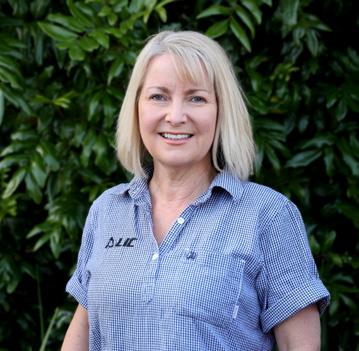
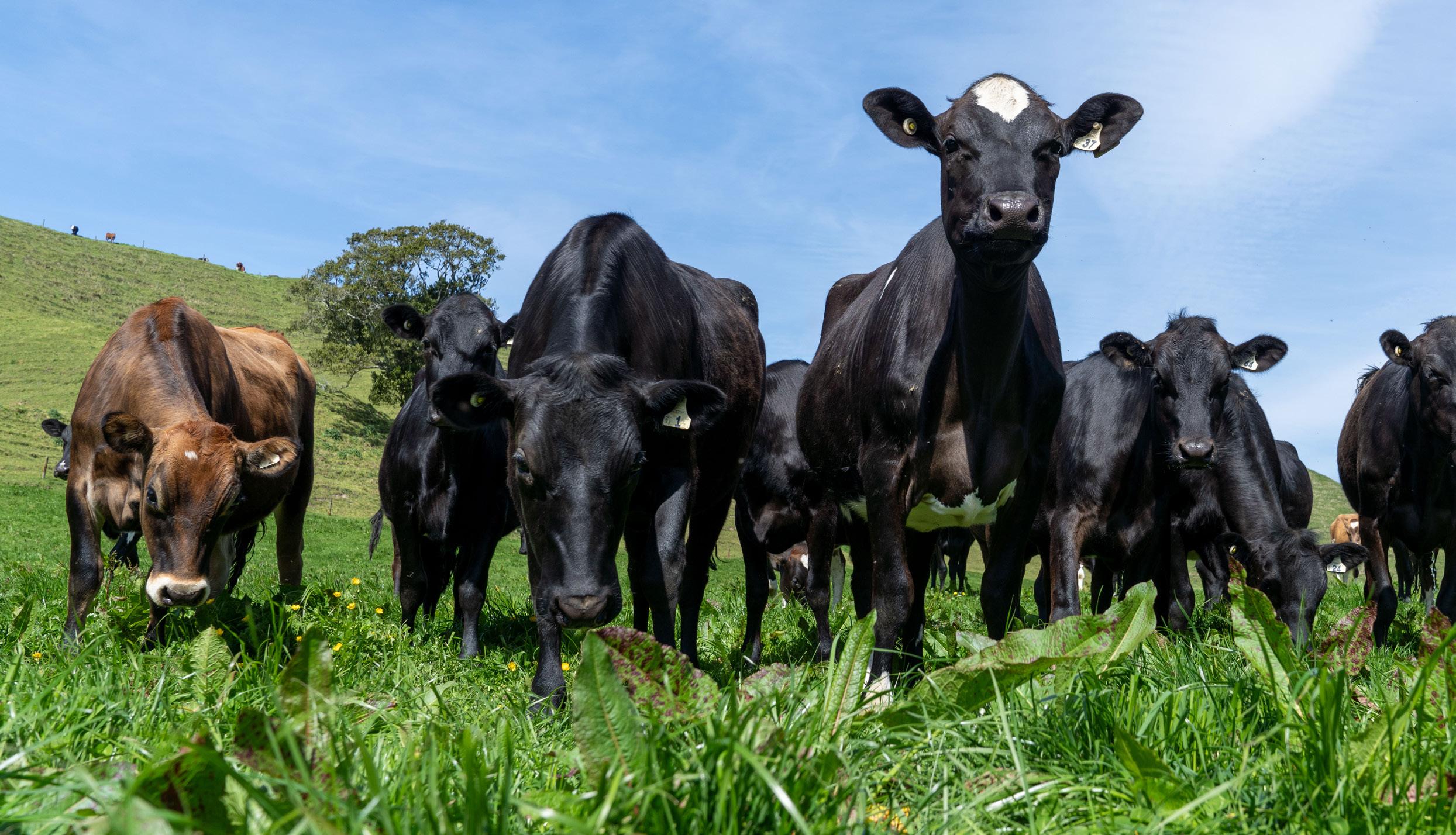
Headlines about triple drench resistance in the sheep industry are sending waves through the rest of the primary sector. So what about our dairy industry?
Words GINNY DODUNSKI
The threat of drench-resistant worms to dairy heifer systems has been around for a long time. It’s just that, like some of our own preventable health conditions, it’s been easy to ignore until a “surprise” diagnosis makes us wish we’d got our check-ups and made those lifestyle changes sooner.
Twenty years ago, a New Zealandwide drench resistance survey revealed that 92% of cattle properties (including dairy support and dairy beef) had worms that were resistant to the mectin drench family. This family includes all of your favourite pour-on and injectable cattle drenches! Seventy-six per cent had worms that were resistant to “white” drenches (Benzimidazoles – a component of many summer calf drench products). The only drench family that was holding up was the “clear” drench family (Levamisole).
After these rather frightening results, Wormwise was formed as an attempt to provide farmers and their advisers with a suite of recommendations to reduce worm challenge and slow further development of drench resistance.
All that really happened in the cattle space was a move to including Levamisole in calf drenches, because that was the one that worked, right?
If only it were that simple.
As a dairy farmer, breeding is an important part of your business. You select the strongest performers for your environment, and mate them to the bulls that are likely to give you even stronger and better daughters.
Unfortunately, we have done the same with the worms on our farms, by using drench as a selection tool. The (initially very few) worms that have been able to survive drench treatments get
a selection advantage – in the weeks after drenching, those worms left behind in the gut breed only with each other, producing eggs that form the next generation of infective larvae on pasture. Where drench is the only tool to limit parasitism in calves, and especially where few other stock graze a block, it’s inevitable that over time, the worm population swings towards a predominantly drench-resistant one.
Twenty years ago, we had lots of worms on our farms that were already resistant to two of the main actives in our routine combination drenches. By switching to using combination drenches, without other management to limit worm challenge and manage the build-up of the resistant ones, we have simply selected for combinationresistant worms.
A combination of drugs is most powerful at delaying resistance when each of the individual actives is highly effective at killing worms by itself. When we started using combinations, we already had high numbers of worms that were resistant to two of the main drugs. In some ways it’s surprising it has taken this long for problems to appear.
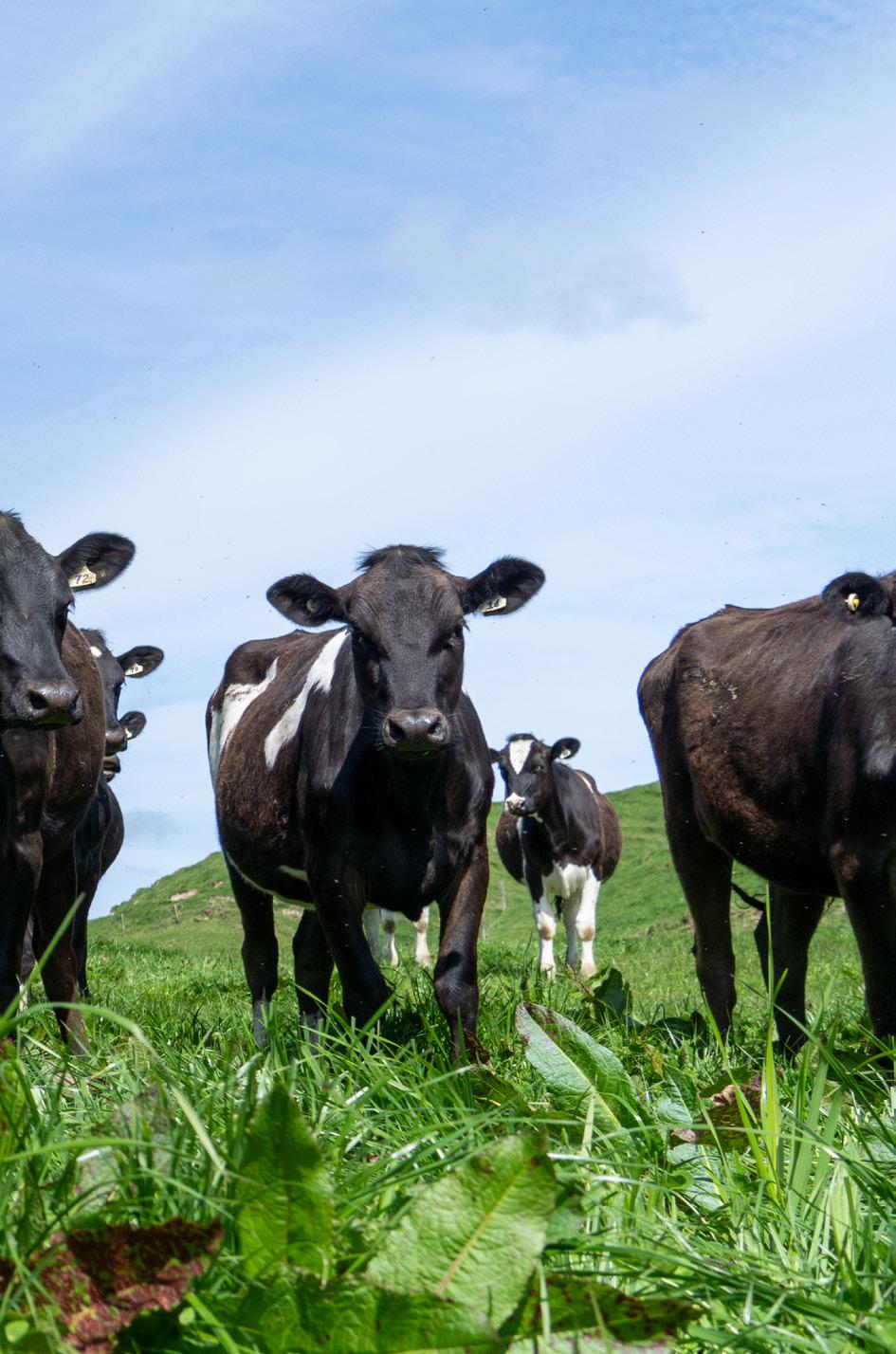
In dairy support systems, the vast majority of infective worm larvae on pasture comes from calves less than 10 months of age. How well we feed and grow these calves, where we graze them, for how long and what forages are on offer, matter a lot to how “wormy” a block becomes.
In the “old school” system of “two calves to a paddock”, the individual animals in each paddock had more grass than they could eat for most days in the month and had little to no competition and social stress. While they were definitely picking up a few worm larvae while grazing, there weren’t enough calves in any one place on the farm to create a high level of larvae on pasture. Adult cow grazing as the milkers came through, vacuumed up a lot of what the worms in the calves were producing anyway.
While it may not be practical in many systems to return to the “good old days”, what are the principles we can take from this example and apply in other heifer grazing systems?
1. Feed them really well! I am constantly amazed by farms in the last few years that have discovered drench resistance
Where drench is the only tool to limit parasitism in calves, and especially where few other stock graze a block, it’s inevitable that over time, the worm population swings towards a predominantly drench-resistant one.
because they are good operators and have tested because it’s the “right” thing to do. Yet they had no idea that they had a problem because their young cattle have been growing so well. Conversely, we have seen some spectacular outbreaks of death and disease on properties where undernutrition (most commonly quantity, but also sometimes feed quality) is the primary problem. The faster we can grow our calves out, the quicker they develop their own immunity to worms, and the less drench is required in the system.
I don’t have data for this, but my other observation is that farms where calves continue to get some form of high energy and protein supplement over the summer, have less issues with worms.
2. Don’t run mobs of calves round and round the same grazing area with drench as the only means of managing worms. High levels of larvae accumulate on these areas in between drenches, with an increasing percentage of these becoming drench-resistant worms over time. Look for ways you can create grazing swaps or rotations with older cattle or another class of stock, to “clean up” paddocks for when calves come back into them.
Ex hay and silage paddocks, and crops are also very useful. There is no “rule” here for how long these breaks need to be, but longer is better and a few weeks may not be enough initially to substantially clean things up. Get some advice from someone who’s worked in this area. Often the vet in
your area who deals with all the sheep farmers is a great choice, as they’ve been dealing with these issues for ages!
And now, the question you wanted answered right at the beginning – “Which is the best drench?”
There are some rules here:
1. For calves under nine months of age, it’s an oral drench.
2. Pour-on products kill less-resistant worms and reach much lower levels of drug in the bloodstream than orals or injectables. This feature adds to the risk of underdosing – this allows more resistant worms to survive.
3. You must know which products are actually effective for your farm. Ten to 14 days after the first worm treatment of calves, collect 10 fresh faecal samples and get them checked for worm eggs. If eggs are present, it’s the beginning of a conversation about not only what drench option to change to, but also the management stuff, to stop things getting worse.
Finally – When to start drenching?
Calves in their early weeks of life that appear to be “wormy” are far more likely to be suffering from coccidiosis. There has been a big upswing in testing of this age group of calves in the last couple of years, and vets tell me that they almost never find worm eggs in these young calves. Calves eating pasture rarely require treatment for worms before 8–10 weeks of age, and potentially later than this, depending on where they are being run and the quality and worm contamination level on that feed.
Implementing a good feed strategy for calves is half the equation when it comes to worm control. Owl Farm has found using chicory to increase protein for their calves has ultimately had the added benefit of reduced exposure to worms.
Words SHERYL HAITANA
Afew years ago, Owl Farm – the demonstration dairy farm joint venture between St Peter’s School and Lincoln University – elected to alter their operation to keep the dairy calf replacements home during the first year.
They planted chicory to ensure there was enough protein for the R1s to gain good weight during their first summer, with palm kernel and grass silage used as a supplement when needed.
The unintentional bonus has been that the calves have needed minimal drenching to control worms throughout that first year, says Owl Farm demonstration manager Jo Sheridan.
“We decided to keep our calves at home to grow them out. We recognised a lack of protein was a huge risk to our young stock and we had the opportunity four years ago to keep our calves on the milking platform.”
Chicory was a mechanism to reduce the area needed to feed the calves and reduce the impact on the dairy herd. They planted 7ha of chicory. The equivalent area needed to graze those calves on ryegrass would have been about 13ha.
They have since realised this strategy has broken the cycle of worm parasites, reduced the need for drenching, and therefore could minimise the risk to a growing drenchresistance problem.
“We figured out the calves actually grew really well. We also realised we had some good clean crops so we didn’t have to drench them.”
Embedding a worm strategy into their system wasn’t by design, it was a bonus of other decisions. But it’s an area they need to learn more about, Jo admits.
“I’m definitely not a worm expert, but we have stumbled on a system that helps meet the need of reduced drenching. We have so much to learn in this space. Since talking to Ginny Dodunski from Wormwise, I’ve realised we are only just scratching the surface and that we as dairy farmers probably need to be across this more.”
Chicory has proved a winning crop for multiple reasons. As well as being a high-protein feed, the chicory provides a clean sword and the plant also reduces the ability of the larvae to be easily ingested by the calves.
The calves get a clean-out drench before they go onto the chicory and then will have another drench if they end up on a paddock that has been grazed by the milking herd.
Owl Farm takes faecal egg counts to monitor how the calves are doing and if they need to be drenched. The testing has helped them be more comfortable with their decision not to drench more, Jo says.
Grazing on chicory also removes any exposure to facial eczema spores which is another added health bonus.
The calves do go into an intensive drenching programme when they go away grazing as R2s.
There is still a lot of concern around worms and drench resistance in that second year, however, the ability for those animals to handle any exposure to worms is higher when they’ve had such a good start, she says.
The calves typically leave the Owl Farm dairy platform 20kg above target weights, which gives them a bit of wiggle room in their second year.
The calves average 0.7–0.8kg LW gain during that first year, which is achievable every year as long as they are backfilling with supplement, Jo says.
“It’s so nice when you are feeding the calves the whole way through, they just don’t take the hit. There are lots of benefits to reducing the challenges those calves meet being on the dairy platform. We are nothing fancy here, we just use weight data as our biggest indicator. We are not using anything flash when it comes to growing them or feeding them.”
Owl Farm has been rearing 70 dairy calf replacements and have increased the chicory area to 8ha.
“We have learnt that by increasing the chicory block slightly we’ve been able to reduce the reliance on palm kernel and silage. We used 30t of supplement to get through that first summer; last season we used just 7t.”
The calves are on a 24-day rotation, shifted every second day behind a single wire break-fence. They use a trailer to feed out the supplement in the paddock.
The first two seasons they planted a new chicory crop each year. However, now they do first year chicory, then undersow Italian ryegrass and red clover in April. That paddock then goes into the milking platform the third year before it’s renovated in the fourth year.
“What the Italian and red clover does is it provides a bit more bulky feed when the chicory starts to peter out.”
The next lot of calves go on those paddocks in October rather than November on a new chicory crop.
“The downside of the combined crop is there is a period you’re going to be growing more feed than the calves can eat, so you either have to make silage or let the cows graze it.”
By stitching in the new grass in April, the cows can graze the paddocks during winter and then they make early silage.
This year they are rearing 140 calves with some extra replacements, plus a mob of dairy beef calves.
“We want to demonstrate to the industry what those dairy beef calves are capable of in a Waikato summer if they’re not limited to protein. We also have 22ha of new land, and chicory is a nice transition for the first year.”
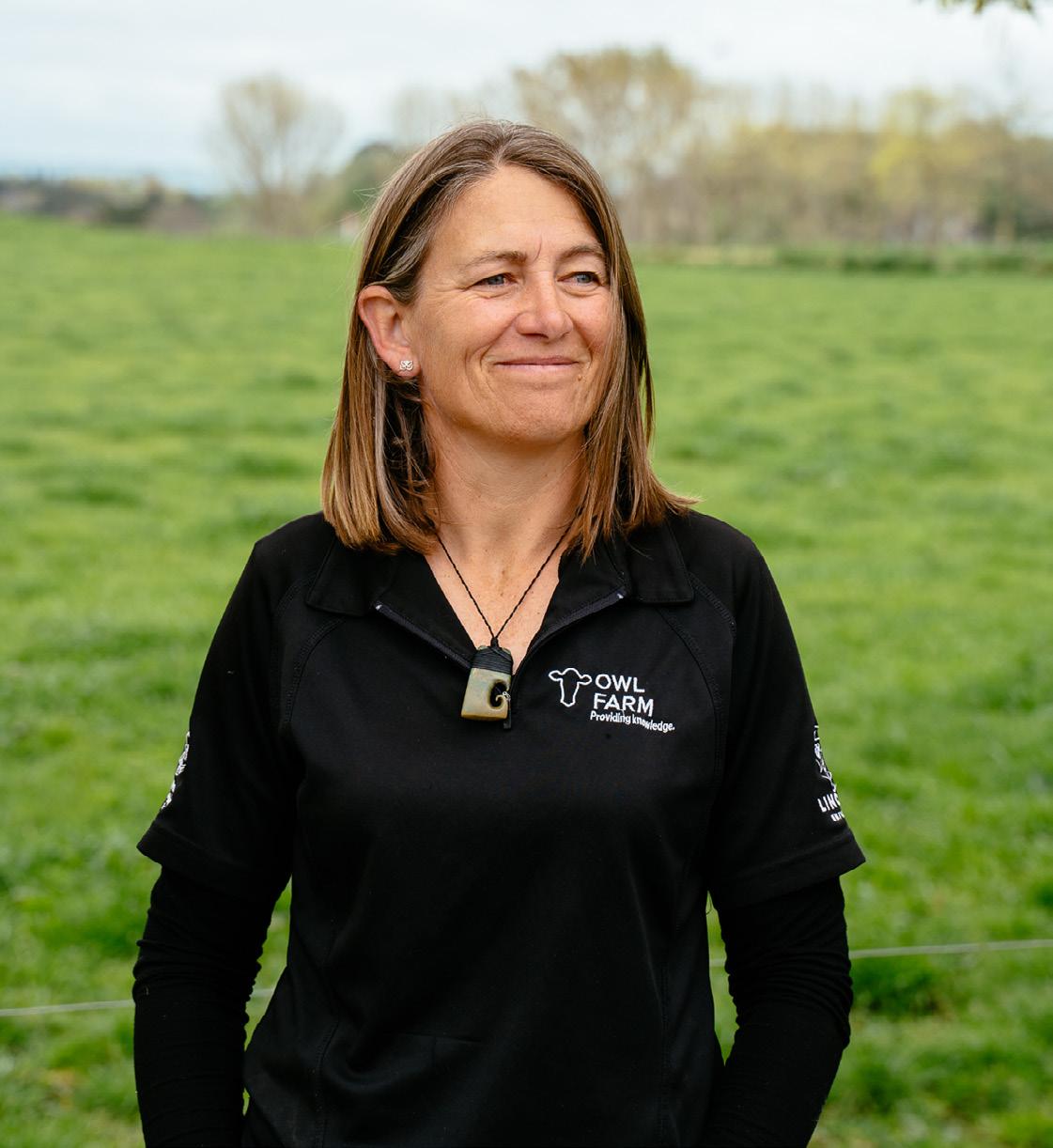
1. The importance of breaking the worm cycle and having clean pastures for young calves.
2. Using plants like chicory can help reduce the ability of the larvae to be easily ingested.
3. The importance of taking faecal egg counts to determine whether the calves need drenching, to reduce the risk of drench resistance.
Will we still be farming livestock in 50 years?
Is lab grown meat going to be a real alternative, will people even want it?
Can farmers keep feeding the world and care for the environment at the same time?





Optimise your herd’s pasture based performance with supplementary feed options.

Customisable Diets Through Pellets
Tailored to your herd’s specific nutritional needs. Accurate delivery of essential protein, energy and minerals in each pellet.
Easy Storage and Delivery
Convenient bulk delivery right to your farm.
FeedSafe Accredited
Our sites follow strict quality assurance processes to ensure farmers get exactly what they pay for.
Easy to Handle

Flows smoothy in silos and in-shed systems.
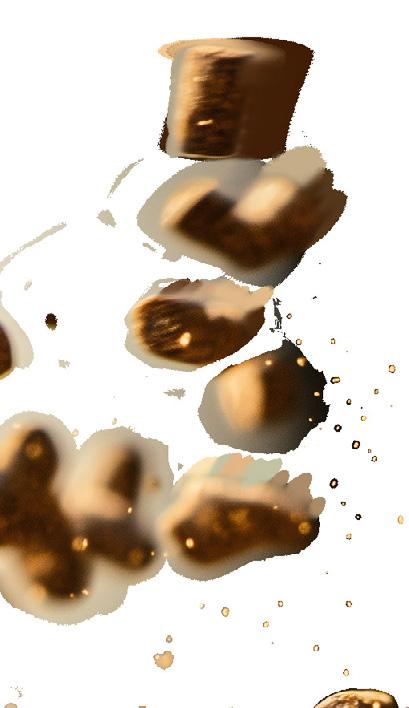
Contact your local SealesWinslow Technical Sales Representative to discuss bulk pelleted feed solutions for your herd.
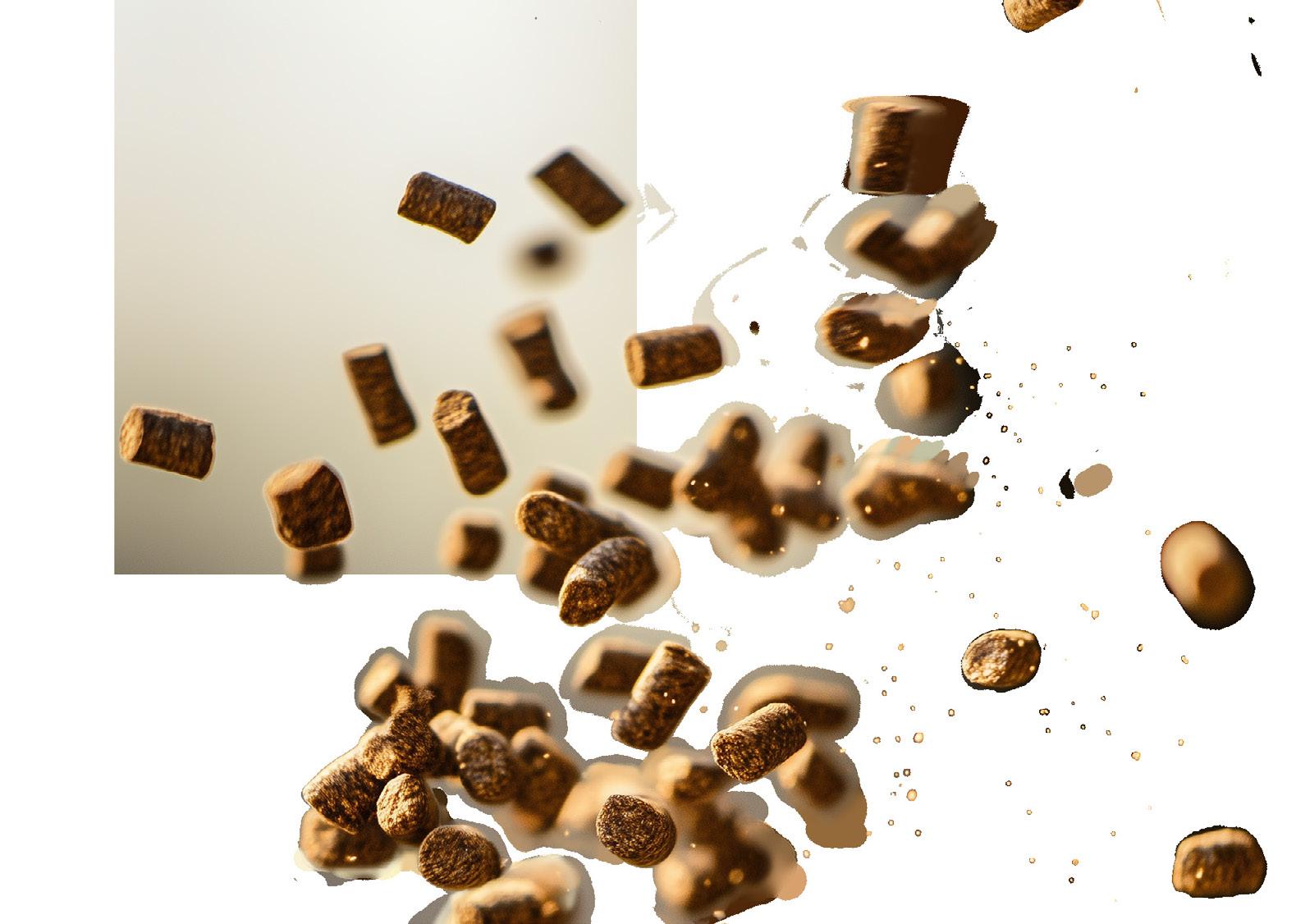
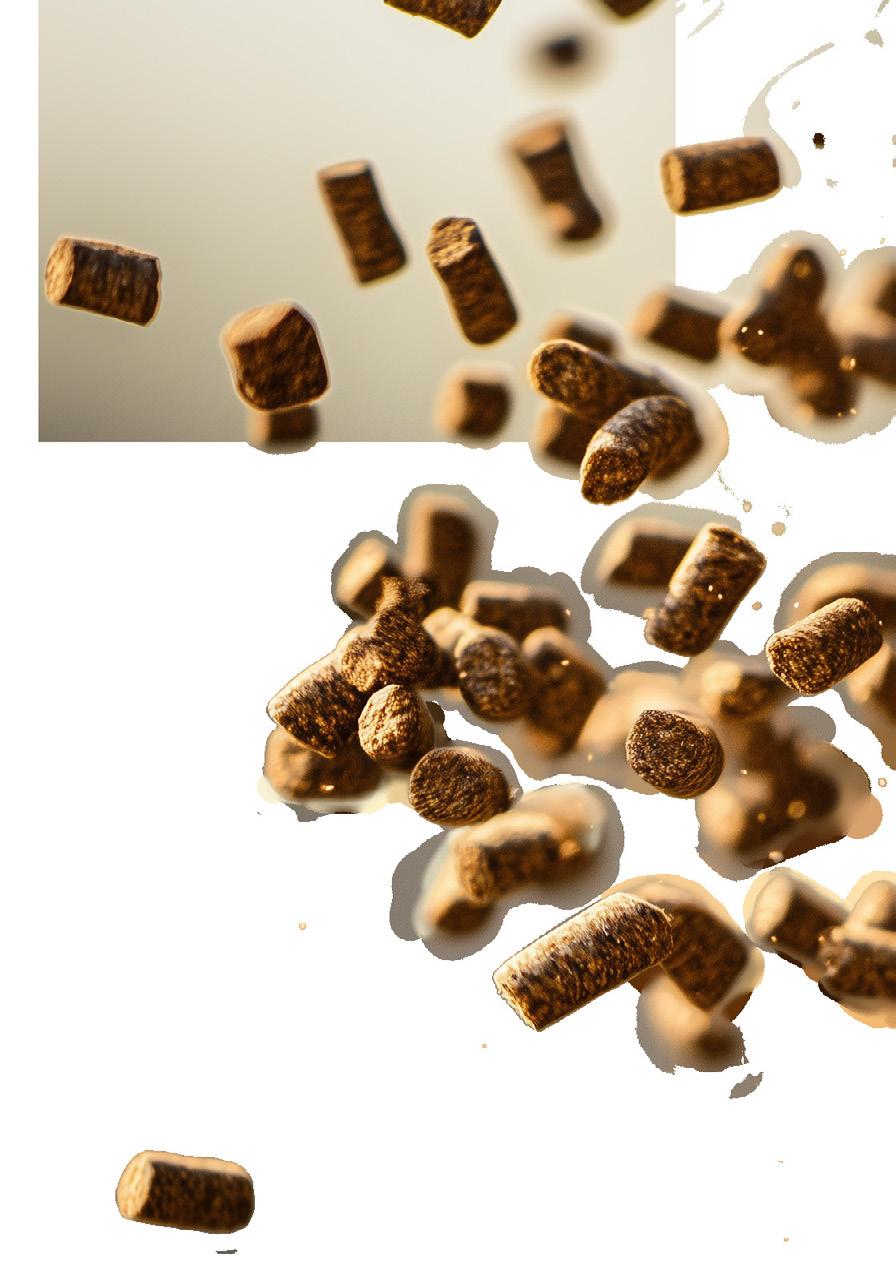







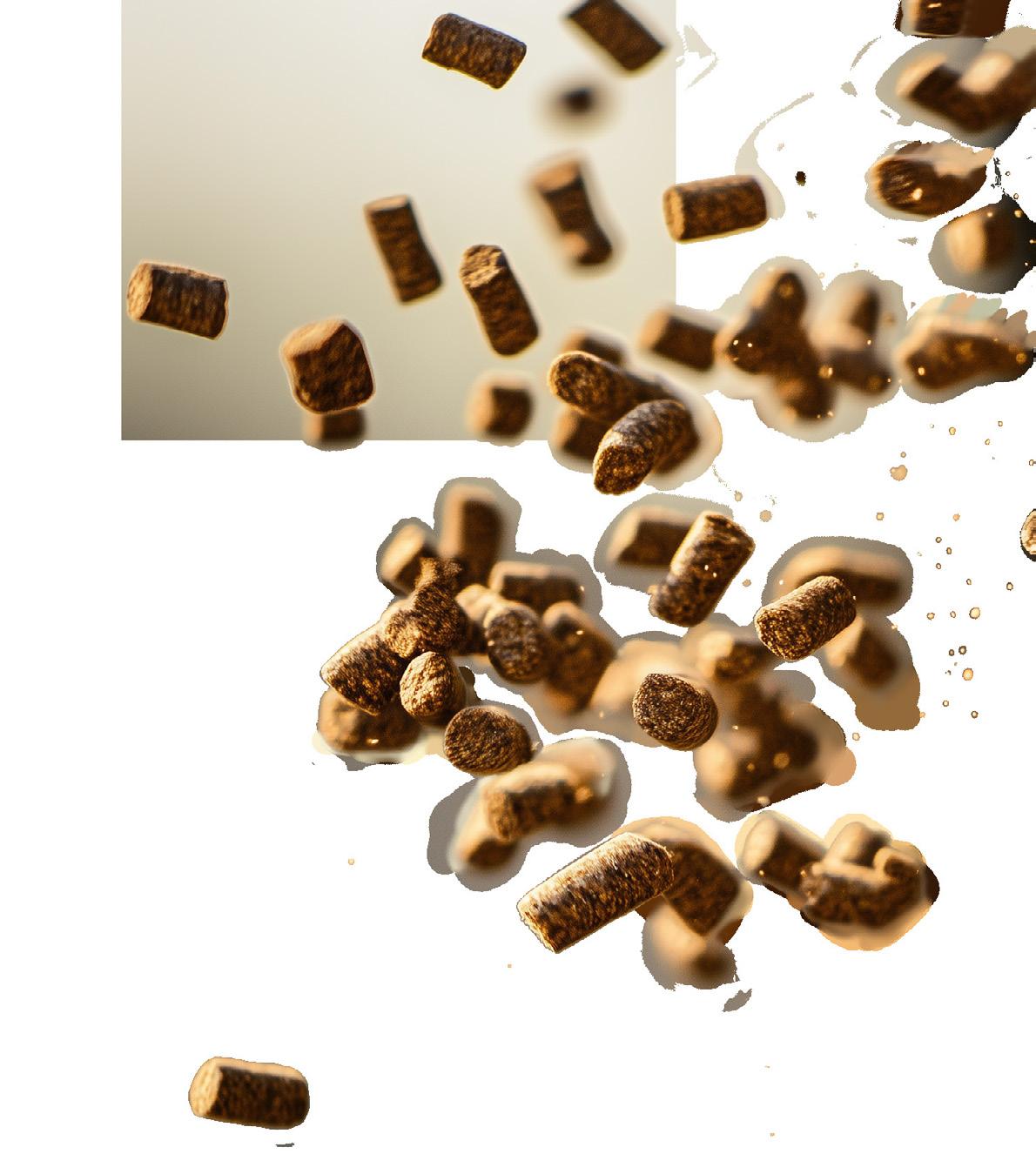




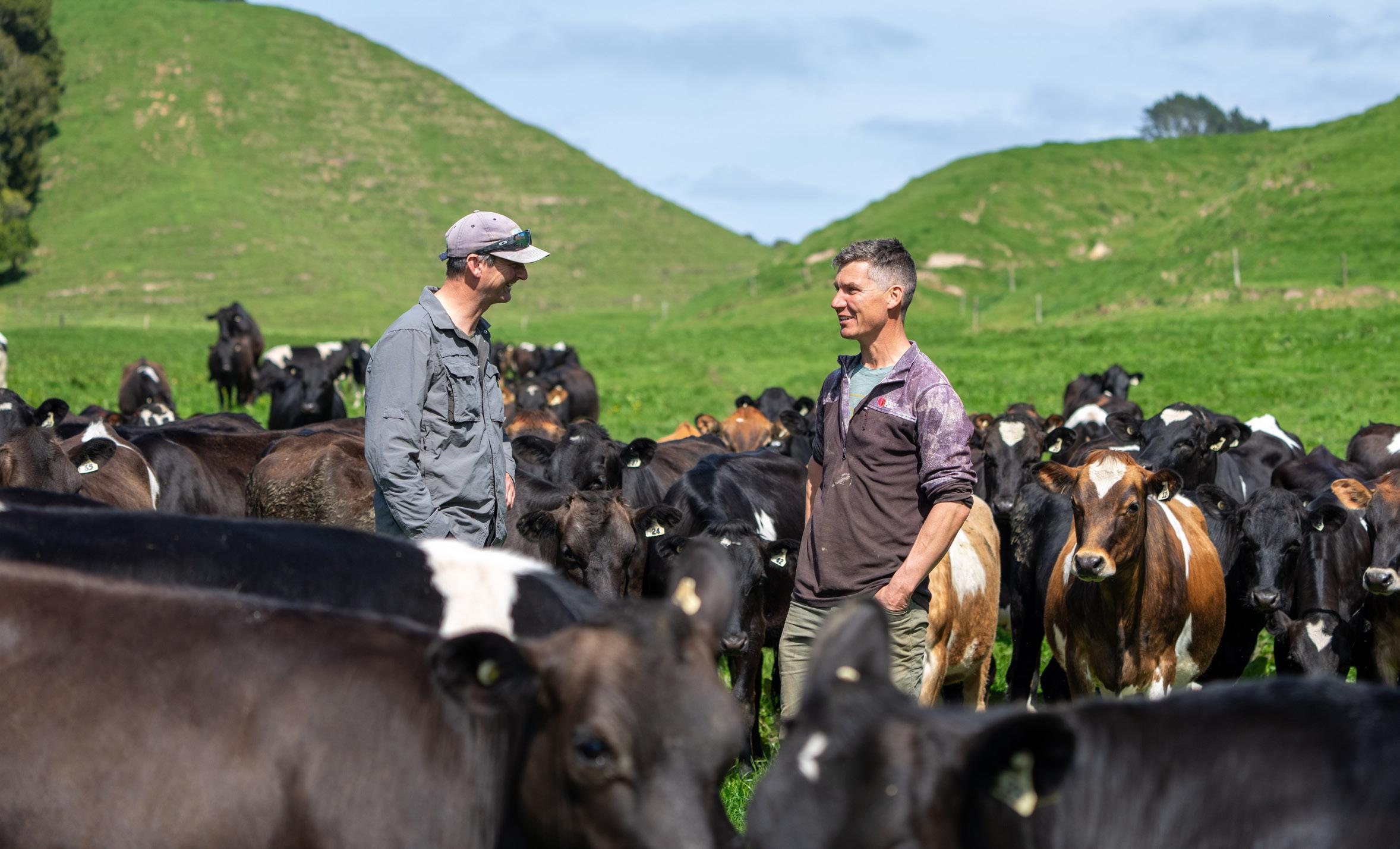
Taking the guesswork out of when to drench calves, via better testing and monitoring of worms, is one way farmers can help reduce the issue of drench resistance.
Words SHERYL HAITANA Photos EMMA MCCARTHY
Like many dairy farmers or graziers, Richard Fowler has run a typical worm programme in the past for his young stock, drenching once a month as a preventative and a treatment, without doing any real monitoring of parasites.
But last year a faecal egg sample showed signs of drench resistance to the mectin drenches.
Richard is a dairy representative on B+LNZ’s Farmer Research Advisory Group and has been keeping up to speed with what’s happening in the sheep industry with triple drench resistance. Through those discussions he has realised how limited the data is on what is happening with cattle and the risk to the dairy industry.
“From what I understand there’s not a lot of information out there – not a lot of research and not heaps of
understanding of what’s actually going on in terms of worm counts and worm species.”
Drench resistance could be a big problem for the dairy industry, he believes.
“I think it’s a bit of an iceberg. We’re just seeing the tip of it and there’s potentially heaps [of drench resistance] out there. Especially when you think about how a lot of these dairy calves end up grazing the same block constantly.”
The other side of the issue for farmers and graziers is knowing the history of what has been on the property before, what class of stock and what drenching programme they were on.
“We don’t know what’s existing in those pastures,” he says.
Richard and his wife Amy run two 250-cow dairy farms, their own farm
at Rotorua and they lease Richard’s parents’ farm near Te Puke. They also own and lease a 400ha support block at Okere Falls, located between the two dairy farms where they run 1000 head of cattle, including about 200 dairy heifer replacements.
Four years ago Richard employed Lance Price as a manager for the runoff. For the last 18 months Richard and Lance have embarked on a monitoring programme with AgResearch to monitor worm levels in their cattle, together with Animal Health Service in Rotorua.
Lance has been collecting faecal samples once a month over the spring and summer months. He takes 10 random samples from each mob out of the paddock. He then packages the sample and sends it to AgResearch.
“They come back with the worm levels in about three days. Normally, you don’t get the actual larvae cultures for probably about a month or so,” Lance says.
“I’ve been surprised to see what the levels are and the different stock classes and see what the different species of worm are too,” Richard says. “I suppose we didn’t really embark on it specifically

for this property to look at what was going on; it was part of a wider research programme. But the bonus has been that we’ve had that information on what’s happening on our property.
“Lance has used it quite a bit to say, hang on, the levels are pretty good at the moment, let’s hold off drenching for a bit. So we’ve been able to have a bit more confidence to push intervals out.”
They haven’t had quick knowledge of what actual parasites are present so they still have to guess which treatment to use, with advice from their vets.
“If they’re coughing a lot, you know there’s lungworm around, so they’re going to need a mectin drench,” Lance says. “Other times you just go off previous years or on your best knowledge and say, is it Cooperia or Ostertagia?”
Separate to the AgResearch search monitoring programme, Richard and
Lance decided last year to do a faecal egg count test and test for resistance –where they found out there was some resistance on the property to the mectin family of drenches.
“That was quite surprising actually because I guess historically we’ve run a relatively low drench programme and we have a lot of older cattle on the place too. So yeah, it was quite surprising to see,” Richard says.
Historically they weren’t doing any parasite testing, but simply visually watching the stock, weighing and drenching regularly.
“I’m always trying to drench as close as possible to their weights as I can so that you know the little ones aren’t getting over-drenched and the big ones aren’t getting under-drenched,” Lance says.
When the new dairy calves arrive at the runoff they are given a drench and they start grazing on the flats, which
have been mopped up by the winter cows or cut for silage, so the sword is hopefully lower in worms.
The mix of cattle ages is helpful. They run carryovers to follow the R1s and R2s which help to clean up the pastures.
“Those adult cattle are gold,” Lance says. “They do the donkey work and the young calves don’t have to graze down too hard. They’re never forced to because the carryovers come in behind and mow it off down to a 1200 residual.”
At the moment they are not planting any crops to graze the young calves on.
“We have dabbled with plantain before Lance was here; we grew whole crops of plantain to help with worms and facial eczema and grass staggers, but we lost a few with bloat, so you can’t win,” Richard says.
In light of the resistance present on the runoff, Richard and Lance are going to continue monitoring the parasites

‘I think it’s a bit of an iceberg. We’re just seeing the tip of it and there’s potentially heaps [of drench resistance] out there.’
RICHARD FOWLER
B+LNZ’s Farmer Research Advisory Group
and ensuring they are running a more accurate drenching programme and continue with their mixed grazing system. They will also look to do more postdrench testing to check for resistance.
Another solution to worms could be their dairy-beef calf system. They rear 200 beef steers annually, and started up a new system five years ago of rearing the 200 dairy-beef cross calves on about 80 cows.
The dairy-beef calves come up from the dairy farms to the runoff at 2–4 days old and they have built a special cow crush where they can train the calves to drink off the cows for a few days until they bond.
“We try to get three calves on each cow, but once they’re in the paddock, a good cow will have more than three calves on her – she’ll just feed whoever,” Lance says.
• Owner Richard Fowler
• Farm Manager Lance Price
• Location Okere Falls
• Area 400ha
• Stock Winter 1000, 200 dairy replacements, 200 beef steers, 100 beef cows

The calves stay on the cows until April and don’t need any drenching for worms or facial eczema.
It’s a totally different way of rearing calves. It works out at about the same cost of rearing a dairy-beef calf traditionally, Richard says.
“It’s certainly not everyone’s cup of tea, it’s pretty labour-intensive to get it all running. But once they’re all mothered up, you don’t have to worry about them and you get these big beautiful calves at weaning time and they’ve never been drenched.”
Richard would be keen to hear from any other farmer who has tried the same system.
Many dairy calves who have just been weaned will be heading off to grazing blocks soon. How can we support these calves to thrive during their first summer?
Words DAIRYNZ
Across the country, most calves will have reached, or will shortly be reaching, their target weaning weights off milk, and you will be shifting them to meal and grass.
The importance of caring for young calves is regularly emphasised, however, continuing rearing heifers with extra care will help pay dividends throughout a cow’s milking life, since well-grown heifers are known to be more successful milking cows.
When you consider the different components, we know the ability to grow healthy heifers is not easy. It requires time and effort and considers a range of aspects, from health plans, nutrition and weighing frequency, to help set them up for the best performance outcomes in future.
Just like the difference between one human and the next, heifers have unique health needs specific to their age and the farm that they are grazing. This means that if they are moving farms within their first two years of life, a health plan that adapts with their movement needs to be developed.
The plan should cover five key areas: biosecurity, vaccinations, parasite management, trace elements and minerals, along with region-specific concerns like facial eczema.
While some animal health components are required by law, including the Bovine tuberculosis (TB) and Leptospirosis (Lepto) vaccines, there’s more to getting the best start to a productive cow’s life than just ticking those boxes.
Dedicating time and effort in caring for your heifers, to help ensure they have the best start to their development, will support them to be the most healthy and productive animals.
The plan should cover five key areas: biosecurity, vaccinations, parasite management, trace elements and minerals.
To be successful in developing these plans, first make sure you are customising them to each farm, to account for parasite presence and trace element decisions like copper and selenium, and consulting with a vet to ensure they remain relevant and effective.
There are a range of questions you can be considering yourself, or asking graziers, to ensure you are across all the key elements of animal health plans that should be addressed. Consider things like:
• What are the stock movement levels on the property and potential disease exposure?
• What is the historical presence of salmonella, theileria, facial eczema, etc.? What are the parasites present onfarm? What is the farm management that will reduce parasite pressure (e.g. grazing management, cropping regimes, and stock classes)? What have been the historic trace element deficiencies? What pasture species, crop types, supplement, soil types, and fertiliser history will the heifers be grazing on that might impact the trace element presence and concentration in their diet?
Once an initial health plan has been developed and implemented over a season, you can then consider: How effective was last season’s health plan and are there any changes to be made?
• What has changed or are there any new risks to be aware of?
While there is a large range of animal health components to consider, you can be successful in supporting healthy heifers by being aware of the various components and incorporating them into your health plan.
To learn more about heifer health visit dairynz.co.nz/heifer-health

Evidence shows that hitting liveweight targets has a lifelong effect on a heifer’s productive and reproductive performance, as well as her survivability in the herd. Weighing regularly will pick up any potential issues early, and it’s important to take action right away. Recording and monitoring changes in weight gain will make it easier for you to identify animals that slip behind.
Consistent weigh-ins, ideally every 4–8 weeks, help monitor growth and spot issues early on. Particularly in young heifers, monthly weigh-ins can be beneficial as they grow rapidly.
Younger heifers can benefit from monthly weigh-ins because the necessary growth rates are a higher percentage of body weight at a young age. If heifers fall behind weight early, it can be difficult to get them back on track. To achieve target weights, heifers should be able to double their weight in the first three months of life and double it again over the next seven months.
There are two ways to identify animal performance: visually and through weight, although visual assessments should never replace weighing. Both methods have value; heifers can be weighed on a monthly to three monthly basis and should also be observed daily to multiple times a week. Visual
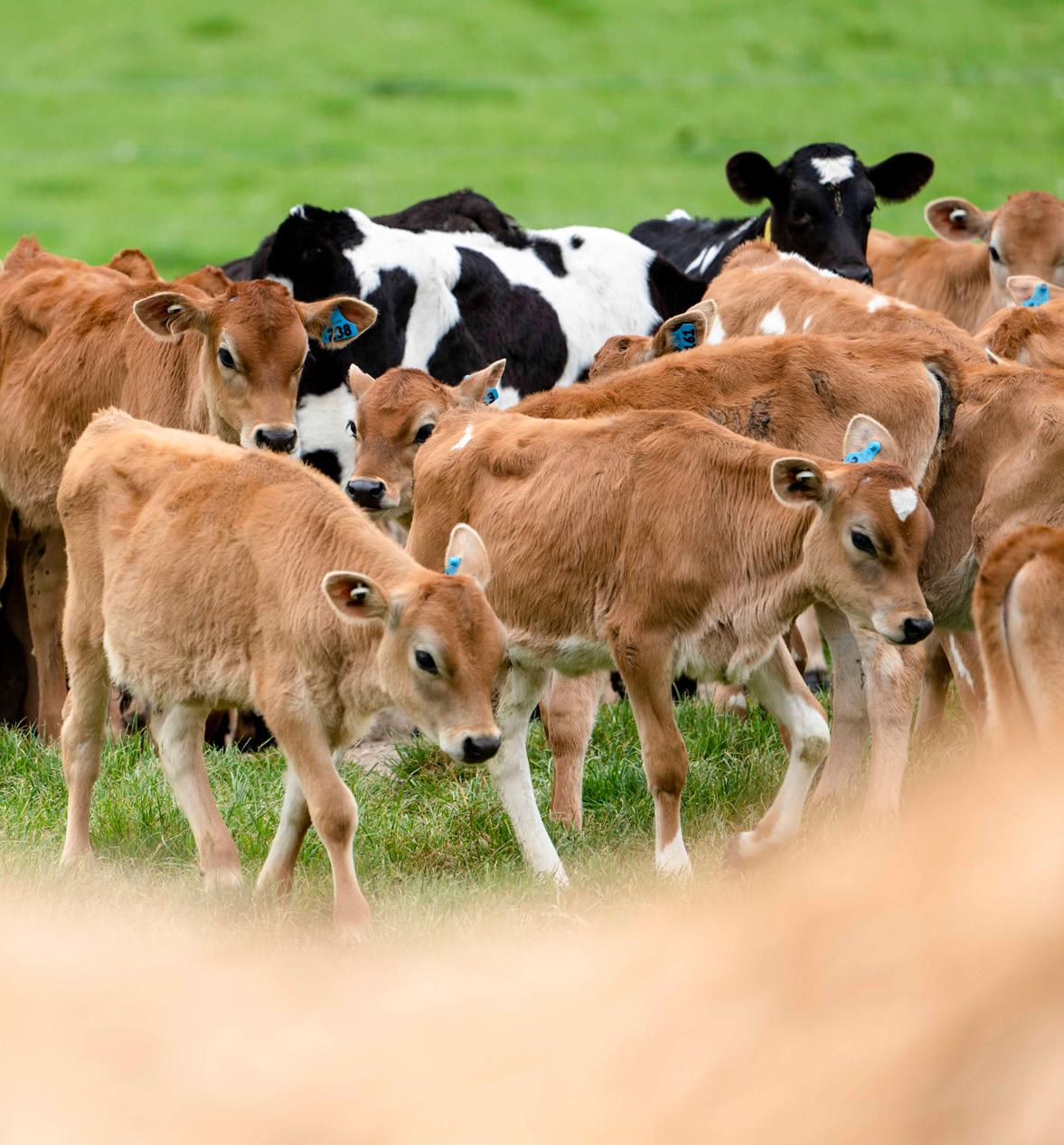
observation may detect issues between weigh-ins.
So, what is the best way to monitor heifers?
If heifers are at a grazier, then action could include more frequent visits to the property or regular reports/feedback from the grazier with regular weighing of the heifers to check them against target weights. Scales provide the most accurate liveweight information but weigh bands are still better than nothing.
Your heifer’s diet needs sufficient energy and protein for optimal growth, while a balance of minerals and water availability is also vital.
We have seen evidence that shows nutrition pre-puberty (before 50% mature liveweight) influences skeletal growth. If you ever see rising two-yearold (R2) heifers that are significantly shorter than mature cows pre-calving, it will be due to feed management pre-puberty.
That emphasises the importance of focusing and looking to perfect heifer nutrition for your young heifers.
For a heifer diet, you should be looking at ensuring it provides enough energy, by being greater than 10.5 megajoules of metabolisable energy (MJ ME) per
kilogram drymatter (DM), along with sufficient protein to achieve the target growth rates mentioned earlier.
This doesn’t need to be complicated, and often pasture alone will be sufficient. Sometimes supplements or crops may be required, for example, if pasture is limited. In these circumstances, these supplementary feeds should contain at least 11 MJ ME/kg DM and crude protein suitable to meet the animal’s nutritional stage.
When going down this path, you may see an increase in heifer liveweight gain from crops or supplements, however, this is a result of increased feed supply, not an increase in feed quality or crude protein content. While animals may gain slightly more weight from supplement feeding, the weight gain is rarely economical.
Overall, raising heifers means considering a range of components, especially as we start to enter summer months. However, when you break it down into the key considerations, like health plans, weighing and nutrition, you can focus on what needs to happen, and when, to support the best outcomes for both your animals, and your farm.
If you’re looking for more information on caring for heifers, then visit dairynz.co.nz/ heifers
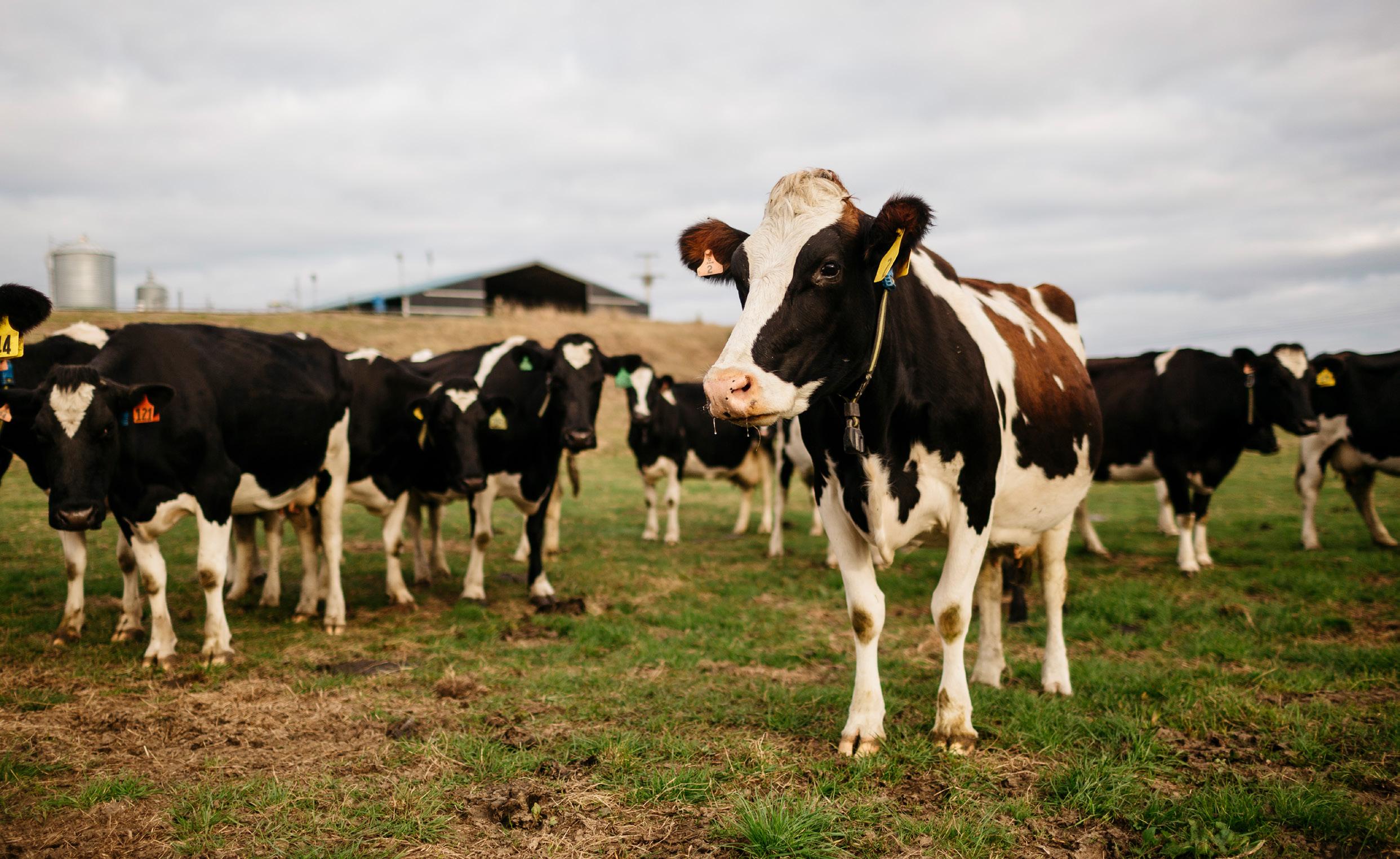
There have been some catastrophic outbreaks of Salmonella this year. Salmonella can strike without warning and spread quickly at any time, so what lessons can we learn from these recent outbreaks?
Words SHERYL HAITANA
Southland veterinarian Sam Lee had some tough call-outs this spring, including helping a farmer treat up to 400 of their cows for clinical Salmonella, with 10% of those cows dying.
The outbreak has cost the farmer hundreds of thousands of dollars due to the mortality rates, lost milk production and treatment costs.
“We have seen several cases of Salmonella outbreaks on dairy farms and talking to colleagues in different parts of Southland and Otago, the same picture seems to be occurring,” Sam says.
It is hard to predict when or if a farm will experience a Salmonella outbreak. It is not only reserved for farms with in-shed feeding or those going through a particularly adverse weather event. Cows are the biggest carriers of the bacteria and it can strike without warning and on any farm given the right conditions.
Black-backed gulls and waterfowl, particularly ducks, often cop the blame for carrying and introducing Salmonella and there’s some truth in that, but research shows the largest risk to a Salmonella introduction on a farm is the cows themselves, Sam says.
“Overseas research has shown that a high proportion of dairy cows likely have Salmonella already in their digestive tract, but it is not causing any issues. Salmonella is an opportunistic bacteria. If the conditions align that favour Salmonella (external stresses, compromised immune systems), you can suddenly get a scenario where the Salmonella population within a carrier animal will explode.
“That cow becomes clinically unwell and then as soon as you have clinically sick animals, they pass the bacteria in their faeces and other animals get infected by ingesting contaminated food or water.”
There is also research showing that higher levels of magnesium supplementation could have a role in increasing the likelihood of Salmonella, by changing the pH levels in the rumen.
It’s time for reflection for all farmers to sit down with their vets and discuss the risk of it happening on their own farm, Sam says.
“You don’t want it to happen. The consequences of a largescale outbreak are absolutely catastrophic. It’s a really good time to have that discussion with your vet and see how you can minimise the risks of Salmonella occurring on your dairy farm.”
Vaccination is definitely a big component of that discussion, but it’s also about achieving good cow condition to handle stressful periods onfarm, Sam says.
“We can’t predict and prevent adverse weather patterns, but we can control the controllables – ensuring our cattle are in good body condition coming into stressful periods, making sure we don’t have excessive stocking rates. All those little things help to reduce the risk.”
Cows are the biggest carriers of the bacteria and it can strike without warning and on any farm given the right conditions.

If there is a Salmonella outbreak onfarm, the difficulty is often it takes several days to process the samples and get a diagnosis, and then vaccinating the herd at that stage takes time for cows to get protection and there will be more sick animals in the interim.
“The real anxious part of dealing with these high-pressure situations is that vaccination itself can take time to work. If you’re already onfarm and dealing with multiple sick animals and you think this could be Salmonella, if you’re waiting for that diagnosis before you act you could be doubling your cases daily.
“Often if Salmonella is suspected, a vet will treat those cows with antibiotics, anti-inflammatories and fluid therapy to try and treat their dehydration and electrolyte loss.”
Waikato farmers Louise and Tony Collingwood had their first experience with Salmonella last year when their cows were dried off.
The couple bought a second farm at Ōtorohanga last year and purchased the 470-cow herd, which had previously never had a Salmonella issue.
“Looking back, it was that transition period of drying the cows off and changing their feed, I think that’s why it reared its head when it did,” Louise says.
Several weeks into the dry period their SenseHub Dairy (previously Allflex) collars showed some health alerts for decreased rumination on a couple of cows. They pulled out the cows in question and on closer inspection, they noticed they were scouring, hunched up and really not looking very well.
They called the vet out to take some faecal samples and they were immediately given antibiotics. A few days later,
Louise got the dreaded call from the vet confirming the cows had Salmonella.
“It was scary, I had heard of herds treating up to 60 or 70 cows.”
Fortunately they were able to find the sick cows quickly, treat them and vaccinate the rest of the herd promptly.
“We were lucky that we had treated the first few sick cows with the right antibiotics and we then vaccinated the entire herd, and the weather was pretty good as well so that probably helped us.”
The herd was vaccinated with Salvexin+B and followed up four weeks later with a second (booster) shot.
“We picked up a few more sick cows when we vaccinated them and so we treated them with antibiotics too. In the end the outbreak cost us a reasonable amount, we treated about 17 cows with antibiotics, we lost a couple of cows and we had about eight cows slip.
“Those cows that had gotten quite sick lost a reasonable amount of weight so our aim was to prioritise feeding them and make sure they gained that weight again as quickly as they could before calving.”
Louise, who was responsible for treating the animals onfarm, also fell sick.
“Even though I wore gloves and followed good hygiene practices, I got sick a couple of days later.”
Going forward, they will follow their vet’s recommendation to vaccinate annually with Salvexin+B to protect against Salmonella.
“This will ensure good protection not only to the animals but also our farm team.”
Visit bovilis.co.nz/salvexinb
Veterinarian Winston Mason has just attended the International Symposium and International Conference on Lameness in Ruminants in Venice, where it highlighted to him how New Zealand farms are significant strides ahead of the rest of the world when it comes to low lameness cases.
Words WINSTON MASON
Across all dairying countries, lameness remains one of the biggest animal health challenges that dairy farmers face. Lameness not only results in significant negative impacts on milk production, reproduction, and animal welfare (Huxley 2013), it also negatively impacts greenhouse gas emissions and is one of the key challenges that farmers face when under the scrutiny of the public eye (the social licence to operate a dairy business). Lameness is a common issue in dairy cattle globally, with evidence that the situation may be worsening (Thomsen et al. 2023). In New Zealand, there have been claims made that our pasture-based system can result in a lower lameness burden compared to housed cattle. However, recent estimates on the situation on NZ lameness have
been lacking, as has been data on lameness risk factors and management strategies. As a result, we have just completed a nationwide lameness project investigating lameness prevalence and risk factors on NZ dairy farms and understand what motivates or prevents farmers from managing lameness.
One hundred and twenty dairy farms were randomly enrolled from eight of the major dairying regions in NZ (from Northland to Southland). On each of these farms, cows were scored for lameness twice, once in spring and once in summer, using the DairyNZ lameness scoring guide, at each event reporting the percentage of cows lame on that day (known as prevalence). On each of
FARMER BARRIERS TO LAMENESS CONTROL
these 120 farms, farmers responded to two surveys: one on potential risk factors for lameness and another on what farmers thought were the main barriers they believed were preventing them controlling lameness, and the factors that motivate them to control lameness.
Across the 120 farms, the median lameness prevalence was 2.8%. However, there was a big range from 0–17% lame on any given day. There was no significant difference in lameness between seasons or regions, with 3.5% lame in spring and 3.3% in summer. This challenges the commonly held belief that lameness is a seasonal disease.
important
Lack of information/conflicting advice
Solutions not affordable
important
to do better than peers
There were farms that had high lameness and farms with low lameness, often located near each other, with similar systems. Most of the difference between farms could not be explained by risk factors that we collected.
The most important risk factor that we identified was using a concrete stand-off pad during periods of bad weather. Farms that routinely used concrete stand-off pads were associated with 55% greater odds of lameness problems compared to farms that didn’t use this practice. If this is a common practice on your farm, then it is strongly suggested to investigate other options (e.g. dairynz.co.nz/business/offpaddock-investment/stand-off-pad).
The most common barriers to controlling lameness were lack of time and skilled labour.
Farmers were highly motivated to manage lameness due to empathy for the cows and pride in having a healthy herd. These factors ranked higher than factors such as the cost of lameness or obtaining farm assurance plans.
Lameness ranked as an important condition onfarm for most of the farmers surveyed. However, there was a large disconnect between what farmers thought and what the lameness prevalence on the day was.
There is some good news for a change! Our NZ system results in some of the most welfare-conscious conditions for controlling lameness anywhere in the world, and the prevalence was as low or lower than any previously reported studies worldwide. On the flip side,

lameness is still (rightly) a concern for many NZ farmers and the range of prevalence that we identified highlighted there is room to improve further. The industry figures used in documents such as Healthy Hoof (DairyNZ) will likely be updated to consider these new values.
We cannot fix a problem until we know and define the problem, and these studies show a clear disconnect on many farms from what a farmer believes is happening and what the actual lameness status is onfarm. As we can’t predict where lameness is a problem, every farm needs to know what the lameness is like on their farm.
So our biggest opportunity in NZ is improving the diagnosis and identification of lame cows. While there are many ways this can be achieved onfarm, the best thing that we can do is to formalise the process onfarm and make it a dedicated task. Much like if you are trying to control and manage mastitis
– there may be a farm protocol and plan to strip every cow from colostrum to milkers to diagnose cows that have mastitis, we need to be actively looking and identifying lame cows beyond just waiting for them to show up lame at the back of the herd.
And this then lines up to the single best thing we can do to both improve treatment and prevent lameness –Early Detection and Prompt Effective Treatment! This may sound like a broken record, but this is a solution that can work on almost every farm, whether you have one or 100 lame cows, with a wealth of data coming out to back this up. But we need to acknowledge that this does require extra work from already time-poor farmers. As time and skilled labour are the biggest barriers, this is a job for your veterinarian and hoof trimmer to assist you with. So, reach out to your trusted adviser and make a farm plan that works for your system.
Interested farmers can read in depth the three peer-reviewed publications that came out of this work (Mason et al. 2023a; Mason et al. 2023b; Mason et al. 2024).
Huxley, J.N., Impact of lameness and claw lesions in cows on health and production. Livestock Science 156, 64-70, 2013
Mason, W.A., Laven, L.J., Huxley, J.N., Laven, R.A., Can lameness prevalence in dairy herds be predicted from farmers’ reports of their motivation to control lameness, and barriers to doing so? An observational study from New Zealand. Journal of Dairy Science, 2023a
• Mason, W.A., Laven, L.J., Huxley, J.N., Laven, R.A., Prevalence of lameness on pasture-based New Zealand dairy farms: An observational study. Preventive Veterinary Medicine 220, 106047, 2023b
Mason, W.A., Laven, L.J., Huxley, J.N., Laven, R.A., Farm-level risk factors and treatment protocols for lameness in New Zealand dairy cattle. New Zealand Veterinary Journal 72, 171-82, 2024
• Thomsen, P.T., Shearer, J.K., Houe, H., Prevalence of lameness in dairy cows: A literature review. Veterinary Journal 295, 105975, 2023
Johne’s disease is a hidden yet widespread threat to dairy herds, silently reducing productivity and profitability, but proactive testing, culling, and biosecurity measures can help farmers take control.
Words KARA DAWSON
As a dairy farmer, you know the importance of keeping your herd healthy, productive, and profitable. But there’s a silent threat that might be undermining your efforts – Johne’s disease. It’s a disease that is already present on most farms and often stays hidden for years, impacting not just the sick cows you see, but the productivity and profitability of the entire herd. While Johne’s disease is more prevalent than many farmers realise, the good news is that the tools and knowledge to fight back are available.
Testing and culling is a good step in taking control, but a range of strategies will be required to effectively manage the disease. The DairyNZ toolbox1 offers a comprehensive set of resources. From best practices in biosecurity to herd management strategies, these tools are designed to help you stay ahead of the disease.
In 2014, the cost of Johne’s disease to the dairy industry was estimated at $40–88 million per year. Today, that figure is likely to be much higher. It is
easy to underestimate the true cost of Johne’s, when thinking only of the obvious losses from a few clinical cases. However, the hidden costs can be even more devastating.
The Johne’s “iceberg” model is a fitting analogy. The clinical cases you see are just the tip of the iceberg. Below the surface, there’s a much larger problem – subclinical infections that impact milk yield, fertility, and overall herd health. Research both in New Zealand and internationally shows that cows testing positive for Johne’s antibodies, even without clinical signs, produce significantly less milk and have reduced fertility and higher somatic cell counts.2 These cows are eating more but not converting that feed into milk or future calves because their bodies are fighting an infection. This energy drain can silently eat away at your farm’s efficiency.
Calves may be infected by ingesting the Johne’s bacteria (Mycobacterium avium subspecies paratuberculosis, or MAP) from the faeces of adult animals, from colostrum containing the bacteria, or in
calf-rearing sheds from transient shedding by other infected calves.3 One of the most challenging aspects of managing Johne’s disease is its long incubation period after exposure to calves. Because of this feature of the disease, and the long survival of the bacteria in soil and effluent, it’s important to realise that the decisions you make today will impact your herd’s Johne’s prevalence for the next five to six years.
Johne’s disease doesn’t affect all herds equally. Stress is a major factor; cows under stress have weakened immune systems, making them more susceptible to infections like Johne’s. Environmental factors such as higher rainfall, lower temperatures, and lower sunshine hours also play a role, as they create conditions where MAP can survive longer in the soil and effluent.
Effluent spreading is a common (and in some areas, required) practice, but it can contribute to the spread of Johne’s if not managed carefully. Pre-weaned calves are particularly vulnerable to infection, and their exposure to pasture contaminated by adult faeces or

effluent should be minimised to protect the future of your herd.
There is a genetic component to Johne’s risk, with some cows and breeds being more at risk than others.4 Bringing in animals from untested sources can introduce infection to your herd that could take years to control, so ask for a Johne’s testing history when purchasing replacements.
Johne’s disease has a unique and insidious way of spreading within herds – a daughter can be infected by her dam years before the dam shows any signs of the disease.5 This makes breaking the Johne’s cycle by preventing calf exposure a top priority.
Testing for Johne’s disease is an important part of a control programme, yet it’s still not widely practised. Across regions, only up to 27% of LIC-registered dairy herds have ever participated in whole-herd Johne’s herd test milk antibody testing through LIC. Without
regular testing, it’s impossible to know the true extent of Johne’s in your herd, and MAP-shedding cows can’t be identified until they have already put young stock at risk.
To reduce the level of Johne’s disease in your herd, it’s necessary to remove the source of infection (shedding cows) and prevent further transmission. If shedding cows are not removed, they may become “super-shedders”,6 releasing large amounts of bacteria onto pasture and effluent. Risky cows can be identified either by antibody testing on herd test milk or serum, or by faecal testing for MAP; once identified, it’s strongly recommended that shedding cows be removed from the herd to prevent environmental contamination. Talk to your vet about testing options.
Testing should be a commitment, not a one-off event, and should be seen as part of a control programme, not as a solution in itself. An annual test over a minimum of five to six years, combined with best practice in biosecurity, and protection of replacement calves and heifers from exposure to contaminated pasture or colostrum, is the best approach to controlling the disease.
1. dairynz.co.nz/media/gyibqbzc/animal-johnes-disease-management.pdf
2. actionjohnesuk.org/the-disease
3. cafre.ac.uk/business-support/agriculture/dairy/dairying-technical-support/johnes-disease-in-calves
4. frontiersin.org/journals/veterinary-science/articles/10.3389/fvets.2021.718987/full
5. sciencedirect.com/science/article/abs/pii/S0167587718300394
6. bovine-ojs-tamu.tdl.org/AABP/article/view/4857
An additional pre-mating test for highrisk animals can also be a valuable tool. Identifying and managing these animals before breeding high-value replacements from them, or using them as embryo transfer recipients, can help break the cycle of transmission.
One of the most frustrating aspects of Johne’s disease is the difficulty in detecting it early. No accurate test exists for animals under two years old due to the disease’s long latent period. Infected animals only show up on tests as rising two-year-olds if they’ve had an extremely high infecting dose earlier in life, or are under significant stress.
LIC is exploring all options for early detection, with ongoing research both in NZ and overseas. Any advancements in early detection will be quickly adopted to improve our ability to manage Johne’s disease more effectively.
Johne’s disease is not a problem that will solve itself. The decisions you make today will shape the future of your herd for years to come. By taking proactive steps – testing, culling, improving biosecurity, and preventing transmission – you can protect your herd’s health, productivity, and profitability. Remember, it’s a marathon, not a sprint.
Don’t wait until the problem is too big to manage. Talk with your veterinarian, use the tools available, such as the DairyNZ toolbox, and take control of Johne’s disease before it takes control of your herd.


Making every drop of water count is important when the resource is limited. Technology is helping one couple do just that.
Words ANNE LEE Photos HOLLY LEE
Having their eyes to the heavens is not that uncommon for those managing their irrigation, but Oxford man Stu Parker isn’t just watching for rain. He’s looking well beyond the clouds and he’s waiting till well after sundown.
Stu is a global “super spotter” of supernovas, discovering 160 over the past 15 years, many from his backyard Canterbury observatory set-up. He can search more than 1500 galaxies on a clear night and was the first to find SN2009GJ in 2009, an exploding star 60 million light years away. Dinosaurs roamed the earth when the star exploded and it took all that
time for the light from the event to reach our atmosphere and Stu’s keen lens.
His three telescopes are linked to his computer, so once the roofs are rolled back on the high-powered celestial spyglasses he can sit in the comfort of his living room to scan the far-off galaxies.
The somewhat remote night watchman role is akin to the remote control he can have over his day job activities which are a lot more terrestrial based. Stu and his wife Lynn own a 95ha irrigated dairy farm near Oxford in North Canterbury and milk 285 Friesian and Friesian-cross cows.
Both their irrigation and cows are monitored using sensors – the irrigation with soil moisture sensors and his cows with SenseHub (previously Allflex) collars. Stu says he’s captivated by data, but not for data’s sake – it has to be working for him and helping him build efficiency and precision.
The collars were fitted two years ago and Stu believes they’ve already made a big improvement to the herd’s sixweek in-calf rate, boosting it by 15% over the past two years.
“We were halfway through calving by August 7.”
While the front end of calving is tight, their older age profile in the herd has meant a bit of a tail towards the end. Up until 2022 they were winter milking and had a predominately larger framed Friesian herd.
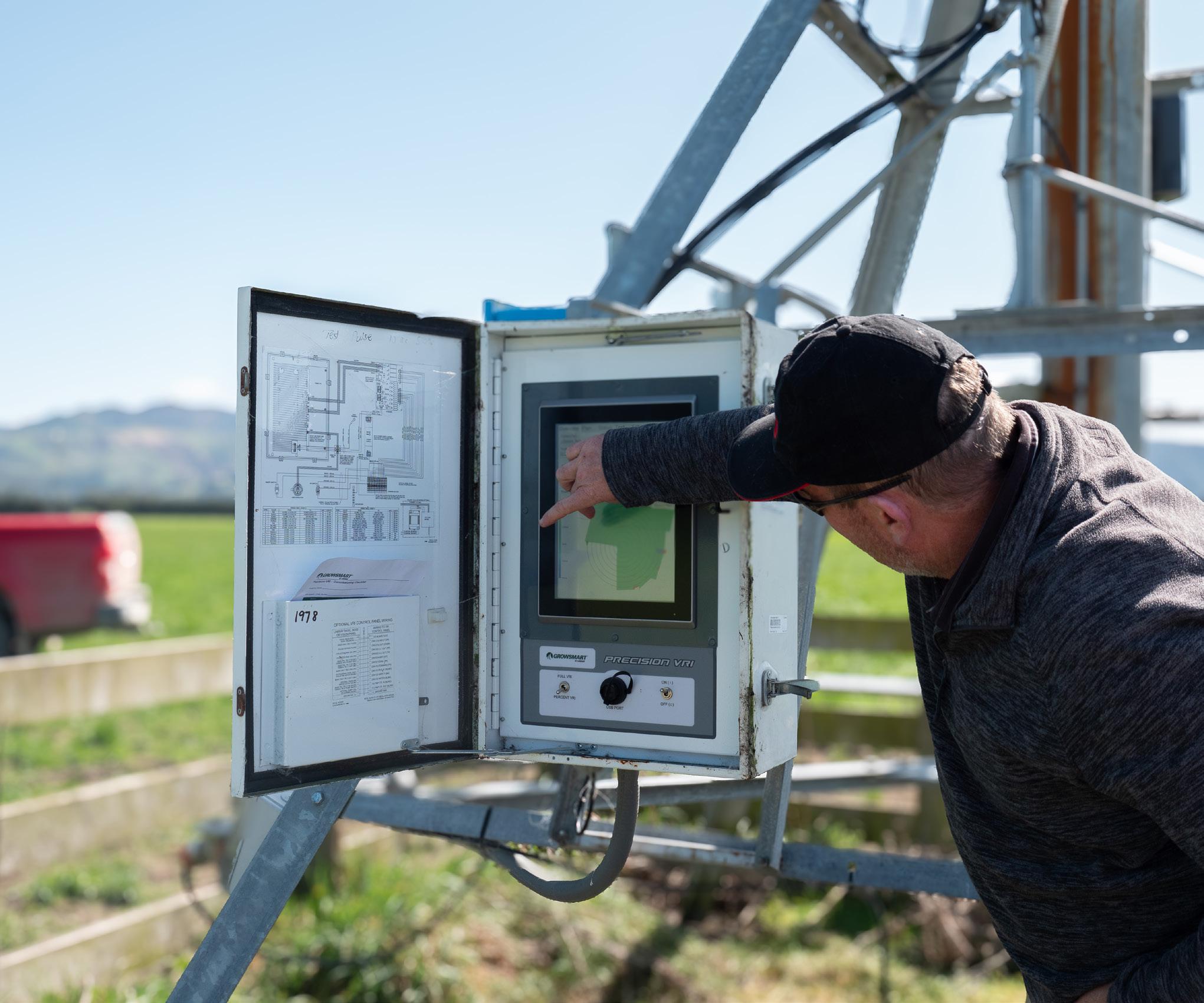
The couple has had a bull make the Friesian bull team at CRV. Parkdale HRS Federal went for sire proving in 2015 and was included in the CRV catalogue a few years later. His mother, Parkdale Fire Flower – Flower to Stu and Lynn – is seeing her days out on the farm, retiring about five years ago. Once she’s gone she’ll be buried under the trees with her daughter and grandmother.
Stu says the collars have helped identify non-cycling cows early, allowing intervention programmes to be better targeted. They’ve also helped with animal health, indicating if a cow needs attention well before even keen stock people like he and Lynn might spot them.
The rumination data has been particularly helpful and interesting, he says.
“We’re really watching that over the transition period – it’s a good early warning system,” he says.
While the collar data is the first thing Stu looks at each day, it’s the soil moisture information and water budget data that’s a close second – up on the screen before the first cup of coffee has even had a chance to cool down.
‘In dollar terms the VRI has saved us about $70,000 on track maintenance over the past three years – that’s serious money.’
“Managing the irrigation and upgrading it over time is probably the area where we’ve been able to have the biggest impact on how the farm performs,” he says.
The couple are both originally from nearby Rangiora, but spent 15 years in Southland contract milking before progressing to herd-owning sharemilking and then to land ownership there.

• Owners Stu and Lynn Parker
• Location Oxford, North Canterbury
• Area 95ha
• Cows 285 Friesian and Friesian-cross
• Supplement 1.1t DM/cow, palm kernel and silage
• Production 500–530kg MS/cow
• Irrigation Variable rate irrigation centre pivot, pods, laterals and fixed grid.
ABOVE The pivot reduced the return rate compared with the previous system.
OPPOSITE PAGE LEFT Stu - actively managing water use is important. RIGHT New fixed grid sprinklers are gradually replacing pods.
“We had a small farm down in Southland but we both wanted to be back up here, so when we saw this farm for sale we decided to buy it and convert it to dairying. It was in potatoes, sheep and cropping and was originally 60ha but we bought some neighbouring land and did a bit of a land swap to get it to 95ha.
“It had a water allocation from two bores. We had hoped to increase our water intake for the consent but we weren’t able to do that.” The annual volume allocation is set at 262,000m3, combined across both bores which sit at 43m and 23m deep.
“We’ve never used our full allocation, but it takes a fair bit to manage it and in the earlier years we were getting very close to that annual volume limit.”
Last summer, after particularly low rainfall and drought conditions for North Canterbury, Stu says the bores ran dry.
“It was the first time in 15 years. We hadn’t even hit our allocation – we still actually had about 50,000m3 – but the water wasn’t there.”
He called in irrigation specialists who advised him it was very likely the aquifers would recharge again quickly once it
rained and to hold off spending money drilling down to deeper aquifers at 100–120m. Not only would it be an expensive capital cost, the ongoing operating cost of electricity to pull water from that depth under the ground would be much greater than their current costs.
The aquifers have recharged and Stu is hopeful they’ll stay that way this season. Originally, when they converted, they had one large, rotating spray irrigator with a 30-day return rate. That meant it took 30 days – nearly a month – to get around the whole farm with the irrigator, leaving it way too long between drinks for the pastures in the heat of the summer and during periods when the hot, dry, moisture-sucking nor’wester was howling.
“It just wasn’t efficient putting water on that way. We were pouring it on –basically flooding paddocks as we went but it took too long to get around the farm and back to paddocks again. It was also labour-intensive having to go out and move the irrigator when each run (on a section of a paddock) was finished. Sometimes that meant going out at odd hours in the night to shift it. If we had a breakdown we were in trouble.”
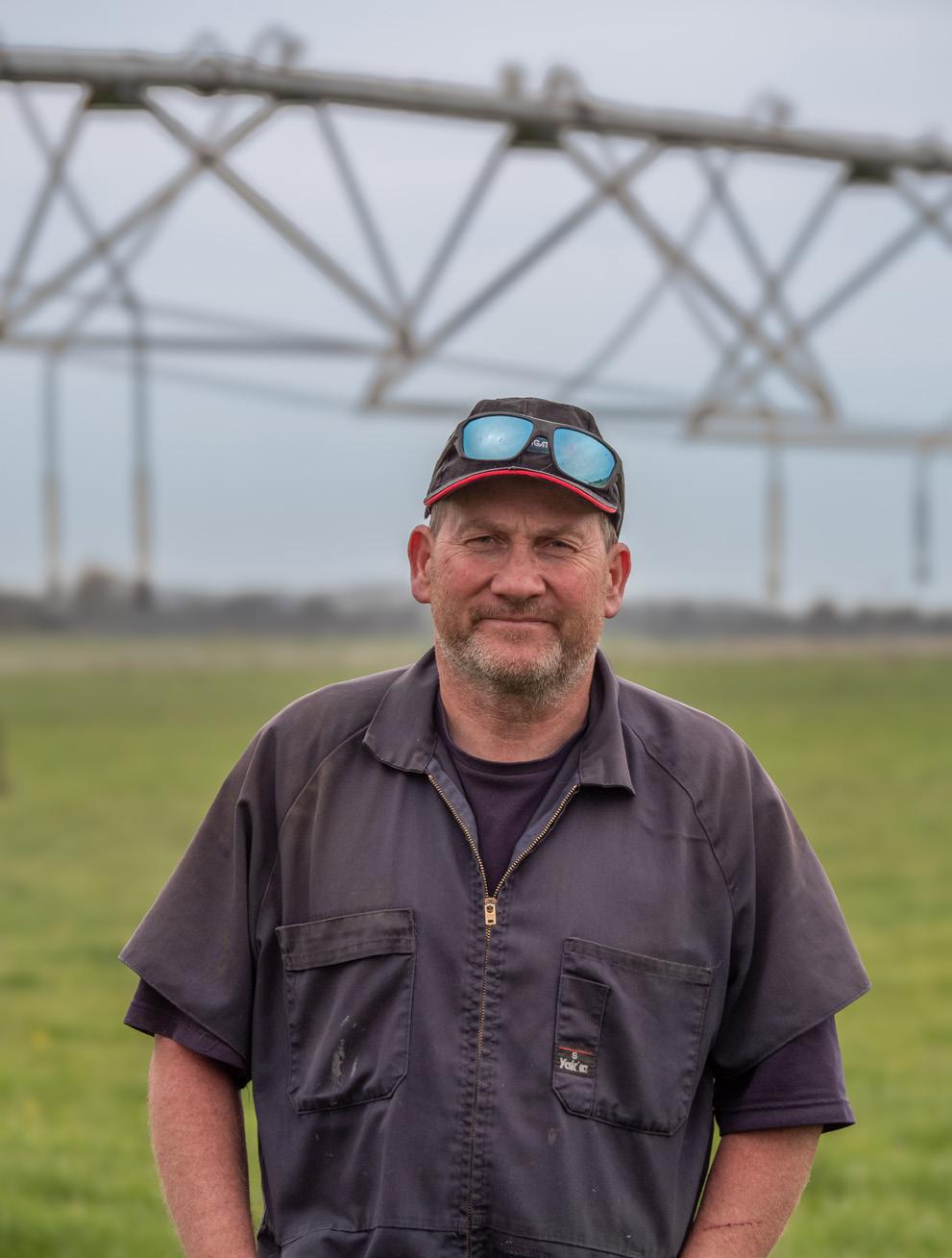

After a few years of trying to manage that way, Stu and Lynn talked to the bank and made the case for investing in a pivot irrigator.
“We put on a nine-span, 464m pivot that covers 64% of the farm and we put pod sprinklers and laterals on the rest.”
Power pylons across part of the western side of the farm meant the whole area couldn’t be watered by additional pivots – although the capital cost was probably prohibitive then too, Stu says.
The pivot and the six soil moisture meters in the form of strips buried at strategic depths immediately allowed water-use savings and made for more efficient and effective watering.
There are water meters on the bore pumps and data from them and the soil moisture meters is sent via telemetry to a monitoring and technical advisory data service, Onfarm Data.
The water volume use is sent on to Environment Canterbury for compliance monitoring purposes although that’s a number Stu keenly watches daily, if not hourly through the height of the irrigation season. He has his own water budget
calculation so that he’s always aware of where they’re at when it comes to water use and how it’s tracking in terms of getting them through the whole season.
“We maintain detailed records of irrigation stop/start dates, weather conditions and water allocation. I’m constantly taking note of what we’ve used to date and planning ahead based on that information.”
He watches the soil moisture graphs closely. The aim is to keep soil moisture levels between full point and refill point. They’re levels that vary based on soil type. The Oxford farm is two-thirds Pahau soils which are described as silty loams over clay and one-third Darnley silt loam. If rain is forecast and it looks like it will actually happen and soil moisture is sitting at the higher end, he can afford to turn off the pivot.
Stu says that after a couple of years with the pivot he felt they were managing their water allocation in a much more efficient way, but there were still improvements to be had. The couple were becoming increasingly frustrated by the damage and mess caused by the irrigator passing over laneways and tracks.
“We were spending tens of thousands of dollars on track maintenance – getting rocks the size of small boulders on the tracks, and cows were coming in with mud kicked up on them. It was just wasting water we couldn’t afford to waste and causing a headache we didn’t need.”
After talks with their irrigation system designer and supplier Dan Stephens from Plains Irrigators, Stu and Lynn decided to upgrade the pivot to a variable rate irrigation (VRI) system.
It meant a whole new range of sprinkler heads on the 112 sprinkler ports, a new Zimmatic VRI controller system including a GPS unit, Baccara solenoid valves to control each sprinkler head and a new software system.
There is a wireless network of control nodes along the length of the pivot so at any point in time, the VRI software knows where every sprinkler is relative to the area watered by the pivot and what the nozzle size is.
That way it knows exactly how much water is required and manages that application rate by turning the valves, which manages the flow of water to the sprinklers, on and off over a specific time
period. That in turn allows variable rates of water to be applied over specific areas, enabling different rates for different crops versus pastures.
For Stu and Lynn, the big winner has been the ability to block out areas on the map of the farm held by the system’s software and turn the sprinklers off over those areas.
“That alone has saved us watering 2ha of tracks – it’s equivalent to 0.8 litres/second or 2.9m3/hour and about 7250m3 annually – that’s 7.25 million litres of water saved just by not watering the tracks and lanes.
“When the pivot sprinklers are off over the tracks, that water can be pushed out to the pods so it’s another 2ha that’s getting watered every two or three days and it’s better going out onto paddocks than being wasted on the tracks.
“In dollar terms we’ve saved about $70,000 on track maintenance over the past three years – that’s serious money. And I think it’s helped with animal health too, although that’s hard to quantify, but we’ve had less lameness and it’s probably helped with mastitis too.”
Every year Stu and Lynn have the irrigation system bucket tested and commission tested to ensure it’s applying water at the rate it was designed to. It’s important for compliance and sustainability goals, but Stu says spending money carrying out the annual testing is a no-brainer because water is too valuable as a resource to not be getting it right.
“We have a finite amount of water to use every season and we have to make sure we use every drop of that as efficiently as possible.”
While carrying out detailed annual testing could arguably be easier for someone with just one pivot than it is for those with a lot more irrigators, the benefits and water savings are going to be even greater for those with more – the benefits are amplified and there’s even more at stake.
“I know some people might plug in their pivots and walk away and never test them again, but I don’t think anyone can really afford to do that.”
Stu says his next step is to fine-tune the system and become even more precise so that they water at variable rates according to the variable soil types.
“We’ll also look at getting variable speed drives on our pumps because at the moment we don’t have them on our wells so we manage pressure in the system by turning our pods or our fixed grid sprinklers on and off.”
At times when Stu is wanting to conserve water he can slow the pivot down and reduce the flow, but that causes the pressure in the system to increase. By turning the pods or fixed grid sprinklers on he can bring the pressure in the system down which protects the pump from shutting down.
“A variable speed drive on the pump would solve that issue because it would automatically be ramping up and down relative to what the pivot is needing.”
Before the VRI, when aquifers were getting low, Stu could also nozzle down the pivot – physically changing more than 100 nozzles
‘We have a finite amount of water to use every season and we have to make sure we use every drop of that as efficiently as possible.’
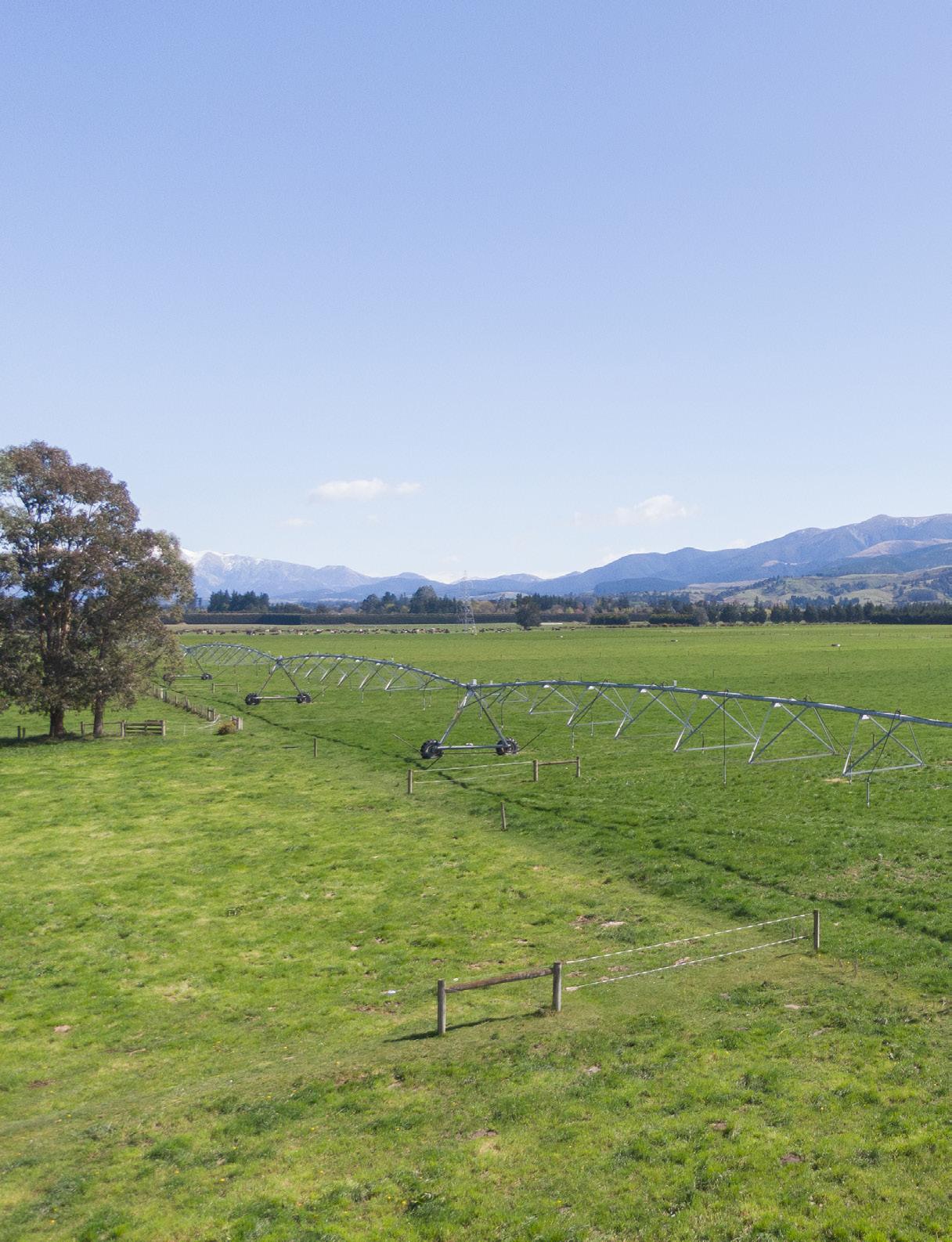
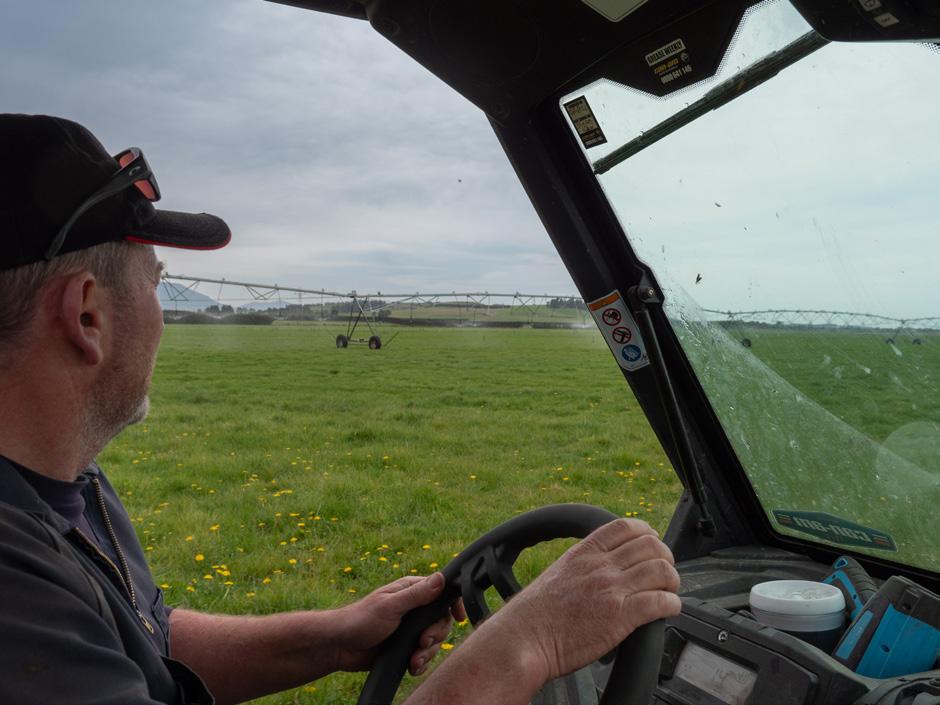
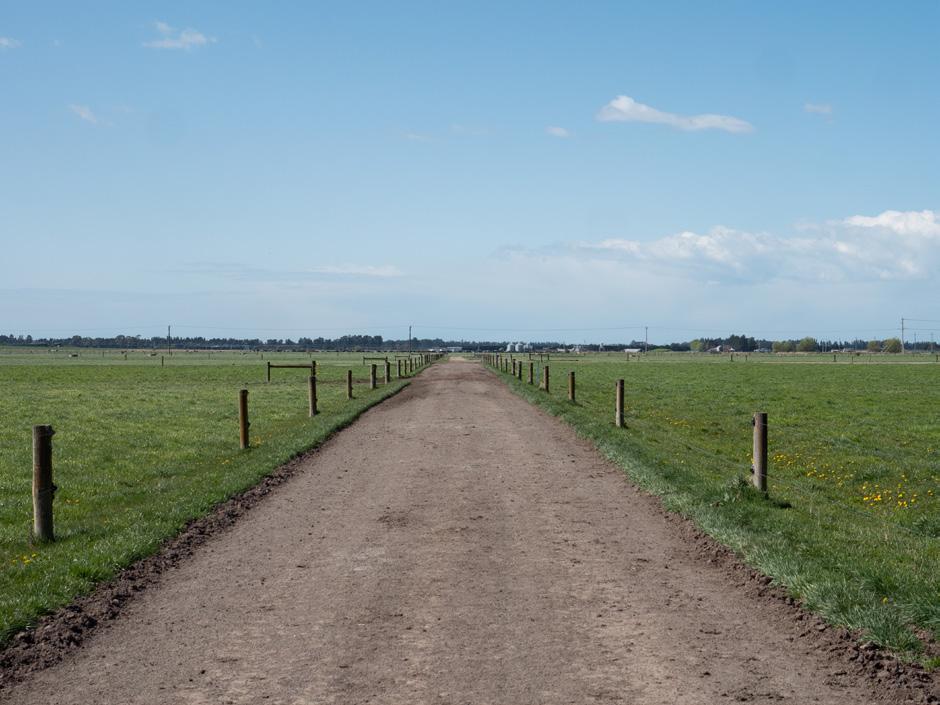
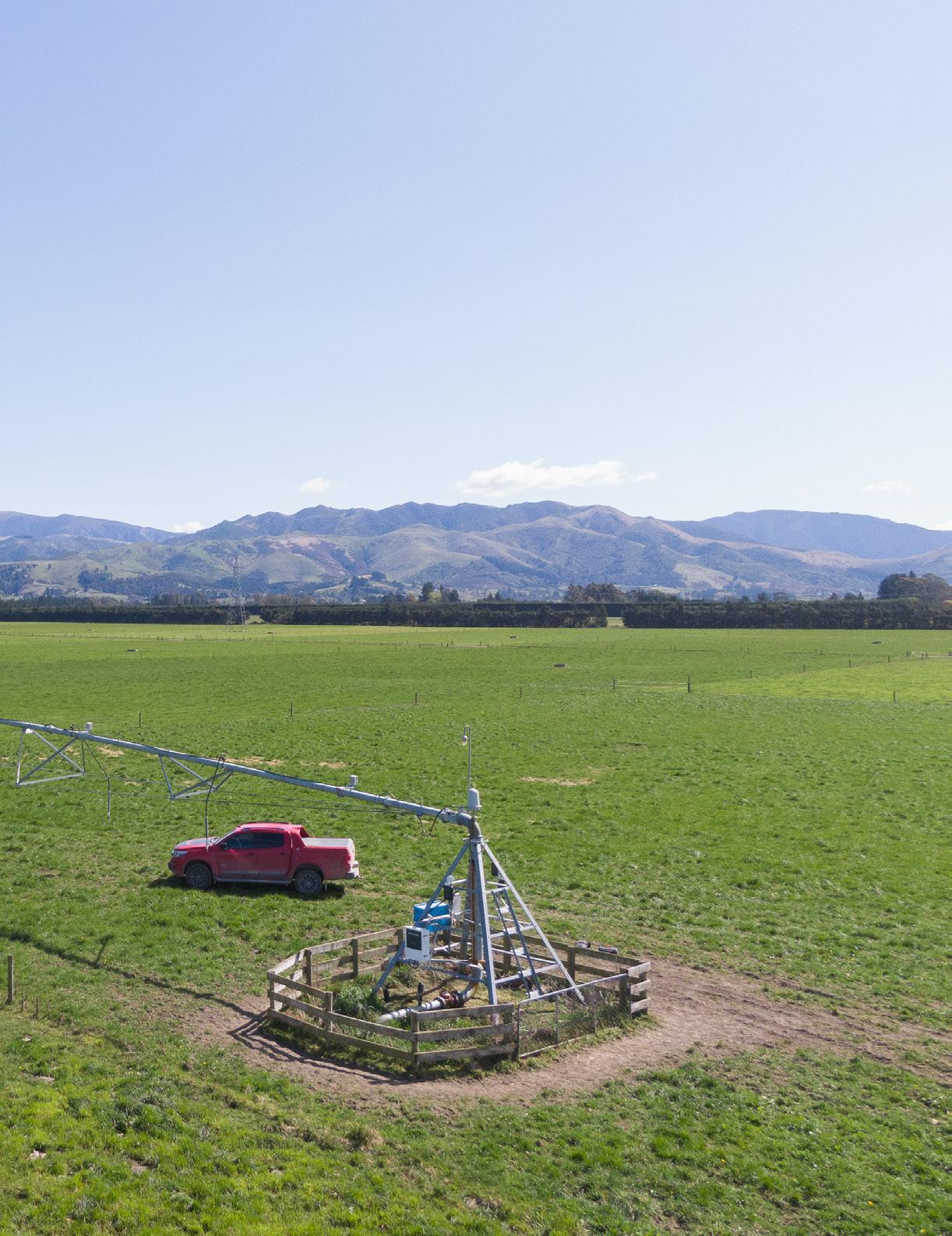

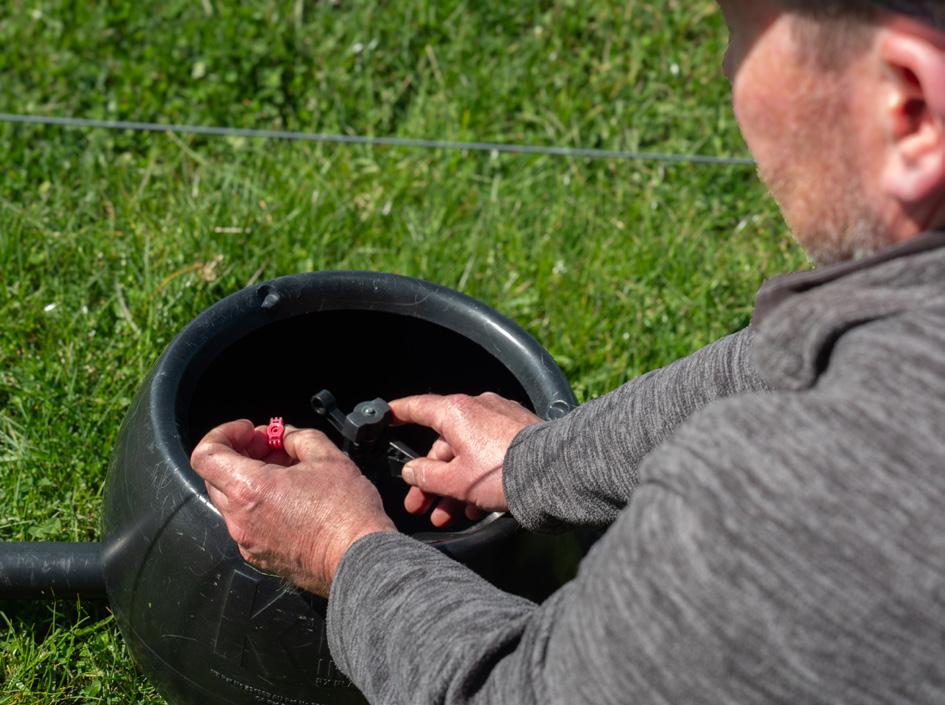
LEFT Shoulder season management is important to make the most of annual allocation volumes. MIDDLE LEFT Stu has the pivot commission tested annually. BOTTOM LEFT Lanes stay dry with VRI. MIDDLE RIGHT Lynn - collars have helped with six-week in-calf rate. BOTTOM RIGHT Maintenance improves efficiency.
to alter the water flow rates. It’s time-consuming and easy to “muck up” the order of the nozzles along the irrigator, he says.
“You have a card that tells you what the pattern is but it doesn’t take much to get one wrong or be out by one so that the whole pattern is wrong.”
Now, he can make a change to flow rates with the push of a button, setting up different water plans on the computer without having to touch a nozzle.
Initially pods and laterals were used to water the remaining 36% of the farm, but over time Stu and Lynn have been changing those to fixed grid irrigation which is essentially sprinklers on poles – or pole irrigation. Stu says the pods are their most inefficient form of irrigation.
“The sprinklers just don’t cope with the wind here.” They’re also time-consuming, taking two to three hours to shift each day. They’re on a six- to seven-day return which is much better than the original irrigator on the farm, but still not ideal in the heat of the summer at keeping up with evapotranspiration rates.
He’s also had an issue with them applying too much water too fast so the infiltration rate of the soil couldn’t keep up.
“We added timers on each line of pods so the water on one line comes on for four hours and then switches off for four hours while another line comes on. It minimises any ponding by allowing the water to soak in.”
The fixed grid sprinkler system allows the application rate to get down 5.2mm.
In Stu and Lynn’s situation, with poles installed with a 35–40m grid pattern, the 5.2mm/ha daily application depth is achieved by having one sprinkler operating at a time and running for 30 minutes before it shuts down and the next one comes on.
At the start of this irrigation season another 15 poles and sprinklers have been added to the fixed grid system.
“We’ll keep adding more as we can,” Stu says.
He’s hopeful that this season he won’t have to manage the water allocation by having the occasional dry day where he turns the irrigators off when the soil moisture readings are saying they should be watering.
He has been tactical about water use in some seasons, hoping to keep some allocation for March and while it can mean he’s constantly running the numbers, nearby farms on the local irrigation scheme can sometimes fare no better, with restrictions in place in some years.
“We have enough but we work hard to make sure it goes the distance.”
Irrigation season has started and it’s time for a refresher. Checking the system is working as it was designed to and managing water application by monitoring soil moisture will be well worth it.
Words ANNE LEE
It’s often said that everything starts with the soil and it’s no different for irrigation.
Primary Insight director and resource management specialist Andrew Curtis told this year’s SIDE conference and the recent Lincoln University Dairy Farm (LUDF) focus day that it was important to get the basics right – understand your soil, check irrigators are working correctly and apply water according to soil moisture needs.
Operating costs for irrigation including pumping costs mount up, so even a 10% reduction in water use can lead to considerable savings.
For a 200ha farm with a bore pumping water from a deep well, a 10% reduction in water use by getting those basics
right could mean annual savings of more than $18,000.
For the same farm with a shallow bore, those 10% savings could equate to more than $12,000/year and for a farm with a surface take the savings could amount to $7000/year.
If the system meets pasture demand more closely thanks to irrigators doing what they should and water being applied to meet plant needs due to monitoring, the additional pasture growth can also mean substantial financial returns.
On a 200ha dairy farm, converting 12t drymatter (DM)/ha into milksolids (MS), a 1% improvement in pasture yield that’s converted to MS could equate to another $18,000 worth of income.
Andrew says it’s important to go back to basics when it comes to understanding irrigation needs and managing it correctly.
“Knowing your soils is key. Do you understand your soil and how it holds and releases water?” he asks.
Soil water-holding capacity is the main driver of how and when water should be applied. It is determined largely by the soil’s texture and organic matter content. Stone content is also a consideration in many areas with stonier soils having less water-holding capacity. A silt loam will have a much higher water-holding capacity than a sandy soil and tolerate a longer return rate or be later in requiring a start for irrigation.
Once you understand your soil’s waterholding capacity you need to make sure the full point is set at the right level and check the trigger point is also correct.
The aim is to operate between those two points.
The full point or field capacity is the maximum amount of water the soil can hold that is available to the plant. It is not saturation point – that’s the point where, if any more water was added, it would drain out the bottom of the profile, pond on the surface or run off. Getting the full point right is critical to achieving good-practice irrigation.
‘Check that what you’re seeing on the screen in terms of the soil moisture trace is lining up with reality.’
ANDREW CURTIS Primary Insight director and resource management specialist
Trigger point or refill point is the point at which irrigation is deemed necessary – it is set above stress point, which is the soil moisture level at which plants experience water stress that limits production. That point will be different for different crops and pasture.
Trigger point or refill point is set based on a percentage of plant available water (PAW) which is equivalent to soil water-holding capacity or the amount of water held in the soil between field capacity and permanent wilting point for the crop. The percentage of PAW will vary depending on the type of irrigator, soil type and crop.
For a pivot watering pasture, the trigger point is likely to be set at somewhere between 60 and 70% of PAW, depending on soil type, the time of year (shoulders versus peak) and the capacity in the irrigation system.
Andrew says it’s important the soil moisture monitor is adding value to your business and not just a tick box exercise for compliance.
“Water use is one of the largest operating expenses on an irrigated farm, particularly for the recent irrigation scheme developments, and can cost plenty to pump up from deep wells. Using soil
moisture monitoring will improve efficiency with the resource and save money.
“Check that what you’re seeing on the screen in terms of the soil moisture trace is lining up with reality – if they don’t align it’s either because the probe is not working or is installed incorrectly or – more likely – the trace has not been set up correctly.”
That could mean having someone come out and re-install it or altering the full point and trigger points in the trace software.
“Either way, do something about it. It will be worth it regardless of whether it’s causing you to under- or over-water.”
With annual allocation volumes now, it is imperative farmers are paying close attention to water use continuously through the season. If your allocation is tight and you get to later in the summer and we’re having a hot, dry autumn, you don’t want to find you are running out of allocation when you weren’t really managing it effectively at the start of the season, Andrew says.
A number of irrigation systems are now reaching 15–20 years old or more and componentry is becoming worn.
“We’re seeing a lot of ‘crud’ caused by corrosion starting to cause issues, bits of rust and things. These block sprinklers and cause wear and tear on sprinkler nozzles,
regulators and valves that in turn has an effect on water application, the uniformity of that and ultimately pasture production.
“You can install manual flushing valves at the end of a pivot to help with this –providing you regularly turn the valve on and off at least weekly – or there are also automated flushing valve options.” These can save time spent unblocking sprinklers, especially in older systems.
Bucket tests and full assessments are important.
“Full assessments are the best for older machines as they involve pressure, flow, application depth and uniformity tests, where someone should be visually checking sprinklers.”
Farmers are used to maintaining machinery but somehow with irrigators they can be prone to getting attention only when there’s a breakdown or it’s very obvious something has gone wrong.
VRI technology is now a lot more reliable but Andrew cautions people to check it is working as it was designed to. Check the sprinklers are doing what they are supposed to and run the test programmes once a year to make sure the valves are turning off and on, he says.
“If you have tech, learn to love and look after it,” he says.
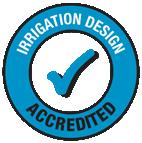





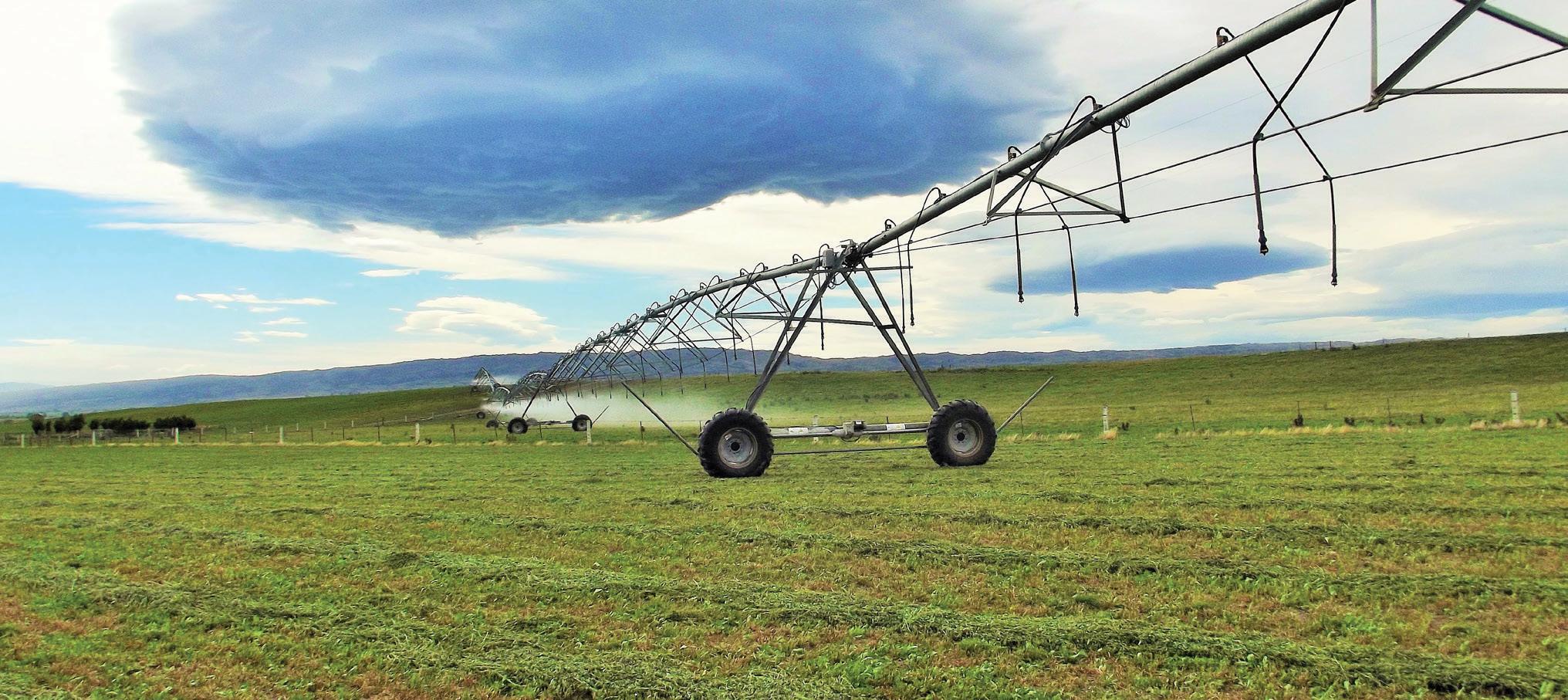

A maize grower is trialling planting clover in between crops to break the cycle of insects overwintering on grass, eliminating the need for an insecticide treatment on maize seed.
Words HEATHER CHALMERS
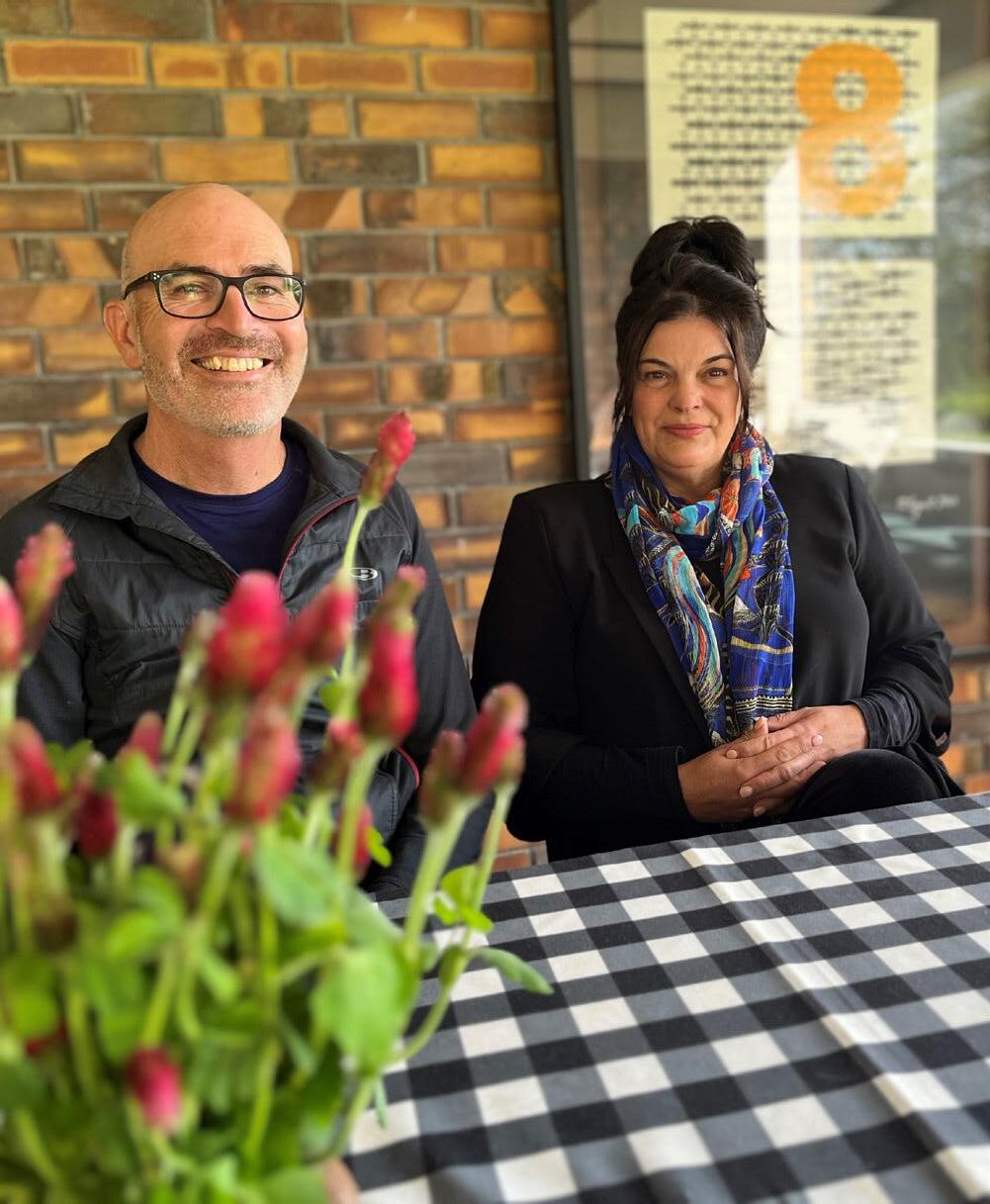

Waikato maize grower Daniel Finlayson is seeking to farm as environmentally sustainably as possible, an approach that not only benefits his farming operation, but also his dairy farmer clients.
Daniel’s farming system uses less synthetic nitrogen inputs and thus reduces carbon emissions, factors that he uses as a marketing tool when selling his maize silage. In a win for both parties, his dairy farmer clients can then use the maize to reduce the carbon footprint of their bought-in supplementary feed, helping them to meet dairy company emissions targets.
Daniel and his wife Michelle Templer farm Methleigh, on the banks of the Waipā River at Ngāhinapōuri.
Owned by Daniel’s family since 1905, the couple leased the farm and employed a manager while living overseas, with Daniel overseeing operations remotely. After stints in London, where Michelle was trade commissioner for the United Kingdom and Ireland, and in Sydney where she held a similar role for Australia and the Pacific, the couple returned to New Zealand.
After purchasing Methleigh from family just over three years ago, they returned to the property to live and actively farm.
“I didn’t know if buying the property was realistic, as it is close to Hamilton and an expensive piece of dirt,” Daniel says.
A big mortgage was a catalyst for a rethink on how the 193-hectare (160ha effective) farm was managed, not only to make it more profitable, but also more environmentally sustainable.
“We wanted to increase the maize without compromising our values on soil quality and health and carbon emissions. We set ourselves some pretty strong environmental parameters that aligned with our values.”
Daniel’s approach led him to win the Positive Environmental Impact Award at the 2024 Arable Awards.
When farmed by a manager, Methleigh was about a third each of dairy heifer grazing, bull beef and maize silage as this was a robust and repeatable system.
Dropping the bull beef system and increasing maize production from 60ha to 115ha meant growing maize on maize continually, something Daniel had previously avoided. However, the adoption of strip-till, via his contractor Darcy Finch, increased confidence the soil wasn’t being degraded.
“The reduced tillage was really important.”
In conjunction with strip-till, Finch Contracting also offers strip spraying, precisely spraying out the strips where maize will be planted using RTK (high accuracy) GPS, allowing the remainder of the paddock to continue to be grazed or cut for silage until planting.
While annual ryegrass remains the mainstay winter crop between maize plantings, the couple are also experimenting with alternative options and this year annual clover was grown for the first time.
“We have tried a few things. Some lessons have been more expensive than others.”
While other early adopters are using clover in the strip-till planting strip or in small areas, Daniel has jumped in boots and all, planting a paddock each in three annual clovers: crimson, Persian and balansa – 20ha in total – to compare their winter performance and feed quality.
As a legume and nitrogen fixer, clover adds nitrogen, promotes stronger soil biology, has a different rooting system and provides an alternative crop rotation option to grass, Daniel says.
“Making it economic is a challenge, as we can cut and sell it to dairy farmers, but returns are not as high as the livestock operation (grazing annual grass).”
Daniel has also taken a forward-thinking approach to regulations, being one of the first to complete a Freshwater Farm Plan in the Waipā District, as part of a FAR case study.
Sown in March after maize, clover produces three tonnes/ drymatter compared with 6–8t/DM for annual grass.
“But if we can gain additional benefits from it, it will be worthwhile,” says Daniel.
As well as reducing application rates for synthetic nitrogen, adding clover to the system also breaks the cycle of insects overwintering on grass, eliminating the need for an insecticide treatment on maize seed and saving about $50/ha.
Chicken manure, a byproduct of the broiler chicken industry in Waikato, is also broadcast just before maize planting, providing another alternative to synthetic N applications.
“The nutrient profile of chicken manure suits the maize system as it provides N, P, K and calcium as well as organic matter. The timing of the release of nutrients from chicken manure is always being debated but if you apply it each year there is a rolling availability.”
Delivered in winter, the chicken manure is stored until ready to use, with Daniel experimenting with ways to stop the release of its notoriously stinky odour.
“When you open up the pit there is an enormous amount of ammonia that is released, as well as some nitrous oxide. During this process you are losing carbon and nitrogen and releasing polluting gases which offsets some of its benefits. So, I am figuring out how to store it without the polluting gases.”
This year he tried a method of fermentation without oxygen, similar to making maize or grass silage. Once put in a stack with an inoculant added, it is compacted to exclude oxygen and then covered. Initial results are promising.
“It didn’t have the ammonia smell when we opened the stack so we are hoping that will translate into more nutrients in the ground.”
Daniel is part of a Foundation for Arable Research Growers Leading Change group looking at alternative-N options in maize.
He is one of several members carrying out what are known as onfarm try-outs, rather than trials, because they are not scientifically replicated. On his farm this includes chicken manure treatments with and without starter fertiliser and side dressings.
In first-year results last season, the chicken manure and starter fertiliser yielded the same as other plots with additional side dressings. The same treatments will be replicated again this season.
“If the results are repeated, I will definitely drop nitrogen rates. We need to be bold and actually act on the results.”
He has already dropped his maize side dressing to 150kg/ha of urea in some paddocks.
Nitrogen applications are based on deep N testing prior to side dressing and then using the online AmaizeN tool on FAR’s website to calculate application rates.
Overseer is used to calculate GHG emissions, with Methleigh’s down 25% from the 2021 baseline. Daniel is
awaiting the release of the cross-sector emissions calculator which would put his farm and his dairy farming clients on the same footing.
Daniel has also taken a forward-thinking approach to regulations, being one of the first to complete a Freshwater Farm Plan in the Waipā District, as part of a FAR case study. While the roll-out of Freshwater Farm Plans has since been put on hold by the Government, Daniel says it was still a worthwhile exercise and not a big step up from a Farm Environment Plan.
“It changed the emphasis in the decision-making process. It has helped in subtly altering my perspective on the place and role of the waterways on our farm and in our wider community. Rather than looking down on them from the paddock above, it has helped put me in the waterway’s shoes and ask what is the impact on me.”
About 30ha of gullies and waterways and the farm boundary with the Waipā River are fenced off and planted in trees, both exotic and native.
Several farming families, including Daniel Finlayson and Michelle Templer, are providing land for the development of the Ngāhinapōuri Walkway which aims to connect the community and restore the Mangahia Stream corridor.
Community members are engaged in planting and ecological restoration of the 4.3km walkway, with support from iwi.
Starting at the Ngāhinapōuri School and finishing at the historic Horokiokio Pā site, where the Mangahia Stream flows into the Waipā River, Daniel says the project has also enabled him and others to learn more about the pre-European history of the area. The district was extensively farmed and populated by Māori, before European land settlement, with waterways used for travel and trade.
Daniel says that when his father farmed, Māori tools were unearthed and there were land depressions every few hundred metres where sand was dug for kūmara plantings.
Properties involved in the project belong to the Finlayson, Vickers, Coombes, Fullerton/Gore and Reid farming families as well as the Waipā District Council.
A charitable trust has been established to raise funds for the project and public access easements on private land are being formalised so that these are preserved if ownership changes hands.
The dual-use walking and cycling track will pass through native bush that includes original stands of kahikatea and the pā site.
“It will be a massive asset for the community and is an exciting project to be involved with,” Daniel says.

A Waikato dairy farmer is choosing to buy in maize silage from a neighbour which keeps his costs down and lets him focus on growing more grass on the milking platform.
Words HEATHER CHALMERS
The families of Waikato farmers Daniel Finlayson and Martin Vickers have been neighbours for more than 120 years.
While the type of farming on the two properties, adjacent to the Waipā River at Ngāhinapōuri, has changed over the decades, they now run complementary operations, with Daniel supplying maize silage for Martin’s dairy farm.
Martin has been buying maize silage from his neighbour for 28 years, purchasing 180 tonnes of drymatter last year.
“As it is close, it keeps cartage costs down,” Martin says. “We focus on growing more grass on our farm and buy in maize.”
He aims to operate a sustainable system and is pleased to have a relationship with a maize silage supplier that is actively seeking to reduce his carbon footprint.
Fonterra is forward-thinking in setting GHG emissions reduction targets and making its farmer-suppliers aware of changing market requirements, he says. “It is about looking after the land.”
Martin and his wife Maggie run a 250-cow winter milking operation supplying Fonterra. Calving is from February to April, with the herd dried off at the end of December. The out-ofseason production means they need a two-month feed buffer on hand in case of a dry autumn during calving.
“Our inputs are high because we supply milk through the winter.”
The farm has also invested in infrastructure including a covered feedpad.
While Martin has grown maize himself in the past, he doesn’t think he will again. This is because it can be supplied off-farm at a consistent quality.
“With maize silage, there are only two things that change: the amount of grain and drymatter.”
In contrast, he has encountered feed quality issues with bought-in grass balage. He now prefers to make his own grass silage, from onfarm spring feed surpluses, which also reduces plastic use.
“To do that we’ve got to have areas available and if we grow maize we won’t have enough area to make grass silage.”
The other bought-in supplementary feeds he uses are molasses and soybean meal, a byproduct of the extraction of soybean oil.
“I don’t like palm kernel because of its negative connotations (including deforestation) and because it’s only about 50% digestible.”
While soybean meal is more expensive on a per tonne basis compared with palm kernel, its higher protein and digestibility means less is fed, Martin says.
Meanwhile, Daniel is working on supplying maize silage which provides the best milk response for his dairy farmer clients.
He is also growing clover, which can provide a high-protein source of feed for dairy farmers, rather than them using an alternative imported feed with a much higher carbon footprint.
“So, it’s looking for that win-win,” Daniel says.
A study monitoring heifer growth rates on winter crops has shown the importance of testing all winter feeds for nutritive value and formulating winter diets to ensure nutrient requirements are being met, rather than just allocating feed on a drymatter basis.
Words ANDREA DIXON & DAWN DALLEY
For dairy farmers around New Zealand it can be a difficult balance to find the right mix of a cost-effective feed that ensures consistent growth rates, milk production, optimum body condition, and nitrogen mitigation. Add in seasonal weather challenges and poor pasture growth, and the balance can be right off.
Most NZ dairy farms use pasture-based feed systems with crops added as a supplement during lactation, or as the main diet during the non-lactating period when pasture growth is low. The timing of calving and dry-off periods is designed to match pasture growth. Over the colder months cows are traditionally provided with different combinations of pasture, crop and conserved forages.
For years dairy farmers, particularly those in the South Island, have supplemented feed with crops such as swede (Brassica napus) and kale (Brassica oleracea), the latter of which has a higher yield of metabolisable energy and crude protein compared to ryegrass.1 Fodder beet (Beta vulgaris) is often used as an alternative to these winter brassicas.
Fodder beet is renowned for its high yield potential, low environmental impact (with lower nitrogen content in the bulb), relatively high energy content, and lower cost per kg drymatter (DM) than other feed options.2 These all make it a favourable option for farmers when comparing the various feed options.
The compromise comes in the nutritional content with fodder beet having a lower crude protein (CP) content than other feed options.
Until recently little was known about the impact of this nutritional deficit on heifer performance and growth and whether the lower CP resulted in insufficient dietary nitrogen to meet nutritional requirements for growth.
In 2019, researchers from DairyNZ and Lincoln University conducted an observational study at the Southern Dairy Hub, looking at 191 Friesian-Jersey crossbred heifers (9–12 months of age).3 These animals were allocated winter diets that matched the diet of their dam when in utero.
The aim of the study was to monitor the performance of rising one-year-old dairy heifers when managed in cropwintering systems typical of those offered in the southern South Island and identify any nutritional or performance risks.
Both mobs also failed to achieve the 60% of mature liveweight target at 15 months with the kale-fed mob achieving 54% and the fodder beetfed group reaching 52%
To compare liveweight gain and grazing behaviour, the heifers were offered either fodder beet or kale in conjunction with pasture balage as a feed supplement. Diet DM allocations were determined using DairyNZ’s winter-crop allocation calculator and designed to supply 72MJ ME/heifer/day. The fodder beet bulb had a higher DM content than the fodder beet leaf and kale, while the balage DM was higher than both crops. The fodder beet bulb had the highest MJ ME/kg DM than that of all other feed, however, there was a trend for the CP to be lower. In both treatments, the CP content was lower than the minimum requirement for optimising growth with fodder beet 11.4% CP (versus the optimum 15–17%).
The researchers hypothesised that the protein intake restricted the heifers’ growth as neither mob achieved the target daily liveweight gain of 0.6kg/day. Both mobs also failed to achieve the 60% of mature liveweight target at 15 months with the kale-fed mob achieving 54% and the fodder beet-fed group reaching 52%.
“This result highlights the importance of testing all winter feeds for nutritive value and formulating winter diets to ensure nutrient requirements are being met, rather than just allocating feed on a DM basis,” the researchers stated.
Alongside considering balancing nutrition and cost for feeding heifers, and applying the research above onfarm, it is also important to consider other crucial areas of replacement heifer management, including their liveweight targets.
Heifer liveweight at first mating and calving is known to influence reproductive performance and milk production potential, so it is something to focus on from the beginning. Failure to achieve mating targets risks their first calving being delayed and fertility during the next mating period reduced. Heifer replacements are the backbone of the future herd so getting them off to a good start can deliver both economically and environmentally.
Ideal liveweight targets are when you aim for 30%, 60%, and 90% of mature weight at six, 15, and 22 months, respectively. Achieving these targets has been shown to have the best impacts on heifer outcomes long term, while offering a clear indication of well-grown stock, and the ability to identify when additional management may be needed to keep them on track.
Targets also establish an agreed position for farmers involved in a contract grazing relationship and a basis for conversations if performance is not being achieved.
Most dairy farmers and farm advisers can recognise whether heifers are in good or poor body condition, but few can judge whether heifers have achieved target liveweights for their particular age.
While there is no strict rule around how often heifers should be weighed, the general recommendation is for a minimum
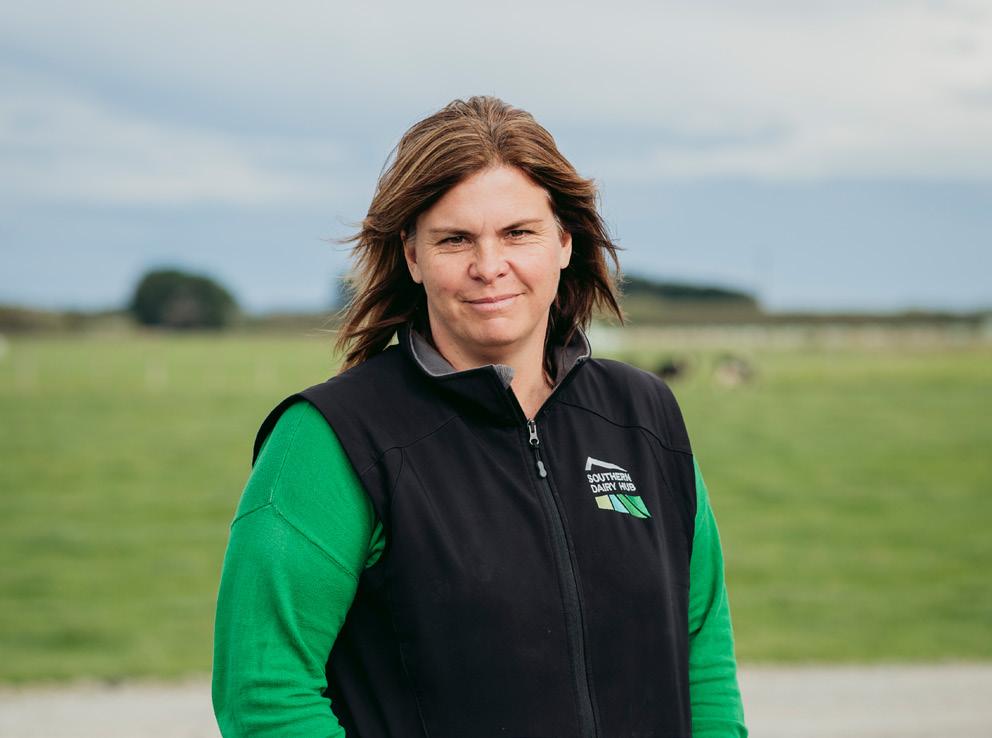

of every three months. Regular weighing helps provide a more accurate assessment of how well heifers are growing compared to targets and allows prompt response if remedial action is needed for animals off target.
Tools like DairyNZ’s InCalf Heifer Rearing Tool are also available, to help assess the growth of a given group of heifers versus liveweight-for-age targets and its impact on reproductive performance and milksolids production. It supports onfarm decision making, and whether your heifer mob is on track, or any potential implications that may arise from their current weight.
Applying this information alongside the research above and feed considerations helps to ensure the best all-round outcomes for both the animal’s growth, and overall farm performance.
Additional information is available at dairynz.co.nz/heifers
1. Rugoho et al. (2014)
2. Beef+Lamb NZ Supplementary Feed Guide Factsheet
3. Harris et al (2021)
References:
Gibson, MJ, Rogers, CW, Back, PJ, Dittmer, KE, Wehrle Martinez, A, Dalley, DE, Woods, RR. Can the effects of intrauterine growth retardation on bone morphology be overcome by first calving? – A preliminary study. As yet unpublished
• Gibson, MJ, Rogers, CW, Back, PJ, Dittmer, KE, Wehrle Martinez, A, Dalley, DE, Woods, RR. The intrauterine effects of a maternal winter diet of either kale or fodder beet on measures of calf stature and bone morphology at birth. As yet unpublished
• Harris, P, Dalley, DE, Bryant, RH (2021). The effect of feeding fodder beet or kale during winter on growth and behaviour of rising-one-year-old dairy heifers. New Zealand Journal of Animal Science and Production. Vol 81: 81–86
Rugoho, I, Gibbs, S, Edwards, G (2014). Dry matter intake and body condition score gain of dairy cows offered kale and grass. New Zealand Journal of Agricultural Research Vol 57: 110–121.

The new government has put pause on the roll-out of Freshwater Farm Plans, but what should dairy farmers do now while the water is still going under the bridge with legislation and bureaucracy? Resource management specialist Tammy Deans highlights what dairy farmers should be focused on with their farm environment plans to ensure they’re bringing in freshwater focus.
Words TAMMY DEANS
Freshwater Farm Plans (FWFPs) were introduced as part of the Government’s Essential Freshwater package in 2023 as the main tool to help farmers meet the freshwater standards. Most dairy farms already had a Farm Environment Plan which all vary depending mostly on region and milk company the farm supplies. The level of auditing also varies – not all regions have rules in place that require audits that are managed by councils, such as the Canterbury region where most, if
not all dairy farms have been in a Farm Environment Plan auditing regime for about 10 years. It makes sense that the Canterbury FEP audit system is what the national FWFP process was modelled off. So, environmental farm plans are nothing new to the dairy sector, but the introduction of a regulated auditing process that included the environmental farm plan being certified and then audited by persons appointed by their regional council will be new to many dairy farmers.
The requirements to have a certified FWFP came into effect for select catchments in Waikato, Southland, Horizons, Otago and West Coast. It was expected that the regulations would be rolled out through the rest of the regions so that the regulations requiring every farm to have a FWFP would be “live” by the end of 2025.
In early September the Government announced a pause to the roll-out of Freshwater Farm Plans to make changes to regulations.
The Government plans on amending legislation to enable the pause, which will mean FWFPs will not need to be developed, certified and audited while they make changes to the FWFP system. For most dairy farmers, this pause means it’s business as usual. However, the farm environmental plan evolution will continue on, and farmers need to keep an eye on what is on the horizon, as we look to be shifting to a
catchment scale management approach to tackle water quality issues. Earlier this year agriculture minister Todd McClay announced investment into rural catchment projects to improve land management practices and water quality.1 The dairy sector needs to demonstrate leadership in this space, and environmental farm plans will be an important tool in achieving water quality outcomes in catchments.
Manage your patch. Understand the water quality issues in your catchment or sub-catchment and ensure your environmental farm plan is specifically addressing those water quality issues. The pause on the FWFP roll-out has paralysed councils and the farming sector’s efforts on developing and implementing freshwater projects, but this presents the dairy industry an opportunity to demonstrate leadership and driving on-the-ground projects in catchments. The dairy industry has led the way with farm environmental planning in New Zealand. Nearly all dairy farms have an environmental farm plan and through these plans a significant number of waterways have been fenced and planted and high-risk farming activities that have the biggest impact on water quality are being effectively managed and monitored. So dairy farmers have a lot to offer in the catchment scale revolution.2
In my view there is too much focus on the right content and structure of a FWFP and the need for the perfect FWFP template, which I think is a key reason not many FWFP have been completed. It needs to be a simple, logical process of identifying the risks and writing clear actions on how you will manage the risks that impact the catchment the farm is in. Also, many environmental farm plans try to do too much, too many “nice to have” actions and the most important
actions get lost in the proliferation of paper. As such, I think now is a good time to re-evaluate the purpose of the environmental farm plan and ensure that their priority is addressing the issues of the catchment that the farm is situated in.
1. Really get to know your catchment. Councils had begun to develop their Catchment Context Challenge and Values information for FWFP’s;3 unfortunately many councils have halted this work as a result of the pause. This information is critical to farmers developing their environmental farm plan with a catchment focus. This information is available in a sense but currently it’s not easily accessible for farmers. Working with councils and catchment groups to continue to develop information on catchments is a priority.
2. Address the elephants on the farm. Many farms need to upgrade their dairy effluent systems, and the prospect can be overwhelming, particularly from a financial sense. As the saying goes, there is only one way to eat an elephant: one bite at a time and an environmental farm plan is the tool to best plan how to achieve the more difficult projects. DairyNZ have great resources available to support you.4
3. Change the mindset of meeting council regulations to be “good enough” and instead aim to achieve best practice. An example of this is farms in regions where consents are still being utilised to allow discharge of treated effluent to water. The dairy industry is all too familiar with public scrutiny and farmers need to be aware of the public perception on activities such as this. Consider with any practice onfarm, if farmers in other regions are getting prosecuted
1. beehive.govt.nz/release/government-backs-rural-led-catchment-projects
2. anzcc.org.nz
3. orc.govt.nz/consents-and-compliance/the-farmers-guide/fwfp-cccv-introduction
4. dairynz.co.nz/environment/effluent/effluent-system-design-or-upgrade
5. environment.govt.nz/assets/publications/Freshwater/Freshwater-farm-plan-system-overview.pdf
6. westpac.co.nz/agribusiness/sustainable-farm-loan
for doing the same thing you are doing, albeit lawfully, you shouldn’t be doing it.
4. Clarify responsibility. Who is the person who will write the environmental farm plan and ensure compliance with the environmental farm plan by making sure actions are met and audited?5 This can get murky with leasing farms, sharemilking or contract milking arrangements. Ensure when negotiating contracts that responsibilities and obligations on each party are well understood.
5. Do your environmental due diligence using a trusted adviser that has a strong understanding of the local regulatory planning context. This is vital when buying and selling farms and the quality of the environmental farm plan will play a role in how easy or hard this process will be. For the vendor, doing a regulatory farm check in advance of a property sale, to build in any time needed to address issues before it’s on the market is a worthwhile exercise. For the purchaser, it’s vital that you are able to operate the farm the way you intend. Does the property comply with all regulations? Does the farm operate to existing consent conditions? Can you operate under these consent conditions? Do you have enough water now and in the future?
6. Seek out the rewards and celebrate the achievements. Farm environmental plans are central to a farm’s sustainability reporting, and dairy farmers are ahead of the curve with established farm assurance programmes with dairy companies rewarding suppliers who achieve dairy farming best practice. Banks are also coming onboard with sustainable farm loans,6 and it’s good to finally see farmers being recognised financially for their hard work.

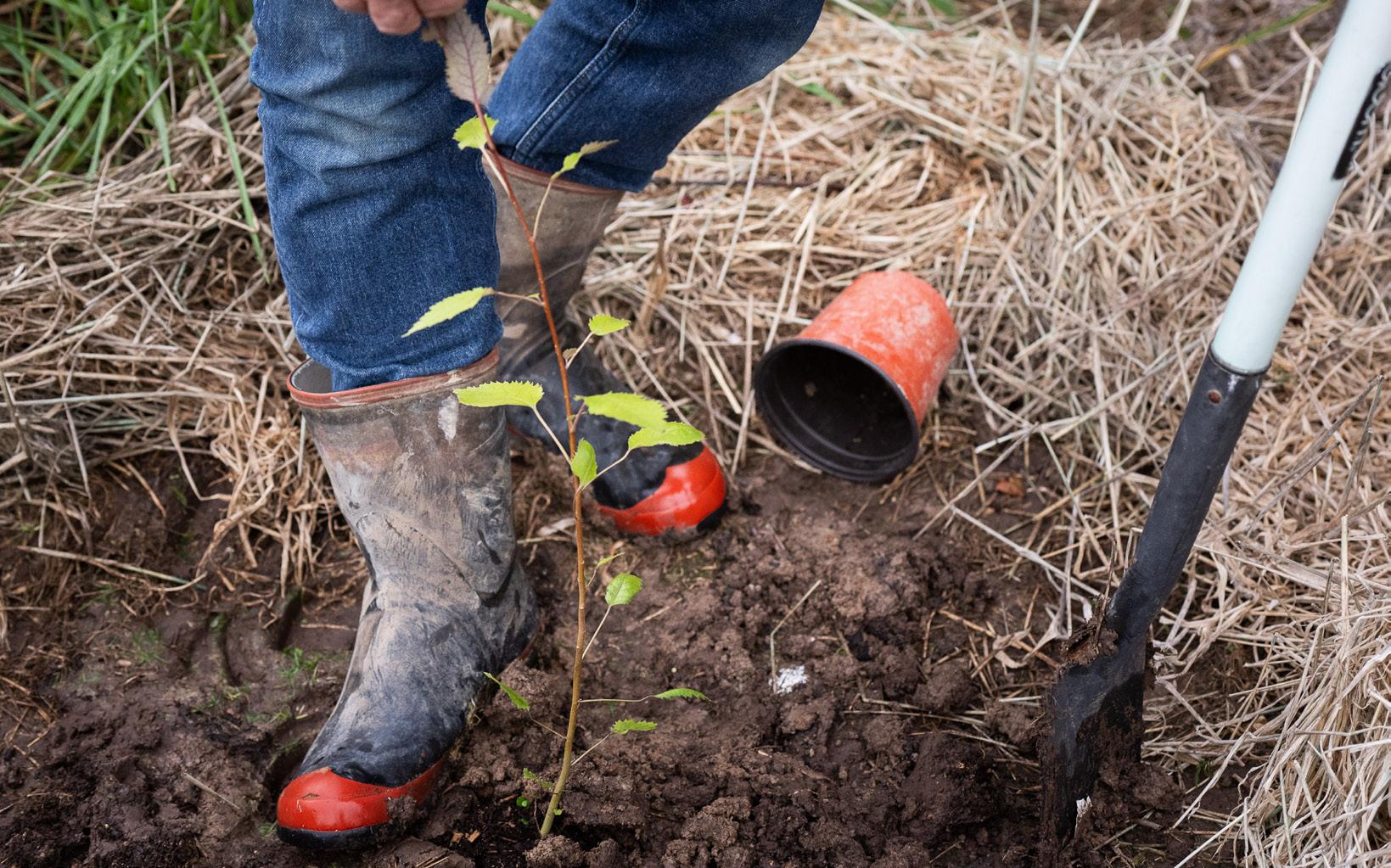
Starting next year, Fonterra will share the outputs of this tool with farmers, incorporating the data into the 2025 Farm Insights Reports.
Fonterra will be mapping the trees and plantings across dairy farms this season and will be assigning a carbon value to demonstrate the CO2 being removed from the atmosphere.
Words SHERYL HAITANA Photos MICHELLE GOOD
Fonterra is launching a new carbon removal and vegetation mapping tool this season to measure carbon stock across its supply farms, including the amount of carbon that’s locked up in trees, as well as the annual sequestration.
“Our goal is to create a tool that will map vegetation across all of our farms, allowing us to estimate the carbon locked up in trees and the amount of CO2 removed from the atmosphere,” Farm Source manager of innovation, Michelle Good says.
The tool will leverage a range of data sources, including satellite technology and publicly available aerial imagery, to identify and categorise vegetation types, including trees, riparian plantings, and grasses. It will identify vegetation types and their characteristics, such as species and age. Using the Ministry for Primary Industries carbon tables, a carbon value will be assigned to each type of vegetation.
This data is aggregated to estimate carbon sequestration on a per-farm basis, providing a detailed account of how much carbon is being removed annually.
Fonterra plans to use this data to meet its Scope 3 emissions reduction target of 30% by 2030, with a specific focus on carbon removals contributing to 8% of this reduction.
“At a co-op level, we want to ensure that these removals are reflected in our corporate inventory and in the carbon footprint of our dairy ingredients,” Michelle says.
“It will take into account the carbon removals as part of a farm’s net emissions. I think that it’s important that farmers receive attribution for their removals, just like they would an improvement on any other farm practice.”
The focus on trees is driven by their significant role in carbon removal compared to other types of vegetation like grasses and non-woody plants, which have lower carbon sequestration values, Michelle says.
However, the importance of other vegetation types for biodiversity and water quality will be important for the future.
“From a carbon removal perspective, we are primarily concerned with the trees. But we absolutely know that from a nature and biodiversity and water quality perspective, capturing that other type of vegetation is really important.
“I think it will be hugely powerful, not just from an emissions perspective, but also to demonstrate the total amount of planting that’s happened onfarm and the myriad of other benefits that it brings.”
The exciting thing about this technology is that it opens up the potential for Fonterra to collate data at a scale, and a level of detail that just hasn’t been possible in the past, she says.
“I think as this technology evolves, the type of information that we can collate and report on back to our farmers, and that we can use in our stories to customers, and to the public, will be really powerful.”
The tool will also play a crucial role in addressing land-use change, an important aspect of Fonterra’s sustainability strategy. By accurately tracking when vegetation was removed, the tool will help adjust historical deforestation records, allowing for more precise emissions reporting.

Scan to listen to Michelle on The Dairy Exporter Podcast Episode 37 – How do we use energy more efficiently onfarm?
Predator Free 2050 is an ambitious goal for New Zealand to achieve in just 25 years. Is it merely a fantasy or could this become our reality?
Words REBECCA GREAVES
Kiwi tapping on the door of your home in Wellington city?
It’s no longer a fantasy. In the decade since Predator Free 2050 was launched, great biodiversity gains have been made in NZ. But complete elimination will take a collaborative effort, and likely species-specific toxins that must be deemed acceptable by the public.
Professor of Wildlife Management at Lincoln, James Ross has dedicated over 20 years of research into the sustained control of mammalian pests introduced into this country.
Predator Free kicked off in about 2015, and people might be surprised to learn that at that point 45% of the NZ mainland was already under some form of introduced predator control, at a cost of $50-$100 million annually. A large majority of this was around possums and bovine TB eradication.
Professor Ross split the war into three categories. The first was remove – can you remove the predators? Plastic bait stations and single kill traps were the main means of ground control, but innovation and technology were needed. Detector dogs were also an important tool.
The challenge then became how to remove the last 5% of animals, they had survived because they were smart. Thermal and trail cameras revealed multiple detections of animals turning up to traps, but not interacting with them. In fact, 90% of the time they just walked past. Professor Ross wanted to discover how to get the last animals.
The Cacophony Project developed a thermal camera with the ability to play sounds. Over a period of five to 10 years they looked at different sounds and the possibility of using audio lures. An aggressive possum sound proved to be the best option to attract animals to the trap.
They then explored combination lures, particularly LED lights. For stoats, body odour from human bedding doubled catch

rates. Audio, light and social lures were all thrown together and tested in the field. Research found the audio-visual social lure was significantly better than control, doubling catch rates at high density and proving successful at low density, too.
The second phase was – can we defend? Predator fences are expensive, stand out and need maintenance. They began to explore geographical barriers, like river systems (possums don’t like getting their feet wet) and alpine ranges. They found they were able to hold the lines with possums, temporarily, using geographical barriers.
“Once you got a surveillance network in there, you needed real time data. Getting wireless communication in the field, thermal cameras with onboard AI gave a real time notification of a possum captured on camera. Then you could send in Pepper the dog to remove the offending animals, or set your trap. So, you almost have a team on the ground ready to go.”
The third and final phase was detect. How do you know you have detected everything that’s there, how do you know you have every animal? Infrared and thermal imaging cameras lifted the game another level. A detection in the field, uploaded to the cloud using AI, allows a response to be mounted immediately. Onboard AI and remote reporting are now replacing trail cameras.
Ten years on from Predator Free 2050’s inception there are 18 predator free sites in New Zealand, spanning 757,000 hectares. There has been $75.6m invested in landscape projects, $9.6m invested in research capability development and projects, and $11.7m invested in developing tools and best practice guidelines.
As for what’s next, Professor Ross says we have the elimination tools to get us close to the reality, but do they get us all the way?
“We need to get better at detect and defend, it’s a work in progress.”
Crucially, our large-scale elimination tools need to be socially acceptable. They are hoping to get a rat specific poison registered soon, there is already one available for stoats but it needs a bait for widespread aerial delivery. When it comes to possums, there is work being done on the possum genome, looking for an Achilles heel.
“If we’re going to use toxins, my gut feeling is they need to be species specific.”
Read the full article online at dairyexporter.co.nz

Breeding a more eco-friendly cow can start by selecting cows on their milk urea nitrogen trait which is linked to urinary nitrogen.
Words ANNE LEE
Asimple marker in a herd test could help farmers breed more environmentally friendly cows that might also produce milk with health benefits.
Lincoln University researchers Dr Fabiellen Pereira and Professor Pablo Gregorini are building on previous studies at the university that confirmed the link between milk urea nitrogen (N) and urinary N and that milk urea nitrogen (MUN) is a heritable genetic trait.
That work helped create a breeding value for MUN used by breeding company CRV in their LowN Sires bull team. The work also found differences between high MUN and low MUN cows’ milk when it came to some compounds or metabolites.
Fabiellen says her work in a much larger group of animals has confirmed the ability to phenotype cows for low urinary N based on their MUN levels. She’s also gone on to look at
milk composition and the rumen biome with indications from previous studies showing that low MUN animals may be partitioning nitrogen away from urine and into milk, leading to some increase in protein levels.
Dr Cameron Marshall showed, in work published in the journal Science of the Total Environment, 2020 that the percentage of protein in milk increased by 0.09 per unit decrease in MUNBV. His studies found differences in other compounds that may have nutraceutical benefits and had suggested differences in the rumen biome that may have potential when it comes to lowering methane production.
The milk of low MUNBV cows in his studies had greater content of phosphorylethanolamine which may be associated with alleviating mitochondrial stress.
The low MUNBV cows in his studies tended to have a greater abundance of Lactococcus bacteria suggesting a potential reduction in rumen methanogenesis.
Added to this was an indication low MUNBV cows could have a greater digesta flow, which suggested a change in rumen function and potentially less methane production, although that hasn’t specifically been measured.
‘Cows that naturally have a rumen biome that creates less methane without impacting on milk production efficiency will mean a more environmentally sustainable animal.’
But reducing urinary nitrogen levels in cows can help farmers reduce nitrogen loss, and cows that naturally have a rumen biome that creates less methane without impacting on milk production efficiency will mean a more environmentally sustainable animal.
“We have used cows from two commercial herds in Canterbury, and tested about 1500 cows for MUN,” Fabiellen says. “We selected the 100 highest MUN cows and the 100 lowest MUN cows based on three consecutive herd tests last year and we collected milk from them in mid-lactation, in February and then again later in March for a later lactation sample. We also took a saliva sample from 50 of the high MUN cows and 50 of the low MUN cows so we could analyse microbiome characteristics.”
Fabiellen then tested 10 cows from each subset of the 50-cow groups to give a total of 20 cows and tested urine, blood and rumen fluid samples. The rumen fluid will add to the

understanding of differences in the rumen microbe population with blood samples analysed for a number of metabolites and molecular compounds.
“We want to see if the previous studies’ findings are repeated with these cows and if there are any differences. We can also look at the metabolomics of the cows generally and see if there is anything showing up specific to them.”
Globally, identification and understanding of the metabolites is improving at a rapid rate, with their interaction with human and animal health becoming better understood.
Fabiellen will be carrying out the study over two lactations with the second now under way.
Early results from the first lactation testing have shown significant differences between the high and low MUN cows with the lowest at 11.8mg MUN/decilitre (dl) and the highest at 54mg MUN/dl for the early lactation test.
At the later lactation test, the lowest reading was 22.1mg MUN/dl and the highest 54mg/dl.
But Fabiellen says her early results have not found a repeat of Cameron’s findings when it comes to the protein percentage increasing as MUNBV drops. However, they did find in midlactation that total milksolids was up to 38% higher in low MUN cows with fat content 20% greater.
She says farmers can start assessing their cows for MUN and take the characteristic into consideration when they’re making breeding decisions given low N sires are also available.
The findings give farmers another tool in the toolbox when it comes to trying to limit nitrogen loss.
Further results from blood, saliva and rumen fluid tested are expected soon with this season’s testing under way.

Instead of
ruminating on
the
negative,
training your brain to focus on the positive and practising gratitude can shift your daily experiences.
Words KATHRYN WRIGHT
If I asked you to name three or four events that have happened to you over the last few years, what comes to mind? Probably the big things –accidents, weddings, break-ups, deaths, career changes, etc. But notice I didn’t suggest big events? Like most people, you probably jumped straight to these significant events, when each and every day contains events that can influence your mood.
The things you focus on and give the most attention to will be what sets up your emotional mindset for the day – or the week, month, or lifetime. Actively seeking out things that are going well in your day will begin to train your brain to focus on the positive, like drawing a stick many times along wet sand, and
the groove grows deeper. This does not mean that you are denying what is not going well – life can be difficult, and this is certainly not about simply wearing rose-tinted glasses and mindlessly stumbling through life pretending everything is fine.
This is about learning how to control where, on what and on whom you shine your spotlight, and recognising that there is more to your life than just the negative. It is too easy to shine your spotlight – or to intensify your focus – onto problems in your life, often around work, family, and relationships. To take this metaphor further, imagine that your life is a stage show that has a whole host of lights hanging from the ceiling. The spotlight is often fixated on a problem, while the
other spotlights remain off. What might happen if you turn on all of the lights? The problem is still there, but you are now able to also see the things that matter to you – the people you love, the activities you enjoy, your plans, hopes, and dreams for the future.
Now, practise shining your spotlight on one of those important parts of your life. The problems have not gone away, but through intentional focus and your own behaviour, start physically doing the things that support what’s important to you – make plans with that loved one, commit to starting that sport, or begin researching a new opportunity that you have been thinking about. It is your behaviours that will allow you to shift that focus.
Start to actively search out small but meaning-making moments throughout your day – these are called glimmers – to add value and depth to your life.
While our brain is busy looking for notable events – likely negative ones that need solving – there is so much that happens in our day that goes unnoticed. Shift your focus to that startling sunrise, a delicious meal, a phone call with a loved one, or training your new dog. Start to actively search out small but meaning-making moments throughout your day – these are called glimmers – to add value and depth to your life.
An easy way to get these ideas started is to make an album on your phone –perhaps call it “glimmers”. Add photos to this album; they could already be on
your phone, or they may be new ones you take just for this purpose. Soon you will accrue an album of photos that you can look back through to be reminded of what already exists in your life that is good. The active searching of material for this album will also start to create that line in the sand.
The concepts I have presented you with here are not new, nor are they difficult. It’s when we unquestioningly go through life hyperfixated or ruminating on the negative, problems that may or may not have yet occurred, or even dealing with them in unproductive
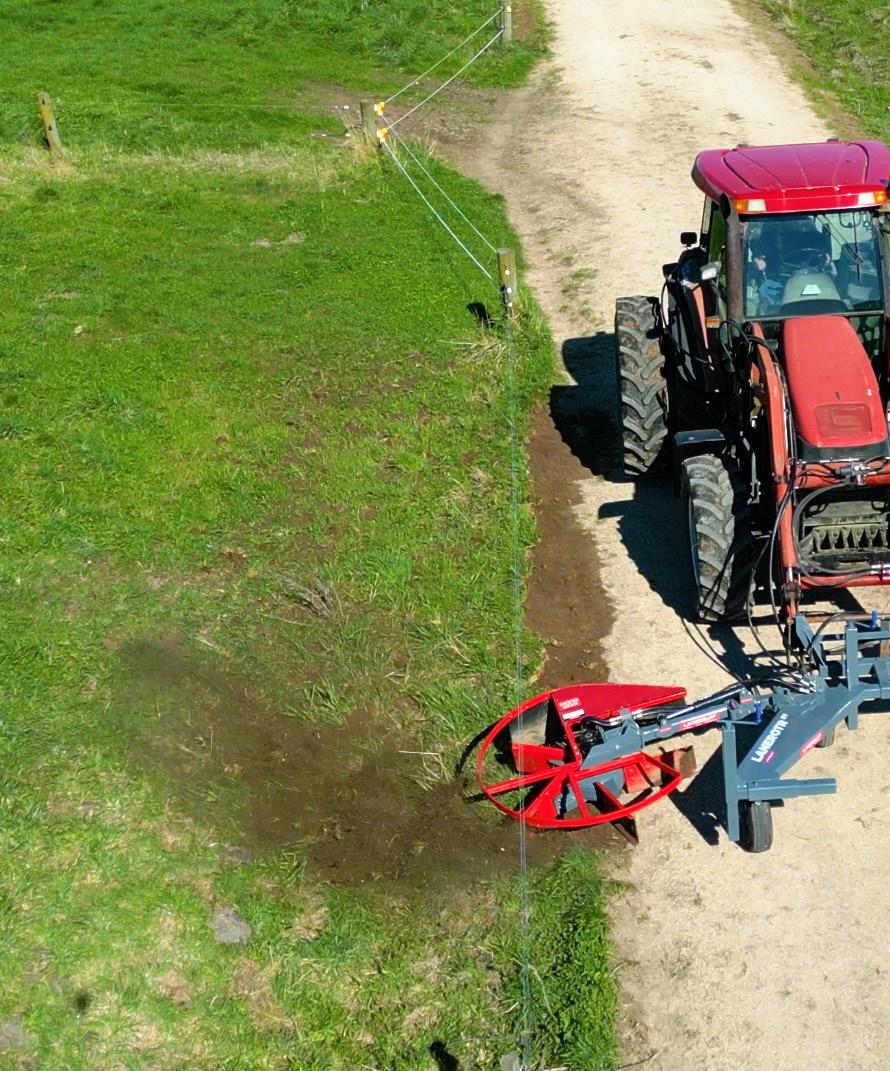
ways, that we can suffer. With a shift in perspective to how we think about things and what we focus on, we can start to build the lives we want. Start small, check your actions, and turn on the lights.
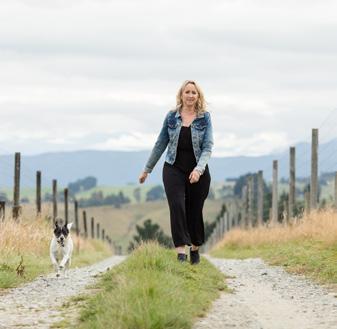
Kathryn Wright is a rural counsellor and a member of the New Zealand Association of Counsellors. kathrynwright.co.nz
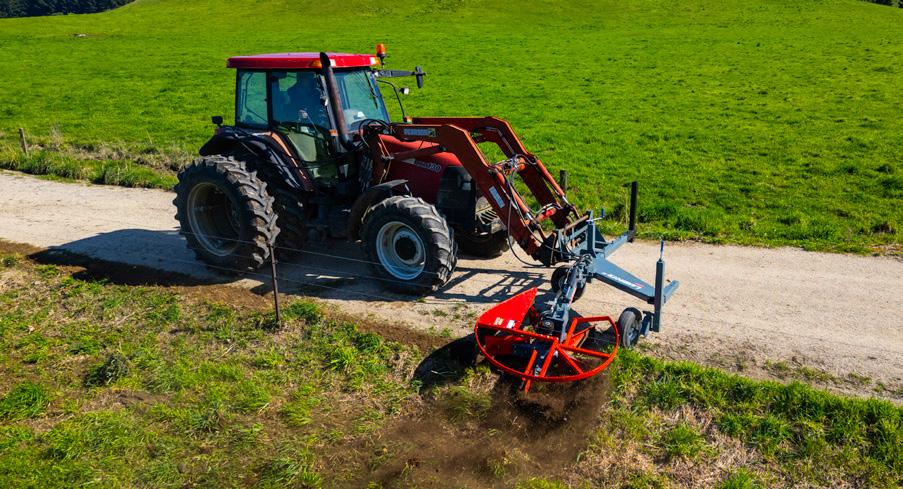


This loaf recipe can be used all year long, but the spices used, and the simplicity of the recipe makes it a great gift to make over the holiday months. It could be a thank you to a teacher, mentor, staff member, your boss, a good friend or a family member. Alternatively it could be a quick, easy dessert to make for Christmas Day. Simply serve warm with ice cream or cream, or a sprinkle of icing sugar.
½ cup (250ml) buttermilk (alternatively use 1 cup of milk and 2 Tbsp of apple cider vinegar or white vinegar and set aside until the milk appears chunky)
115g butter, softened
½ cup brown sugar (100g)
1 tsp vanilla
½ cup molasses (or golden syrup)
1 egg
2 cups plain flour (300g)
1 tsp baking soda
3 tsp ginger
1 tsp nutmeg
½ tsp salt


1. Preheat the oven to 175˚C.
2. Prepare your loaf tin (9” x 5” or 23cm x 13cm).
3. Prepare the buttermilk/sour milk, and set aside.
4. Sift the flour, baking soda, ginger, nutmeg and salt into a large mixing bowl, and set aside.
5. Cream the butter and brown sugar until smooth and pale, add vanilla.
6. Pour in the molasses and beat until rich in colour.
7. Add the egg and beat again.
8. Pour the wet ingredients into the dry ingredients, alternating between the creamed molasses and buttermilk.
9. Use your dough whisk to bring it all together into a wet mixture.
10. Once the mixture comes together, pour into your prepared loaf tin and bake for 45 minutes.
11. Let the loaf cool for 10 minutes in the loaf tin before tipping onto a cooling rack.
12. Allow the loaf to cool completely before cutting. Serve sliced spread with butter or warm up and serve with cream or ice cream as a dessert.
Philippa Cameron is the station cook on her husband’s family farm, Ōtemātātā Station in the Waitaki Valley; and the mother to two beautiful daughters who will be the sixth generation to treasure this sparse and beautiful high country environment. Alongside cooking and running her successful social media business What’s For Smoko she has published two books, A High Country Life and Winter Warmers.

Farmers are great at looking after their cows’ optimal health, but several farmers need a bit of a nudge to get along to visit their GP and keep on top of their own health.
Words DR ALICE ARMSTRONG
Dairy farmers are a stoic lot. They are a diverse group of men and women who are out there looking after their livestock and the land, producing high-quality food, immersed in our beautiful environment which is both stunning and unforgiving. Every day has its routines of early starts, milking, and moving stock, interspersed with a myriad of other unexpected tasks, while trying to slot in time for those additional projects.
As farmers we focus on optimal health for our dairy cows. To thrive in this challenging situation we also need to prioritise our own wellbeing to ensure we remain healthy, resilient and happy.
As a rural GP in the Eastern Bay of Plenty and wife to a dairy farmer, I see the challenges to farmers’ wellbeing and the benefits of being proactive about your health and having a team around you to help navigate any bumps along the way.
Thankfully now there is much more awareness around looking after our physical and mental health. Farming culture typically comes with a strong work ethic and at times farmers work excessively hard with long hours, without focusing enough on downtime and recovery.
Part of the professionalism of being a farmer is looking after your biggest asset, your health, and not thrashing yourself. This may require a bit of a mindset shift and adjusting expectations from yourself, family members and work colleagues. We want the farming journey to be sustainable and enjoyable.
I would encourage everyone to be registered with a GP practice and see them regularly. For some, that might be a yearly appointment for a check-up, for others it might be several visits a year for ongoing medical issues. Your GP, nurses and admin staff are part of your support network and there is huge value in knowing them well. That ongoing relationship helps promote regular monitoring and checks to pick up anything amiss early, and to deal with it swiftly.
When medical issues crop up, including significant diagnoses, it is really good to already know your team and have that trusted support around you. If you know your GP well, they understand what
context you’re coming from and what additional factors related to your work and home life need to be considered to navigate the medical system and provide the best care to you.
As a GP, it is a joy to know your patients and get on well with them. I really value catching up with patients and hearing how the farm is going and what else they’ve been up to, as well as the medical side of things. It is significantly more satisfying to provide care that fits each individual patient and their unique set of circumstances. Your local GP clinic is part of the fabric of your community and the GP waiting room is often pretty social – people are always having unexpected catch-ups with others.
even in young, fit people, as well as the chance of ongoing symptoms such as with long covid.
Flu vaccines are funded for certain medical conditions and those over 65 years of age. You can also fund it yourself for a small cost.
As we hear in the media there is a shortage of GPs in many areas and there can be waits of several weeks to get in for non-urgent appointments. Be organised, book ahead at a time that isn’t so busy on the farm. Write a list before you go, of the things you want to discuss and prioritise them – tell your GP the most important things first.
There is nothing quite like a patient spending 15 minutes talking about
To thrive in this challenging situation we also need to prioritise our own wellbeing to ensure we remain healthy, resilient and happy.
Make use of systems that are already in place – things like cardiovascular risk screening which encompasses your blood pressure, cholesterol and diabetes, as well as cervical screening, mammograms and bowel screening. Your GP practice will remind you what tests you need. It is useful to monitor things and track them, so we build up a picture over time and can be alerted if something is out of kilter.
A number of things can be headed off if we pick them up early, such as impaired glucose tolerance where lifestyle changes can reverse it and prevent progression to diabetes.
If you have a family history of a particular medical issue, it is worth talking to your GP about strategies to manage risk factors to reduce your chance of developing it and about regular tests that might be needed to pick up any issues early so they can be managed, for example skin checks, bone density scans and prostate checks.
Also make use of available vaccines such as covid and flu. Becoming unwell with such illnesses may not only take you out of action for a week or two, but there is the risk of developing severe illness
something minor and then at the end of the consult mentioning they’ve been having chest pain when they walk up the hill for the last six months.
Make sure you book enough time. A standard GP appointment is 15 minutes and you can really only cover one or two things properly in that time.
If you’ve got a few things to discuss, book a half-hour appointment and it may be the case that you need to go back for a follow-up visit after that.
Looking after your health is essential to feeling great and being able to enjoy your work and home life. It doesn’t have to be a mammoth undertaking; simply having a GP that you check in with every once in a while, to give you the once over, a few tests and some proactive measures is a really good start. Perhaps give a nudge to those around you to do the same.
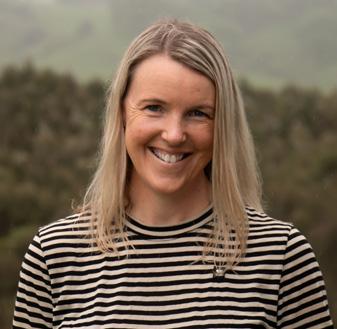
Lactose intolerance is a significant health issue globally, although a lot of people are self-diagnosing. What’s the science behind it, what do we need to understand and how can we help people with less lactase?
Words DR ANNELINE PADAYACHEE: THE FOOD SCIENTIST
Lactose malabsorption (LM) is a significant health issue for many individuals globally. Lactose, the carbohydrate naturally found in dairy products, is essentially unable to be digested and absorbed in the body. This can lead to a range of follow-on digestive discomfort symptoms including bloating and/or diarrhoea. There are a range of health conditions that can lead to lactose malabsorption including coeliac disease, inflammatory bowel disease, irritable bowel disease, but the most common cause is lactose intolerance (LI). In order to understand LI, it’s important to explore what the lactose is and how the human body uses it.
Carbohydrates are split into two groups: simple carbohydrates (or simple sugars) and complex carbohydrates (or starches). The simplest carbohydrates are single molecules like glucose and are called “monosaccharides” (mono meaning one, saccharide meaning carbohydrate unit). Disaccharides (di meaning two) contain two molecules. And then there are the polysaccharides, which are usually large, complex structures with multiple molecules (hence called poly) like starch and dietary fibre. Because complex carbohydrates are large molecules, they take a longer time to digest and break down in the stomach, and can have a slower absorption rate through the small intestine. Simple carbohydrates are the opposite: they are easier to break down and be absorbed because they are smaller and less complex molecules.
Lactose is a disaccharide simple carbohydrate. It is made up of two molecules: glucose and galactose,1 and is naturally present in mammalian milk regardless of maternal dietary intake.2 The average lactose content in cows’ milk is 4.7%, goat 4.7%, sheep 4.6%, camel 4.30%, donkey 6.30%, horse 6.37% while human milk is the highest around 6.3–7%.3, 4 Given milk is the primary food source for infants (human and animals), lactose provides a relatively simple, easy to absorb and use energy source essential for supporting the rapid growth and development.1
The small intestine can only absorb individual carbohydrate molecules. Hence lactose must be split (or hydrolysed) into its individual molecules, i.e. glucose and galactose. Lactase, an enzyme expressed in the small intestine, splits the lactose molecule up allowing for absorption of the individual molecules. In humans, lactase activity is at its highest in a newborn and then progressively decreases after weaning and the introduction of other foods that do not contain lactose. Lactase activity can continue into adulthood in approximately 35% of the global population.2 However this varies between geographical regions, depending on cultural dietary intake and possibly genetics.
For example lactase activity is high in Nordic and European populations (90%) while relatively low in South East Asia (10%).2 The common belief is nomadic tribes in the Fertile Crescent of the Middle East started consuming milk products en masse after storing it in “sacks” made from goat or sheep stomachs. The enzymes remaining in the wall of the stomach partially digested the lactose, making it easier to absorb. Given the nomadic nature of these tribes, some of them took their sheepskin milk bags, travelling to what is now the European continent, building up the body’s lactase production in some population groups while it remains lower in other ethnicities.
Pottery found in archaeological digs in Poland and Hungary date back to 6000 BC and show the presence of milk proteins and fat, indicating very early, rudimentary milk processing.5 But it also highlights the extremely long history of dairy foods being present in certain dietary cultures.
Hence it is believed that lactase persistence is a genetically determined trait, more prevalent in populations with a history of animal herding and milk consumption, particularly European, Middle Eastern, and some African populations.6
After dairy is consumed, it enters the stomach where the highly acidic environment (pH <2.0) unravels proteins, and the mechanical action of the stomach muscles breaks down
the structure of the food further so that it looks like soup. The bulk of lactase is expressed in the small intestinal epithelial cells at the start of the intestine, decreasing further along the 6m long tract.2,7 The hydrolysed molecules – namely glucose and galactose – are then able to be absorbed and are used in a range of functions in the body. While glucose has many roles in the body, it is important to be aware that galactose is only obtainable in the human diet via lactose. Galactose plays various roles regulating metabolism with 80% of it being stored in the liver for energy while then ensuing 20% is used to make lactose in human breast milk and produce amino acids and other molecules (like galactocerebrosides, gangliosides, and mucoproteins) that are used to construct nerve cell membranes.2 These membranes are found wherever nerves are in the body, however given the brain is the largest collection of nerves, adequate galactose is important in infant brain development, and brain function over time.2
The problem with lactose malabsorption, and thus intolerance lies in a lack of lactase enzyme production in the small intestine. Because lactase persistence is higher in some populations than others, the body’s ability to produce lactase is believed to be a genetic trait. The actual mechanisms that govern it are still to be fully understood. The body’s inability to produce lactase can be exacerbated by the presence of other health conditions like coeliac disease, inflammatory bowel disease and irritable bowel disease, but it’s not a hard-fast rule. What we do know is the factors that affect lactose intolerance are: 2,8,9
• The amount of lactose consumed (termed digestive capacity)
• The lactase levels in the small intestine
The rate at which digested food enters the small intestine (too fast, and it can overwhelm the lactase present)
• The structure and integrity of the small intestine villi (where the lactase is produced)
• The health of the gut microbiota
The health and function of the colon.
Lactose that has not been split, and thus absorbed, reaches the colon where the gut bacteria is able to ferment them. This is not necessarily a bad thing, lactose can be a prebiotic to beneficial bacteria, supporting their growth and producing beneficial metabolites.7 However for those who are “intolerant”, pathogenic bacteria can also ferment lactose, producing excess
gas (including hydrogen which doctors measure when diagnosing lactose intolerance) and harmful metabolites. Poor digestion and malabsorption can also cause diarrhoea to develop within 30 minutes – two hours after consumption, abdominal cramps, nausea, excessive burping, abdominal distension, and/or a feeling of fullness even after a small meal.2,8,9
It is believed that lactase persistence is a genetically determined trait, more prevalent in populations with a history of animal herding and milk consumption.
Given the range of symptoms are quite common, it could be easy to self-diagnose. It cannot be stressed enough that lactose intolerance should be diagnosed by a healthcare provider. It may simply be a lack of lactase due to a cold or flu, or consuming too much dairy in one meal, or there could be more serious underlying health issues and the lactose intolerance is a symptom of that. The most common dietary strategies include consuming lactase enzyme which is usually available in most pharmacies, consuming lactose-free (the lactose has been pre-split) products or alternative products. Lactose in the form of dairy has a long history in human diet and health, and for a large part has helped ancient populations survive and grow leading to who we are now. The adaptability of the human digestive tract and genetic traits, the gut microbiome, and the time food takes to transit through the digestive tract is being explored in greater detail. The more we know, the better we can help those with less lactase.

Dr Anneline Padayachee has a PhD in nutritional food science, is a professional member of the Nutrition Society of Australia and a Fellow of the Australian Institute of Food Science and Technology (AIFST) and sits on the Australian Academy of Science’s National committees for Nutrition and Agriculture and Food.
1. Qi, X. and Tester, R.F., Lactose, maltose, and sucrose in health and disease. Molecular nutrition & food research, 2020. 64(8): p. 1901082.
2. Del Carmen Tocaa, M., et al., Lactose intolerance: myths and facts. An update. Arch. Argent. Pediatr, 2022. 120(1): p. 59–66.
3. Siddiqui, S.A., et al., Physicochemical and nutritional properties of different non-bovine milk and dairy products: A review. International Dairy Journal, 2024. 148: p. 105790.
4. Nayak, C., Ramachandra, C., and Kumar, G., A Comprehensive Review on Composition of Donkey Milk in Comparison to Human, Cow, Buffalo, Sheep, Goat, Camel and Horse Milk. Mysore Journal of Agricultural Sciences, 2020. 54(3).
5. Evans, M., et al., Detection of dairy products from multiple taxa in Late Neolithic pottery from Poland: an integrated biomolecular approach. Royal Society open science, 2023. 10(3): p. 230124.
6. Campbell, M.C. and Ranciaro, A., Human adaptation, demography and cattle domestication: an overview of the complexity of lactase persistence in Africa. Human Molecular Genetics, 2021. 30(R1): p. R98–R109.
7. Forsgård, R.A., Lactose digestion in humans: intestinal lactase appears to be constitutive whereas the colonic microbiome is adaptable. The American journal of clinical nutrition, 2019. 110(2): p. 273–279.
8. Di Costanzo, M. and Canani, R.B., Lactose intolerance: common misunderstandings. Annals of Nutrition and Metabolism, 2018. 73(4): p. 30–37.
9. Katoch, G.K., et al., Lactose intolerance and its dietary management: an update. Journal of the American Nutrition Association, 2022. 41(4): p. 424–434.
































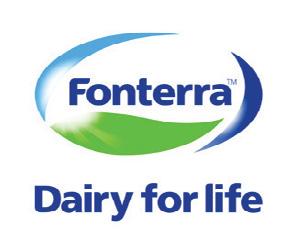











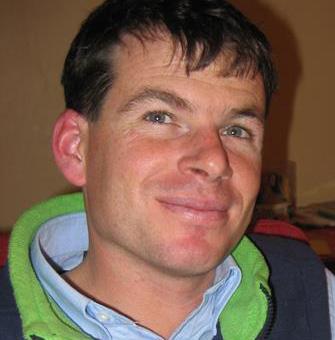
At the moment, DairyNZ, our farmer industry good body is going through some major changes. Change is a risky business, but staying the same is also a risky business.
A long time ago I worked for Dexcel as a consulting officer (CO) on the West Coast for five years. Dexcel changed its name to DairyNZ. I still had some farmers at the end of my time at the CO service associating us with the Dairy Board and MAF, neither of which we had been involved with for years. It is interesting how a strong brand that had had a major influence on people’s lives gets stuck as the brand that it was. Your customers own your brand.
We had a small South Island team of five areas that during the dairy expansion extended to six with the inclusion of Otago. I had the pleasure of working with some amazing people that were true leaders in the industry all doing it as a sense of duty, as the pay was average.
We ran a split approach to delivery, the bulk being geographic discussion groups where I would run up to five a week, with the aim of running one per area every six weeks. Sometimes these groups would go well, some were hard, sometimes all the farmers wanted to do was talk to each other. Now that I am farming, I understand the need to connect with other farmers in a hard spring or a drought – you just need to know that you are not the only one.
We also ran a high-quality larger group model with the use of scientists, speakers and COs from other areas. These were high quality and well attended.
Richard Reynolds reflects on his time as a farm consultant and questions DairyNZ’s new strategy to meet farmer needs.
The job was hard on staff with five years being long service and most lasting fewer than three. Travel in cars ranged from about 30,000km a year for Canterbury to my best of 70,000km a year. Things needed to change.
As such all COs were called to a meeting in Huntly and the grand new plan was unveiled. We were to survey all our farmers and put them into four categories – inventors, early adopters, followers and laggards. We were to only work with early adopters and at a push inventors and followers. While doing this survey for six months, the farmers would have such a built-up demand for our service that when we came back they would be like ravenous dogs for our service and fall in line with the new model.
The presentation went bad – really bad. Crying, walking out, yelling and even questioning, “Has this been tried?” – “No, but we think it will work and we are going to do it, so off you go.”
The first thing that happened was that all the best people resigned. Your best people are all volunteers – they volunteer to work with you, they have options and can leave at any time (I stayed). After a year we were back to doing what we had been doing beforehand, with less farmer trust and a younger, lesser-skilled team.
Present-day DairyNZ has tried one transformation of its delivery model which failed dismally. Some of the created positions made no sense and could not be explained. The best example was the farm engagement officer who was meant to only rock up to farmers that
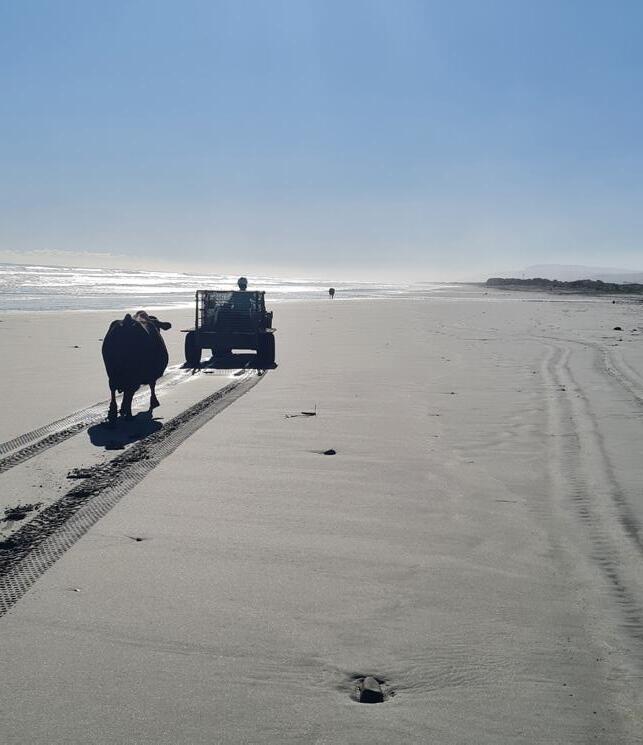
had no contact with DairyNZ and say, “Hi, I am here to help you.” This provided two options: a) The farmer says, “You are useless, piss off,” proving their perceived opinion of the farmer right; or b) “God am I glad to see you! I have major problems, can you help?” where they provide them with pamphlets and phone numbers, then buggered off.
The new strategy of fewer events but bigger and better events is risky. Your brand is at a low level, you will be measured by your last event, so when it finally happens it had better be good.
My worst turnout to a group was zero. It had been raining for weeks and this was the first sunny period, all the farmers were on tractors making hay. I was there to serve farmers; I had no right to expect them to turn up. Good luck with your new approach.

As we head into what promises to be a productive spring, there’s more good news on the horizon. Milk payout is starting to look up, cows are in excellent condition, and mating season is just around the corner. With so much in your favour, it’s time to make the most of this period on your farm.
The calves are growing well. I used milk powder this year after calculating that above $7.50 milk payout, the benefit for milk powder vs milk from the vat that we can supply to Fonterra was in milk powder’s favour.
Many Taranaki farmers are reporting their cows are in good condition this season, thanks to improved pasture growth and favourable weather conditions. This can be dependent on where you are around the mountain; we have plenty of grass here in Ōpunake but further north, they are reporting a shortage. One thing is certain though –more sunshine is needed.
Healthy cows mean higher productivity, better milk quality, and improved reproductive performance as we move towards mating season. Did you know that fatter cows at calving are more likely to produce a heifer calf the following year? Every unit increase in body condition score (BCS) at calving increases the probability of a heifer calf next season by approximately 5%. This is likely because cows below their target BCS at calving (say at BCS 4) will drop less condition than cows calving at their target BCS (5 for mature cows). The change in BCS seems to be a factor in determining calf gender.
The sun is finally out! Trish Rankin says it’s time to optimise their farm for the season.
One thing we do to stay on top of our BCS for our herd is to use the WelFarm programme which means our vets come and do BCS at key times of the year. Our use of WelFarm was something we started about four years ago. It was a no-brainer for us, as having a relationship with our vets beyond just visiting us when there were sick animals and more as part of our team was something we were looking for. Which raises the questions that we can all ask ourselves: What tools do you need for key decision making? How often do you review these? What is new on the market to help you make decisions?
On our farm we always start by asking ourselves, what is the problem we are trying to solve by using a tool? I know for us this year we want to improve pasture management. With the phasing out of using our quad and an older tow-behind pasture meter, we are looking at what new tools there are in the pasture management space. And the key is that we don’t try and use too many new tools all at once! Watch this space as to what we do!

I also like the farmer-designed “problems solved by farmers” type tools! Recently at our Dairy Women’s Network Taranaki Business Group meeting, we heard from Jody McCaig at Practical Compliance about “Smart Sign In” where visitors scan a QR code, they are taken to a sign-in page where they can be made aware of hazards/maps, etc. and then they sign. The manager/owner then gets a text to say that someone has arrived and how long they will be on the farm for. Even better is that if the visitor hasn’t signed off in the time allocated, the manager/owner gets a text to check on that person. Not expensive, not another app to download but highly functional! On the family front, after missing out on the win in the finals of the Taranaki Secondary School rugby champs last year, Ōpunake High took the win this year. Harry who is Year 13 was pretty stoked for this as was Glen who helped coach. Grandad was there to watch, making three generations there and memories made.

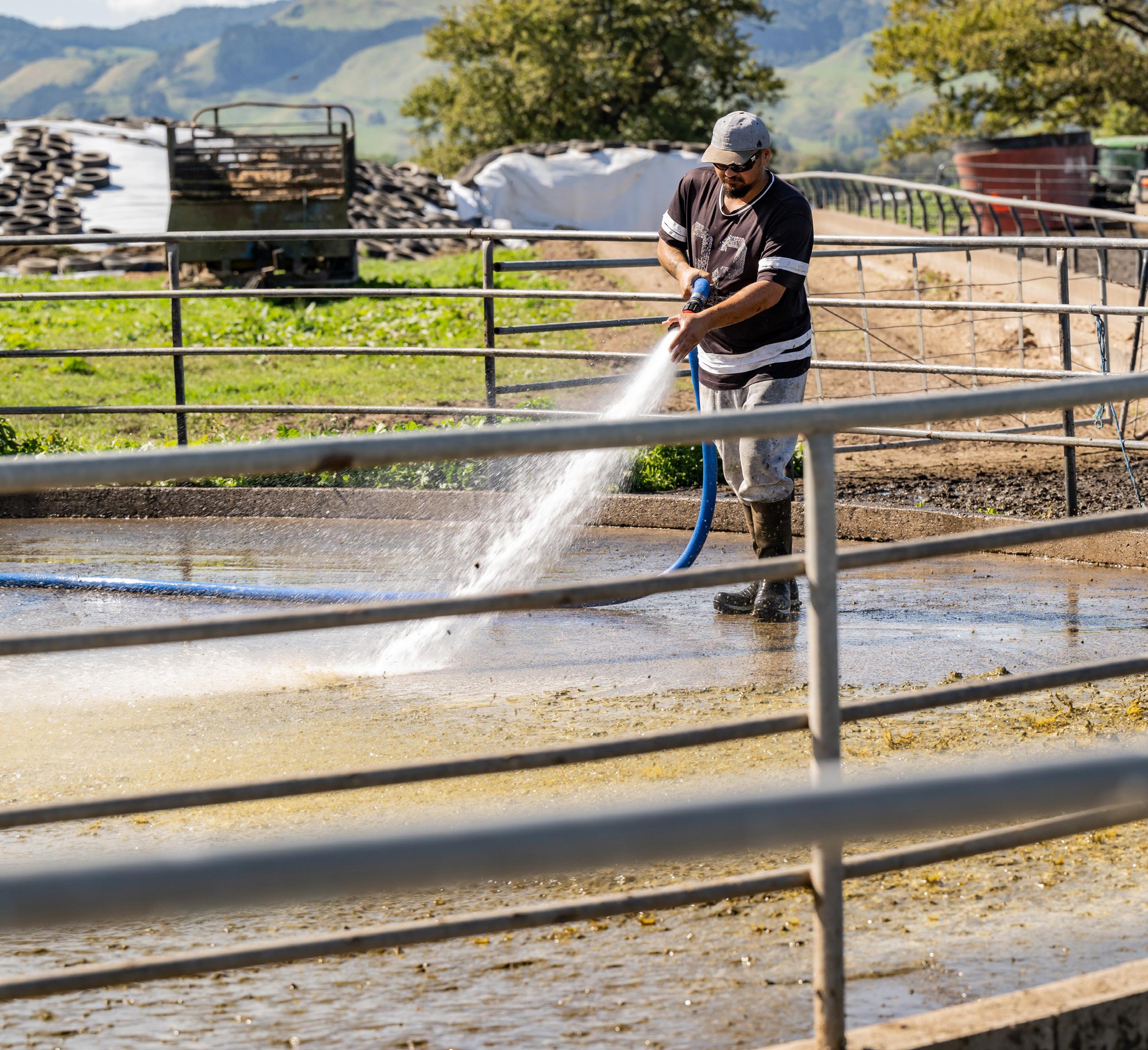
Primary ITO is excited to launch the Level 4 Effluent and Waste Management micro-credential - a dedicated piece of learning that gives staff the knowledge to safely and effectively manage effluent and farm waste.
Topics covered include:
• Improving health and safety for people on farm both when handling waste and when dealing with effluent.
• Decreasing the amount of waste generated through principles such as reduce, reuse and recycle.
• Improving nutrient reuse on farm through efficient use of existing on-farm infrastructure.
• Developing a clear Effluent Management Plan that includes local bylaws relevant to where the farm is located.
• Animal health, water and air quality and greenhouse gas emissions related to effluent management.
To register your interest, or to find out about our other programmes, visit primaryito.ac.nz, phone 0800 20 80 20 or email info@primaryito.ac.nz.

